
Baltic Splendor: Stockholm to Copenhagen
Baltic Splendor: Stockholm to Copenhagen
Cruise overview
WHY BOOK WITH US?
- ✔ The Deluxe Cruises’ team has extensive experience in ultra-luxury cruising.
- ✔ Call now to speak to our helpful and experienced Cruise Concierge team.
- ✔ Enjoy our Unique Deluxe Cruises Bonus for substantial savings.
- ✔ Our team will tailor your holiday to your exacting requirements.
- ✔ As agents, we work under the protection of each cruise lines ABTA / ATOL licences
About Stockholm
Stockholm is a city in the flush of its second youth. Since the mid-1990s, Sweden's capital has emerged from its cold, Nordic shadow to take the stage as a truly international city. What started with entry into the European Union in 1995 gained pace with the extraordinary IT boom of the late 1990s, strengthened with the Skype-led IT second wave of 2003, and solidified with the hedge-fund invasion that is still happening today as Stockholm gains even more global confidence. And despite more recent economic turmoil, Stockholm's 1 million or so inhabitants have, almost as one, realized that their city is one to rival Paris, London, New York, or any other great metropolis.With this realization comes change. Stockholm has become a city of design, fashion, innovation, technology, and world-class food, pairing homegrown talent with an international outlook. The streets are flowing with a young and confident population keen to drink in everything the city has to offer. The glittering feeling of optimism, success, and living in the here and now is rampant in Stockholm.Stockholm also has plenty of history. Positioned where the waters of Lake Mälaren rush into the Baltic, it’s been an important trading site and a wealthy international city for centuries. Built on 14 islands joined by bridges crossing open bays and narrow channels, Stockholm boasts the story of its history in its glorious medieval old town, grand palaces, ancient churches, sturdy edifices, public parks, and 19th-century museums—its history is soaked into the very fabric of its airy boulevards, built as a public display of trading glory.
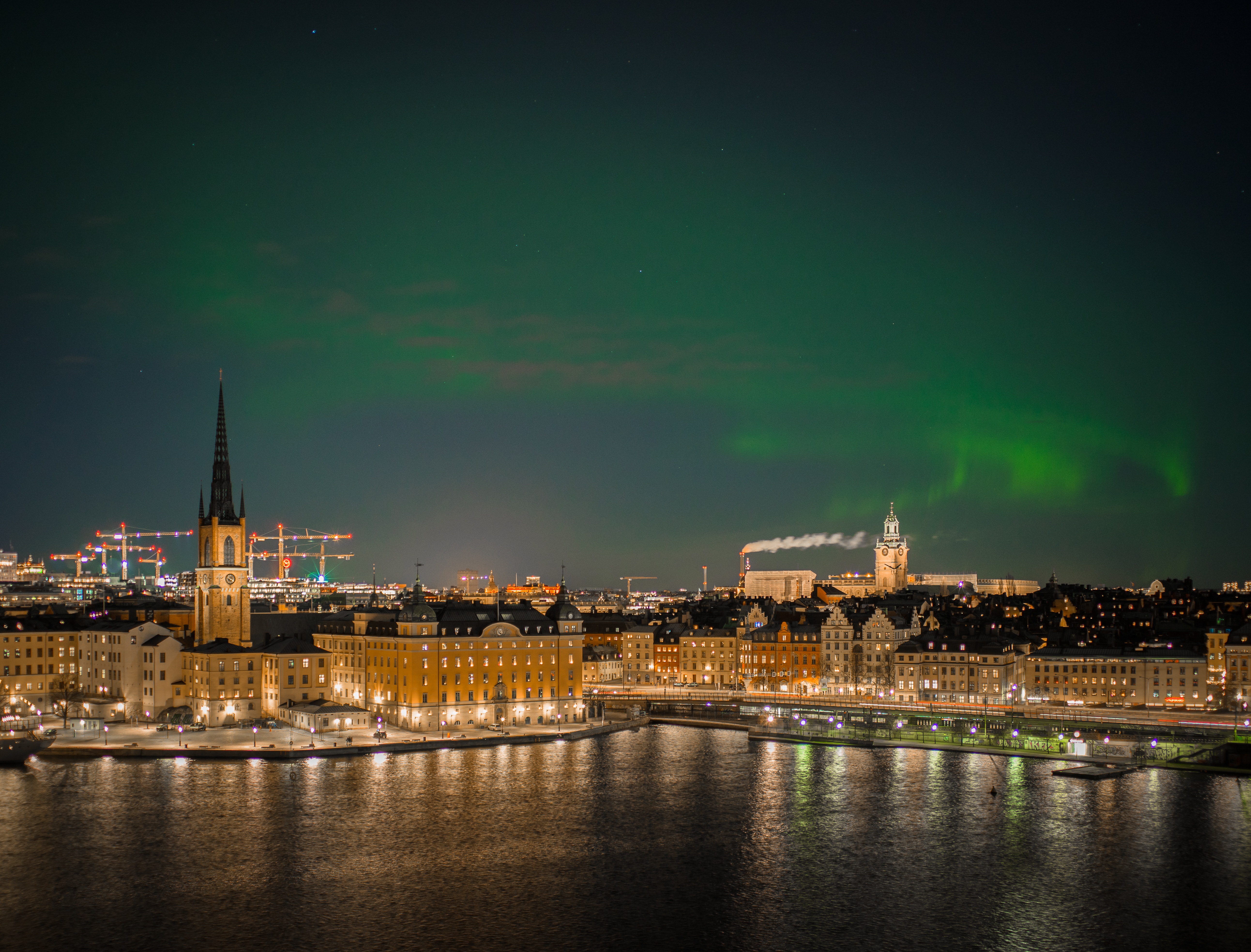
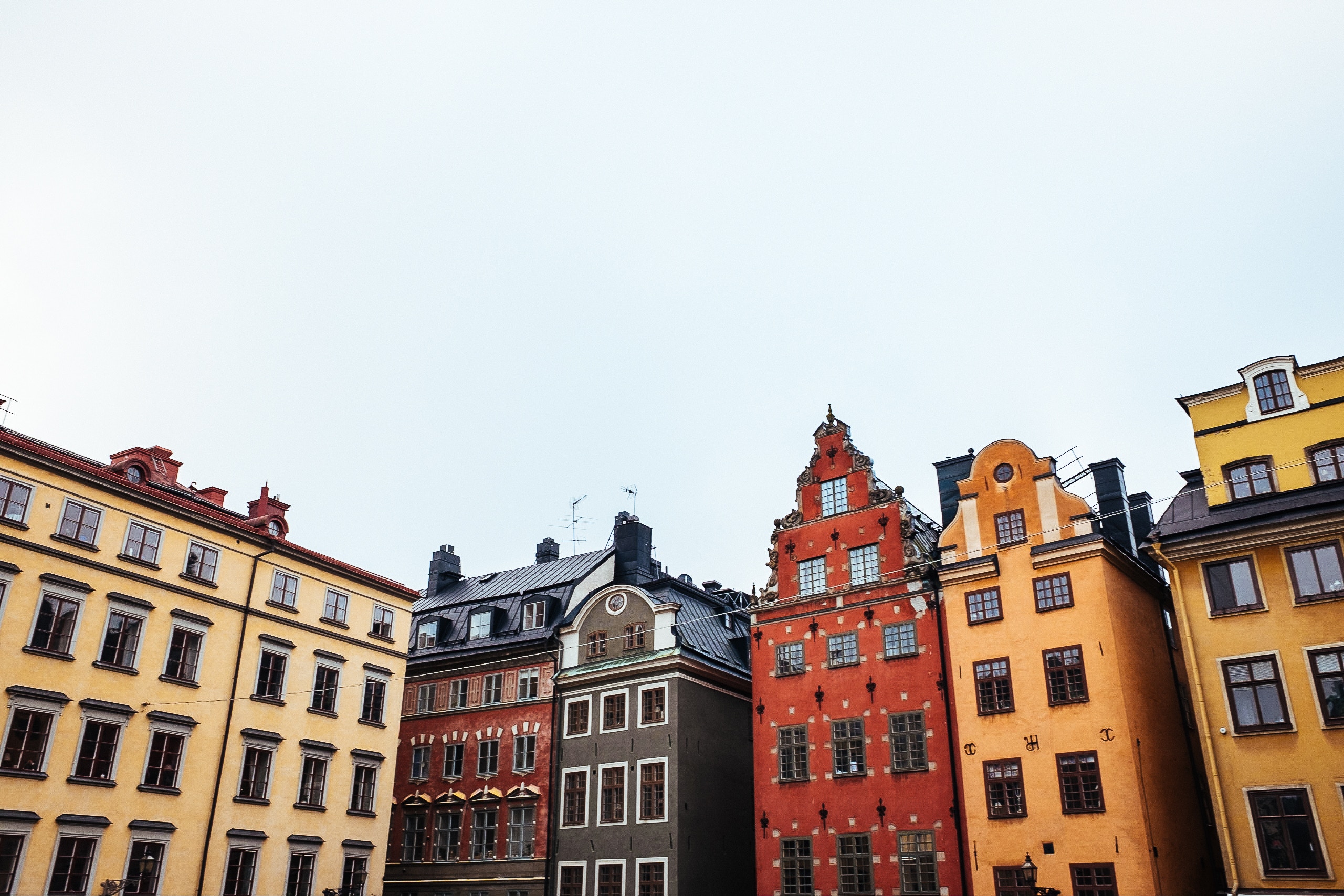
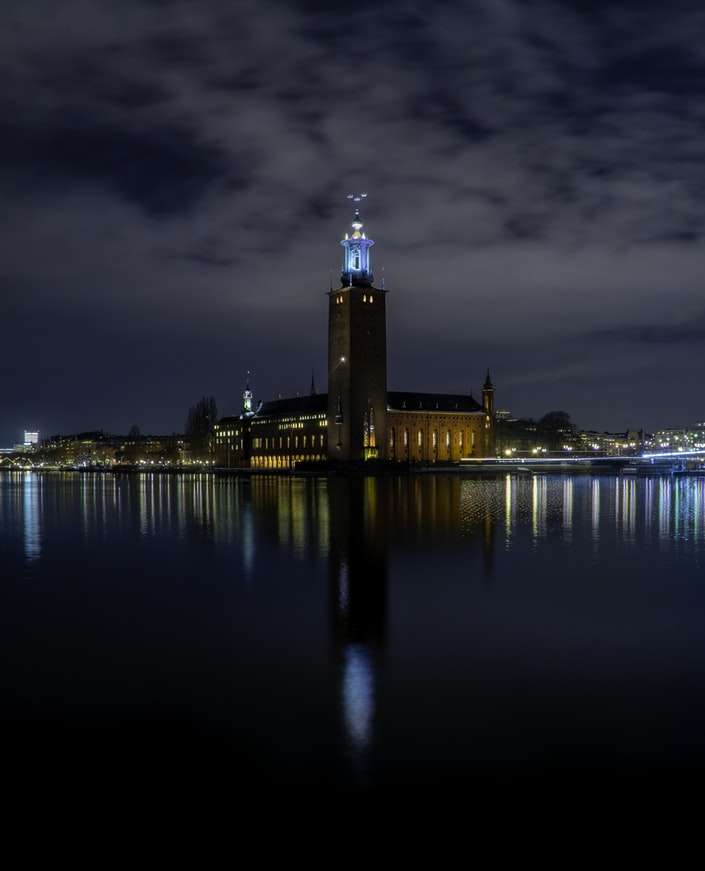
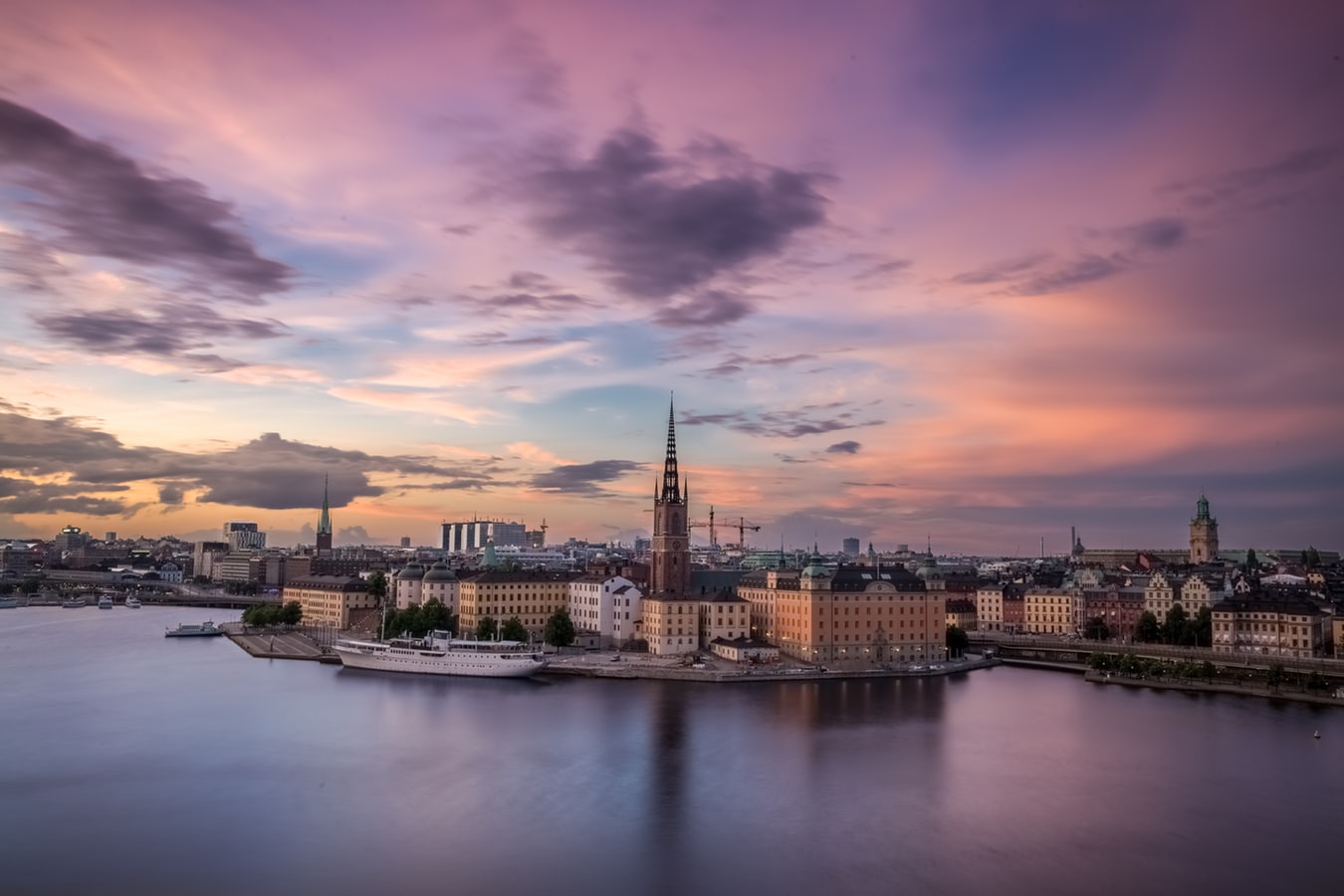
About Stockholm
Stockholm is a city in the flush of its second youth. Since the mid-1990s, Sweden's capital has emerged from its cold, Nordic shadow to take the stage as a truly international city. What started with entry into the European Union in 1995 gained pace with the extraordinary IT boom of the late 1990s, strengthened with the Skype-led IT second wave of 2003, and solidified with the hedge-fund invasion that is still happening today as Stockholm gains even more global confidence. And despite more recent economic turmoil, Stockholm's 1 million or so inhabitants have, almost as one, realized that their city is one to rival Paris, London, New York, or any other great metropolis.With this realization comes change. Stockholm has become a city of design, fashion, innovation, technology, and world-class food, pairing homegrown talent with an international outlook. The streets are flowing with a young and confident population keen to drink in everything the city has to offer. The glittering feeling of optimism, success, and living in the here and now is rampant in Stockholm.Stockholm also has plenty of history. Positioned where the waters of Lake Mälaren rush into the Baltic, it’s been an important trading site and a wealthy international city for centuries. Built on 14 islands joined by bridges crossing open bays and narrow channels, Stockholm boasts the story of its history in its glorious medieval old town, grand palaces, ancient churches, sturdy edifices, public parks, and 19th-century museums—its history is soaked into the very fabric of its airy boulevards, built as a public display of trading glory.




About Tallinn
Estonia's history is sprinkled liberally with long stretches of foreign domination, beginning in 1219 with the Danes, followed without interruption by the Germans, Swedes, and Russians. Only after World War I, with Russia in revolutionary wreckage, was Estonia able to declare its independence. Shortly before World War II, in 1940, that independence was usurped by the Soviets, who—save for a brief three-year occupation by Hitler's Nazis—proceeded to suppress all forms of national Estonian pride for the next 50 years. Estonia finally regained independence in 1991. In the early 1990s, Estonia's own Riigikogu (Parliament), not some other nation's puppet ruler, handed down from the Upper City reforms that forced Estonia to blaze its post-Soviet trail to the European Union. Estonia has been a member of the EU since 2004, and in 2011, the country and its growing economy joined the Eurozone. Tallinn was also named the European City of Culture in 2011, cementing its growing reputation as a cultural hot spot.
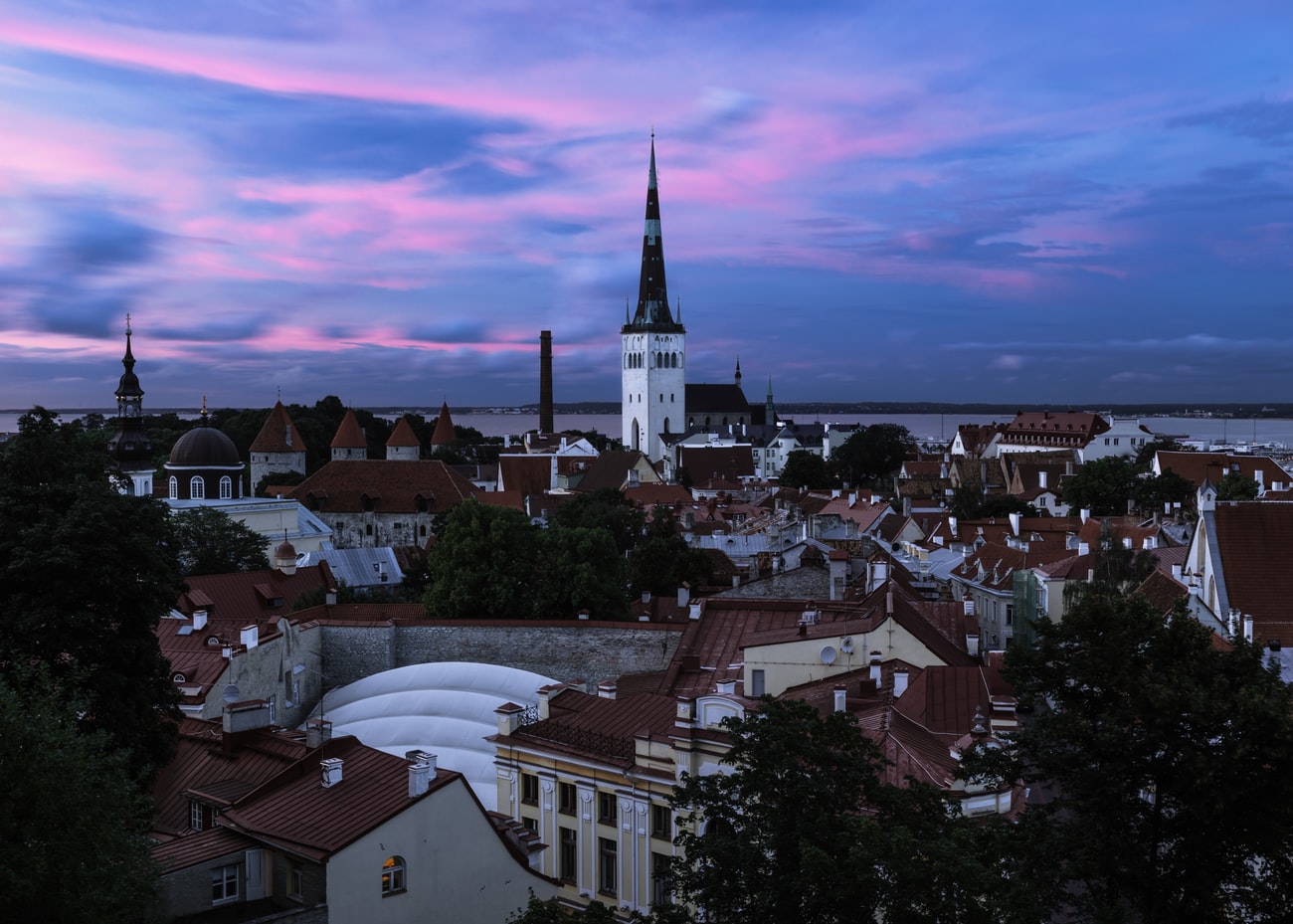
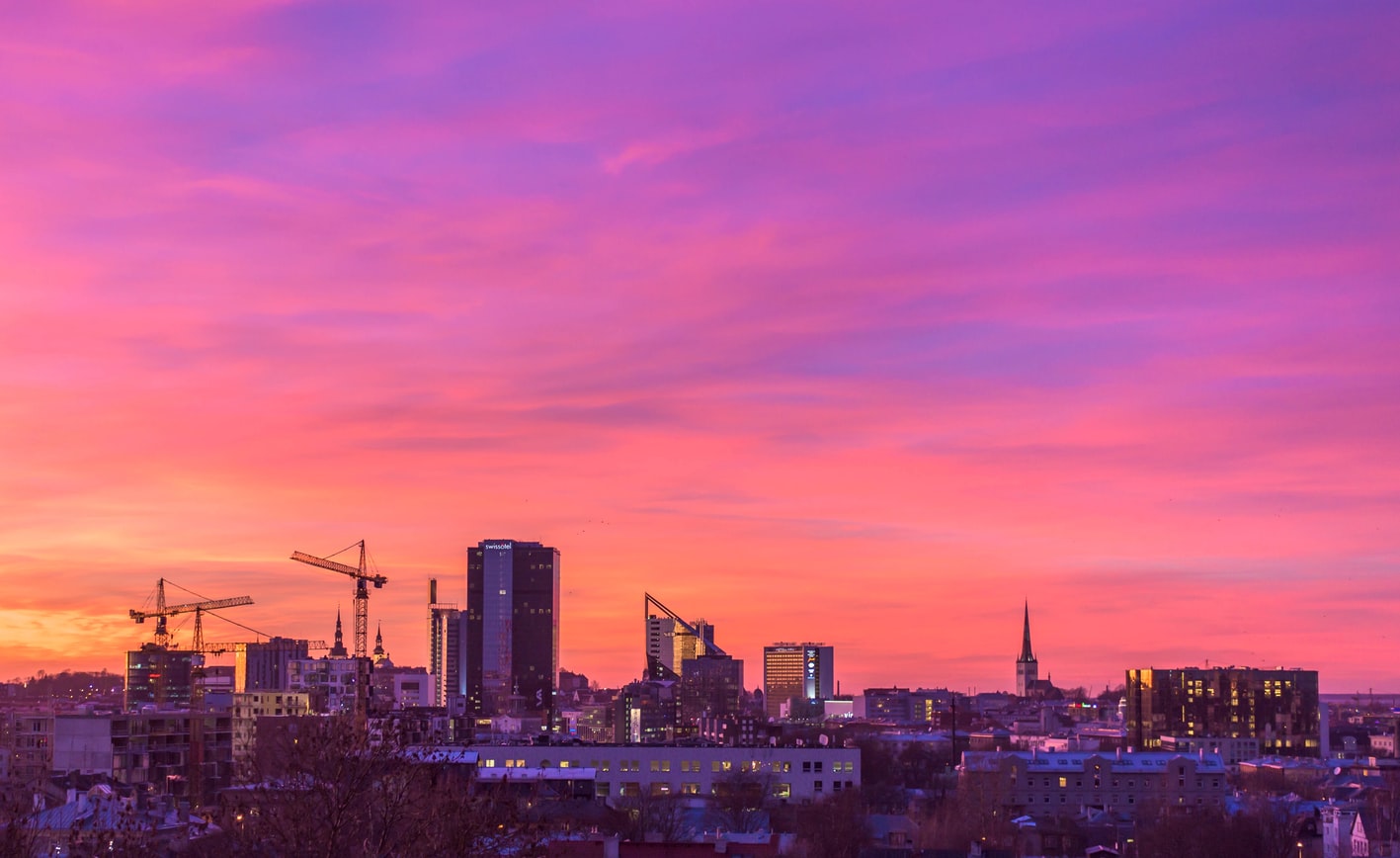
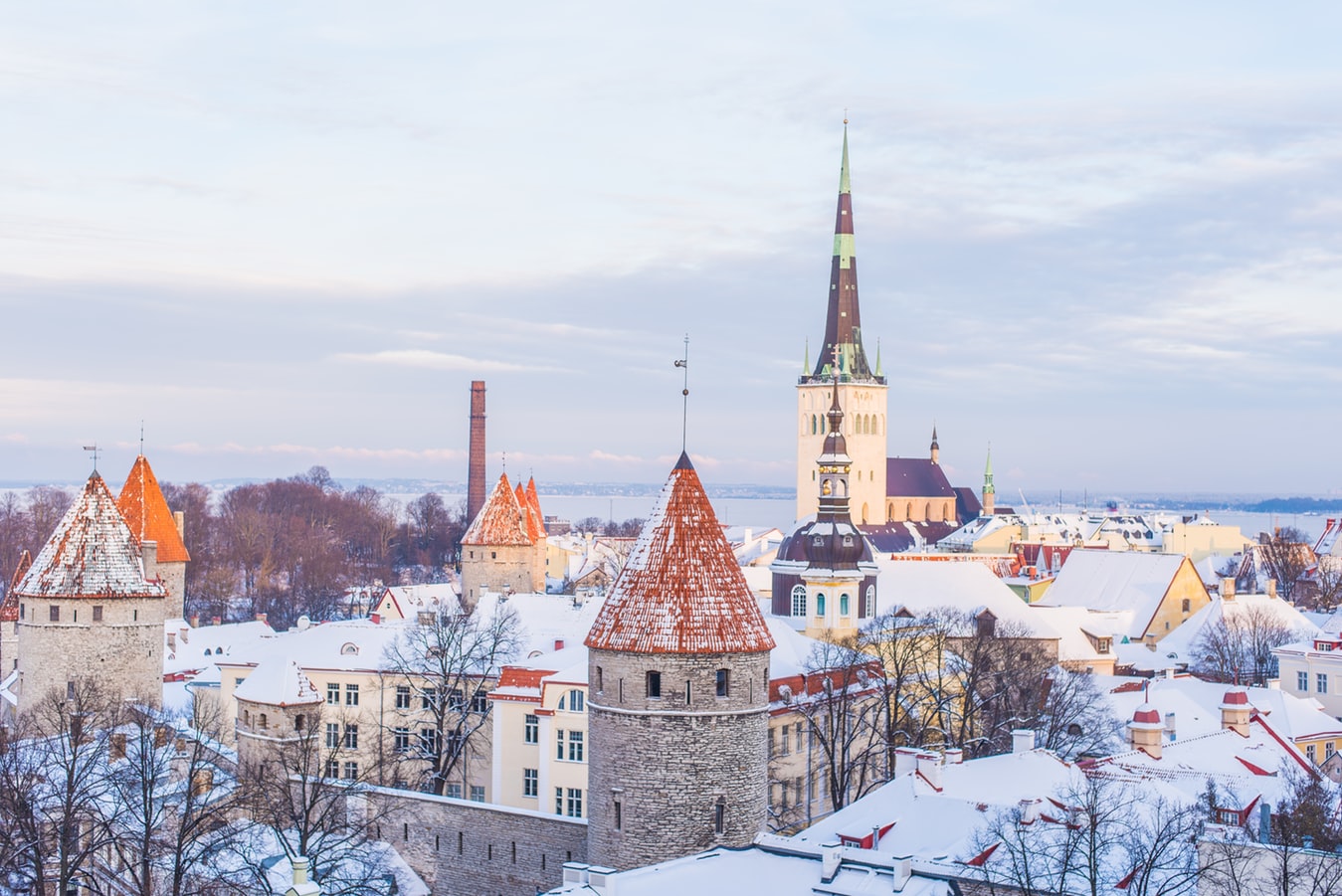
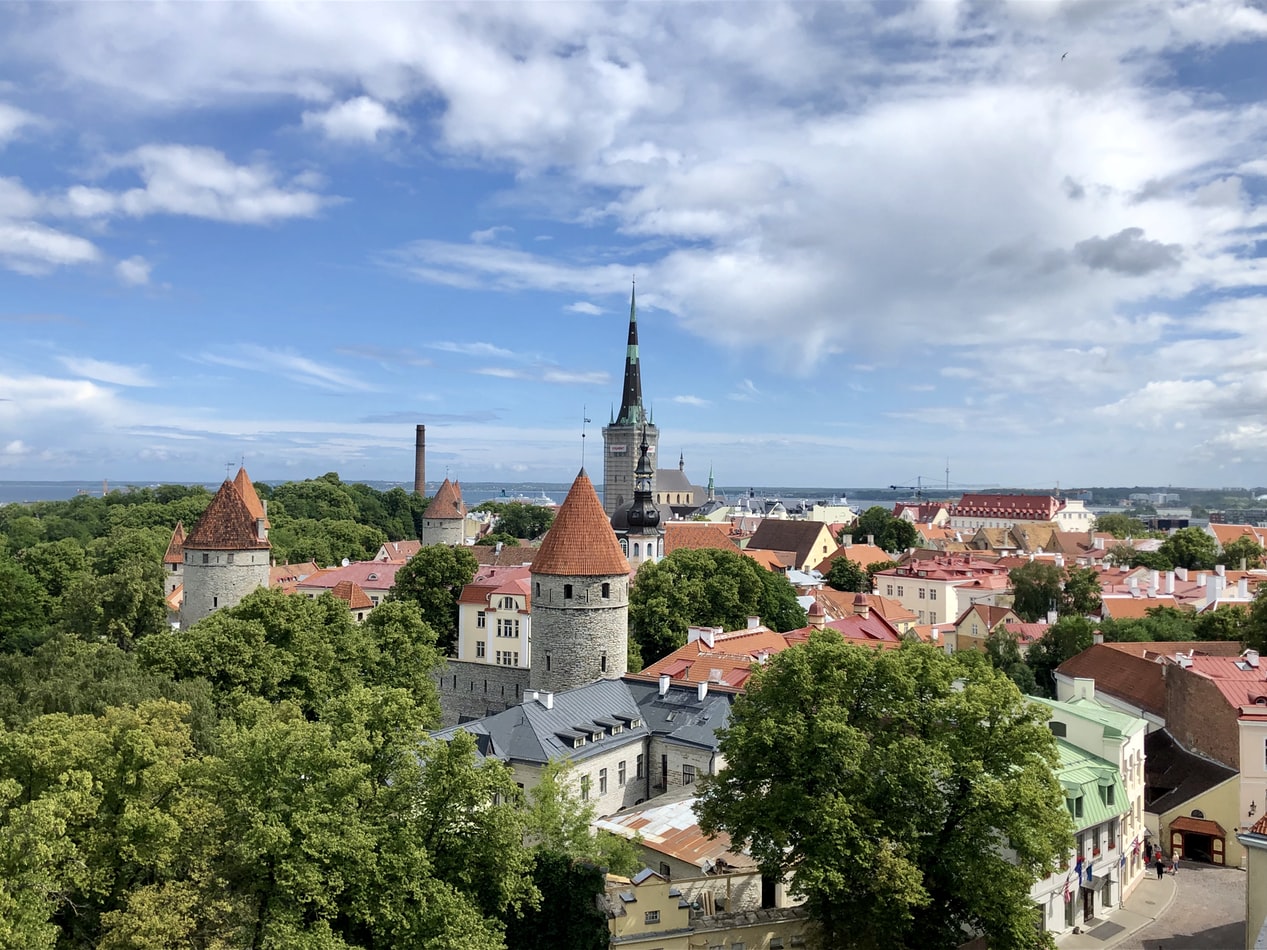
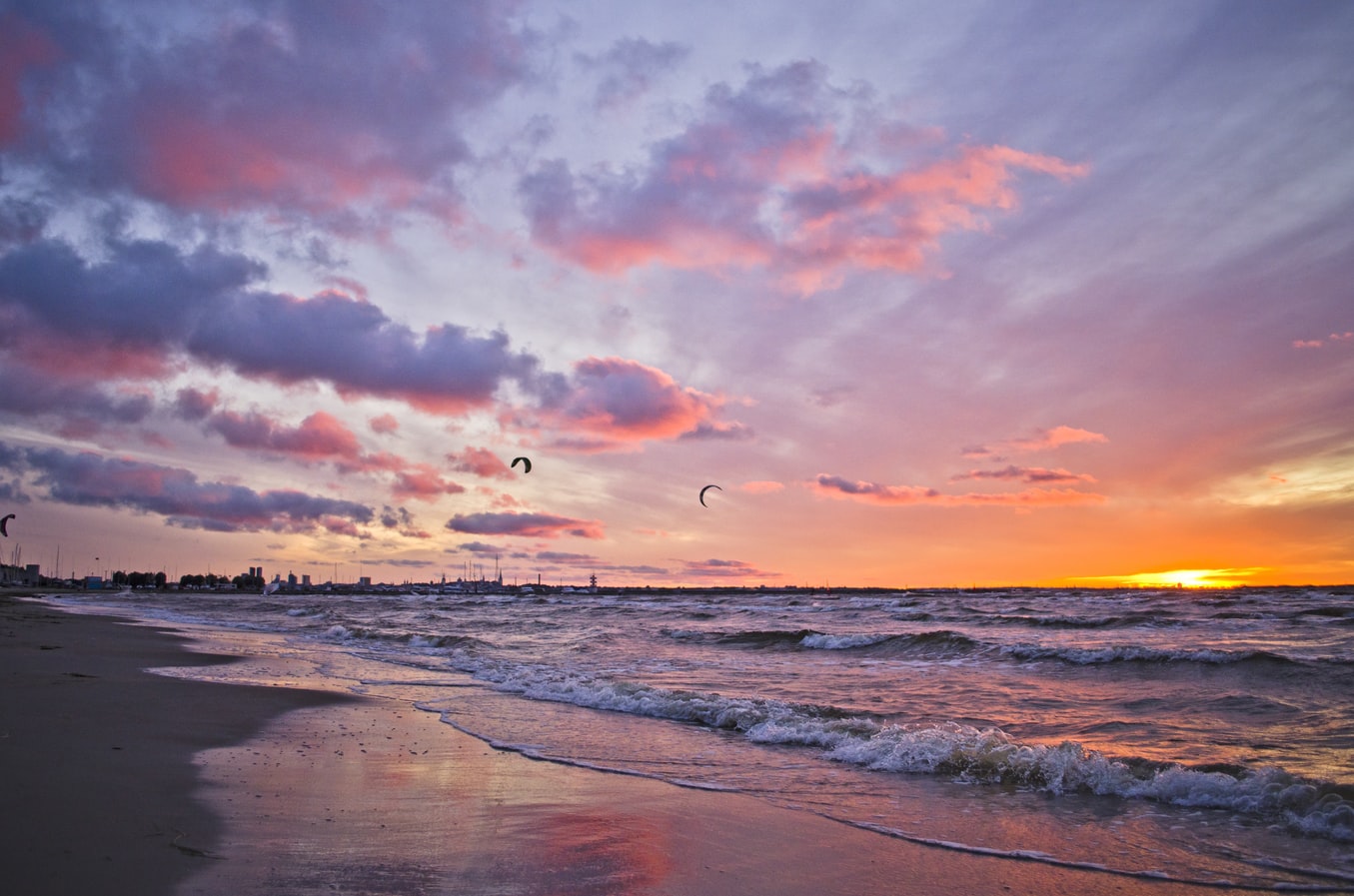
About Helsinki
A city of the sea, Helsinki was built along a series of oddly shaped peninsulas and islands jutting into the Baltic coast along the Gulf of Finland. Streets and avenues curve around bays, bridges reach to nearby islands, and ferries ply among offshore islands.Having grown dramatically since World War II, Helsinki now absorbs more than one-tenth of the Finnish population. The metro area covers 764 square km (474 square miles) and 315 islands. Most sights, hotels, and restaurants cluster on one peninsula, forming a compact central hub. The greater Helsinki metropolitan area, which includes Espoo and Vantaa, has a total population of more than a million people.Helsinki is a relatively young city compared with other European capitals. In the 16th century, King Gustav Vasa of Sweden decided to woo trade from the Estonian city of Tallinn and thus challenge the Hanseatic League's monopoly on Baltic trade. Accordingly, he commanded the people of four Finnish towns to pack up their belongings and relocate to the rapids on the River Vantaa. The new town, founded on June 12, 1550, was named Helsinki.For three centuries, Helsinki (Helsingfors in Swedish) had its ups and downs as a trading town. Turku, to the west, remained Finland's capital and intellectual center. However, Helsinki's fortunes improved when Finland fell under Russian rule as an autonomous grand duchy. Czar Alexander I wanted Finland's political center closer to Russia and, in 1812, selected Helsinki as the new capital. Shortly afterward, Turku suffered a disastrous fire, forcing the university to move to Helsinki. The town's future was secure.Just before the czar's proclamation, a fire destroyed many of Helsinki's traditional wooden structures, precipitating the construction of new buildings suitable for a nation's capital. The German-born architect Carl Ludvig Engel was commissioned to rebuild the city, and as a result, Helsinki has some of the purest neoclassical architecture in the world. Add to this foundation the influence of Stockholm and St. Petersburg with the local inspiration of 20th-century Finnish design, and the result is a European capital city that is as architecturally eye-catching as it is distinct from other Scandinavian capitals. You are bound to discover endless engaging details—a grimacing gargoyle; a foursome of males supporting a balcony's weight on their shoulders; a building painted in striking colors with contrasting flowers in the windows. The city's 400 or so parks make it particularly inviting in summer.Today, Helsinki is still a meeting point of eastern and western Europe, which is reflected in its cosmopolitan image, the influx of Russians and Estonians, and generally multilingual population. Outdoor summer bars ("terrassit" as the locals call them) and cafés in the city center are perfect for people watching on a summer afternoon.
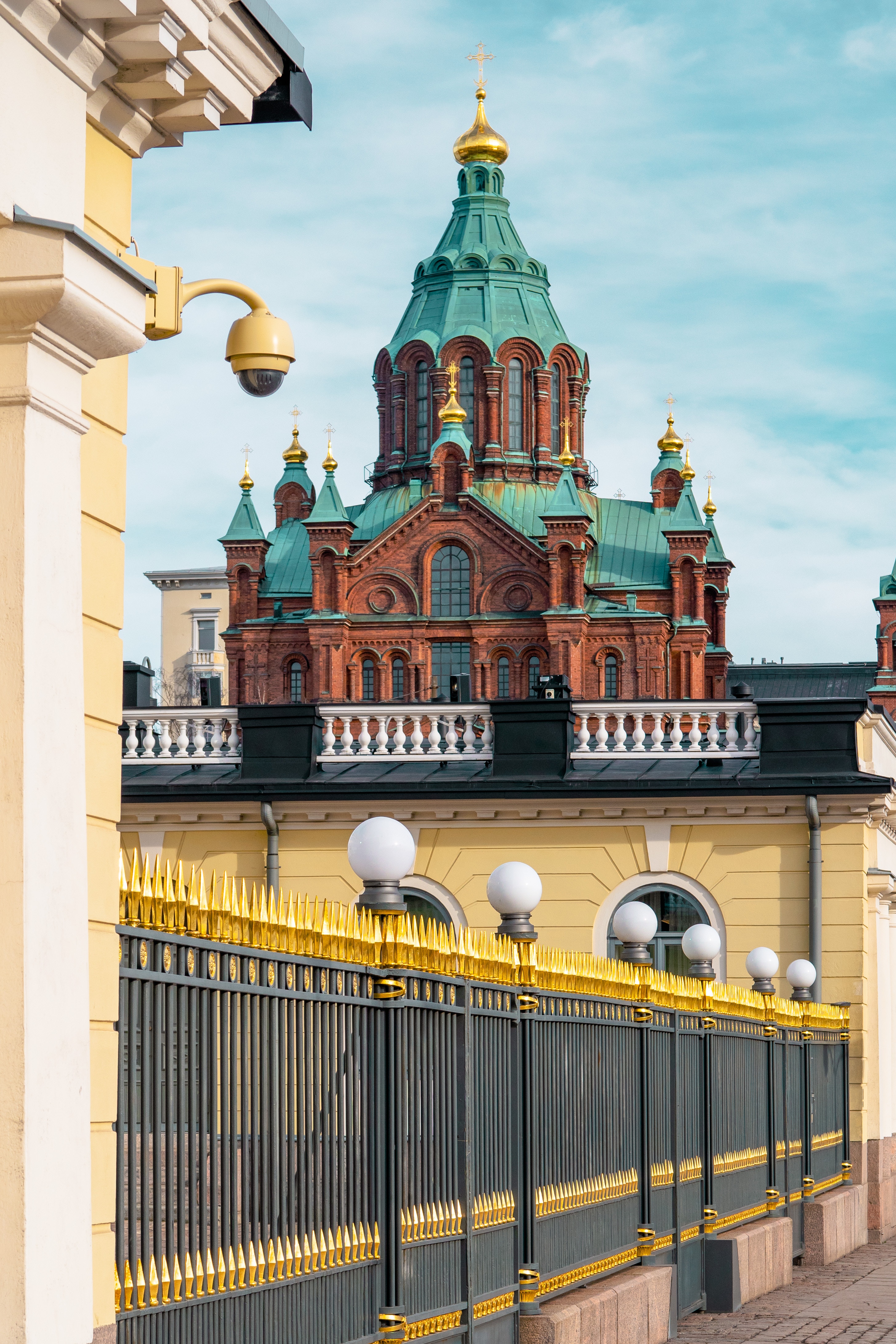
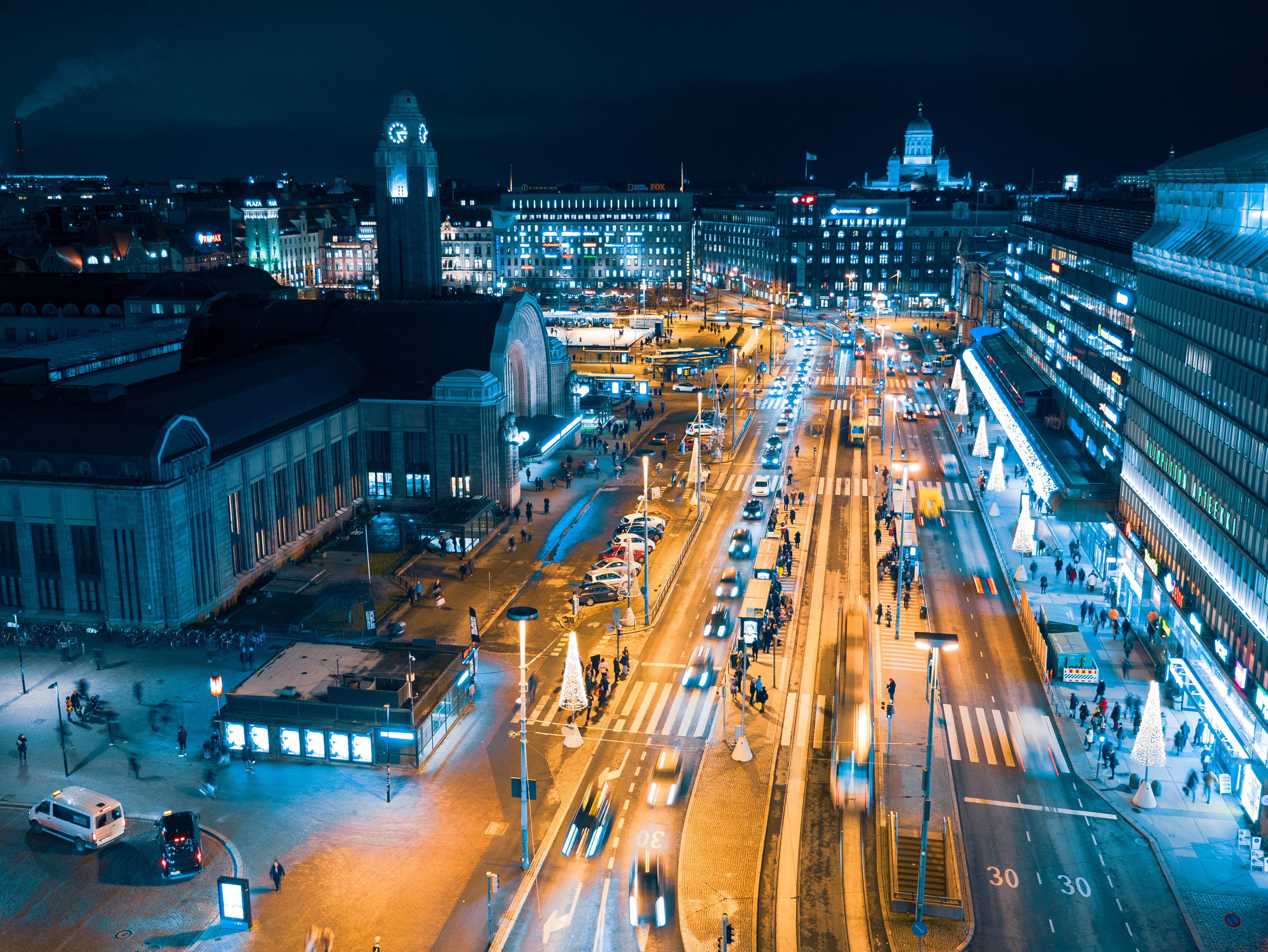
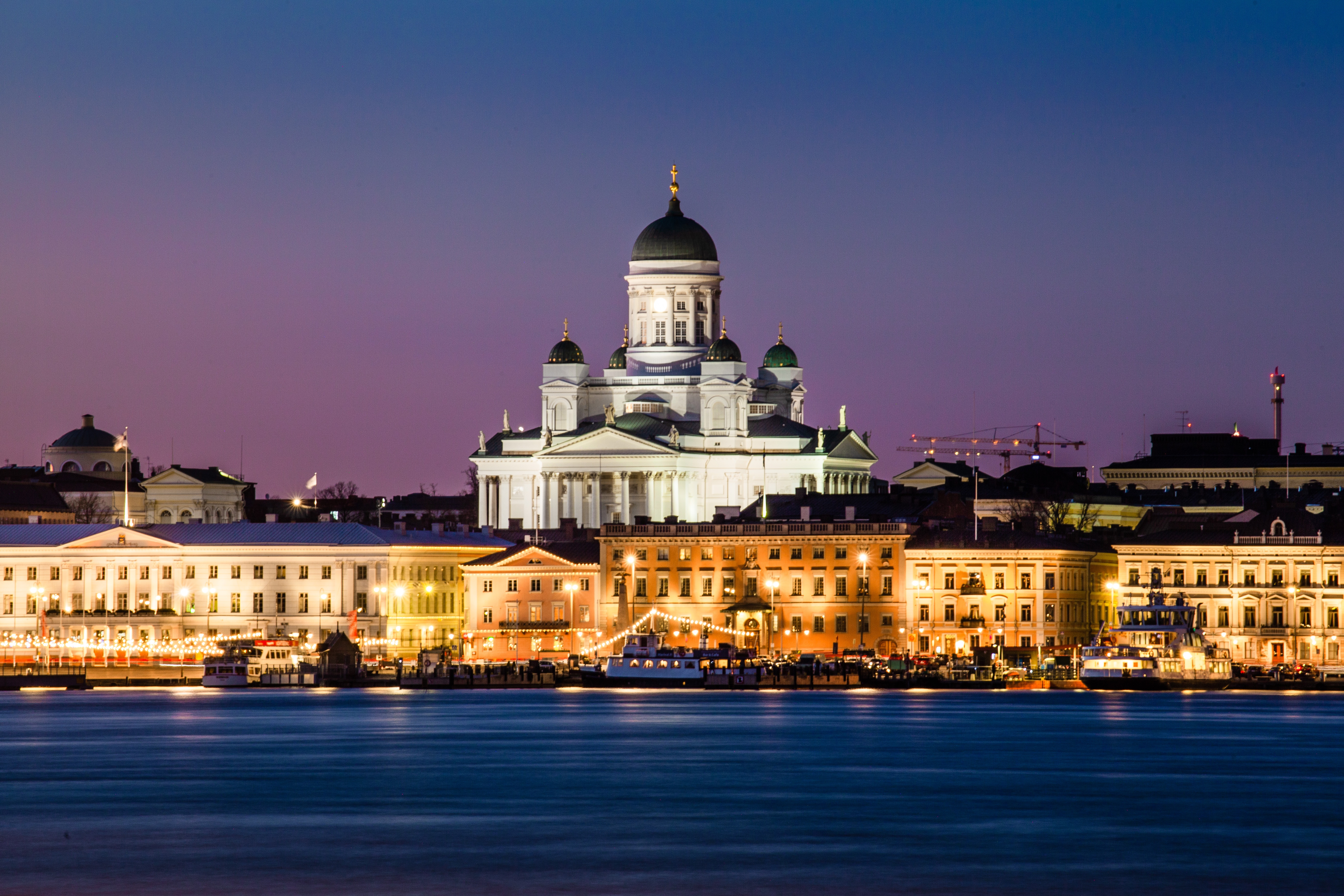
About Riga
Rīga has an upscale, big-city feel unmatched in the region. The capital (almost as large as Tallinn and Vilnius combined) is the business center of the area while original, high-quality restaurants and hotels have earned Rīga some bragging rights among its Western European counterparts. The city also doesn't lack for beauty—Rīga's Old Town (now a UNESCO World Heritage site) is one of Europe’s most striking examples of the art nouveau architectural style. Long avenues of complex and sometimes whimsical Jugendstil facades hint at Rīga's grand past. Many were designed by Mikhail Eisenstein, the father of Soviet director Sergei. This style dominates the city center. In many ways, the wonder of Rīga resides less in its individual attractions and more in the fabric of the town itself. In the medieval Old Town, an ornate gable or architrave catches the eye at every turn. The somber and the flamboyant are both represented in this quarter's 1,000 years of architectural history. Don't hesitate to just follow where your desire leads—the Old Town is compact and bounded by canals, so it's difficult to get totally lost. When the Old Town eventually became too crowded, the city burst out into the newer inner suburbs. The rich could afford to leave and build themselves fine fashionable mansions in the style of the day; consequently, city planners created a whole new Rīga. Across the narrow canal, you'll find the Esplanāde, a vast expanse of parkland with formal gardens and period mansions where the well-heeled stroll and play. Surrounding this is the art nouveau district. Encompassing avenues of splendid family homes (now spruced up in the postcommunist era), the collection has been praised by UNESCO as Europe's finest in the art nouveau style. The best examples are at Alberta 2, 2a, 4, 6, 8, and 13; Elizabetes 10b; and Strēlnieku 4a. If the weather permits, eschew public transport and stroll between the two districts, taking in the varied skylines and multifaceted facades, and perhaps stopping at a café or two as you go. The city has churches in five Christian denominations and more than 50 museums, many of which cater to eclectic or specialist tastes.
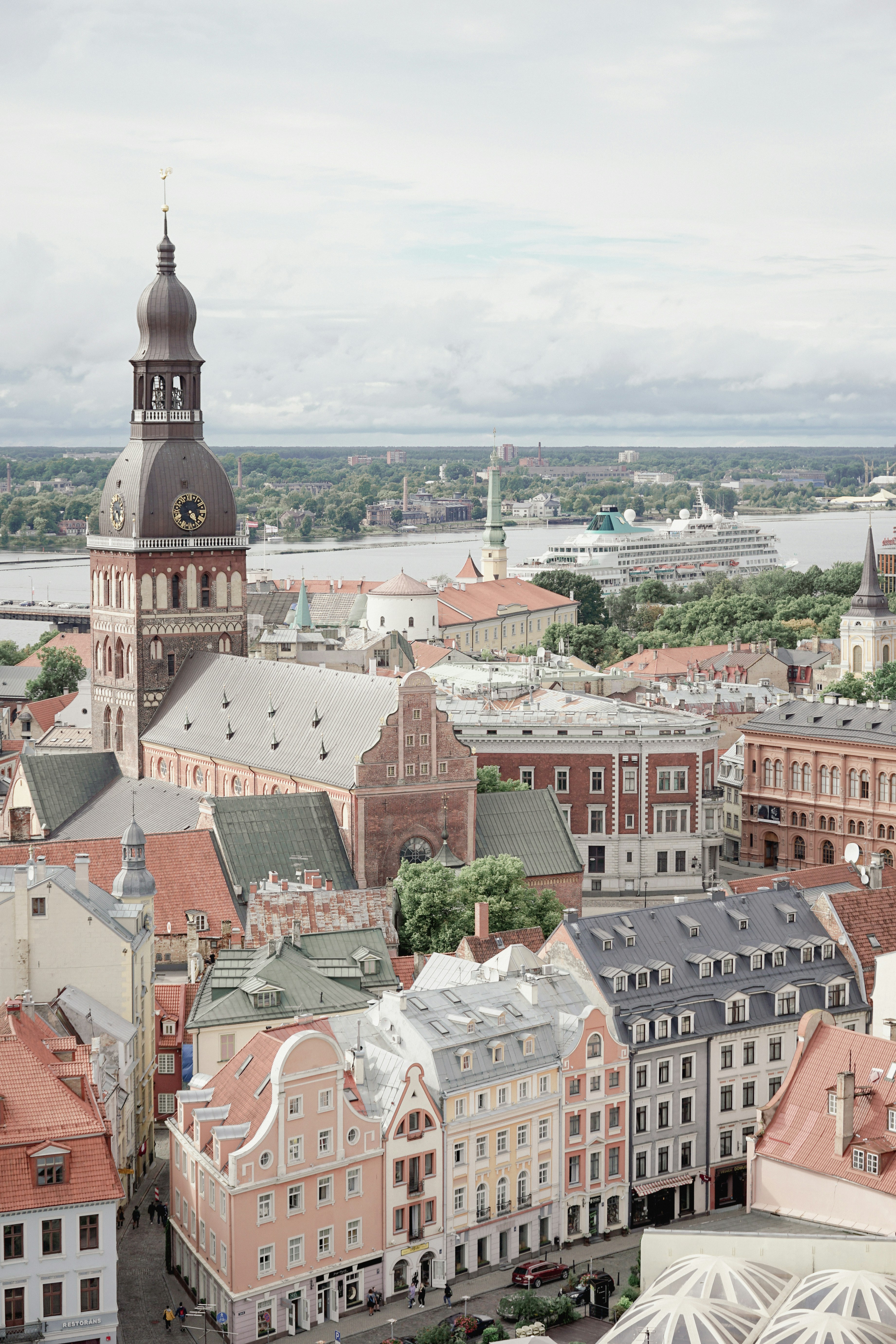
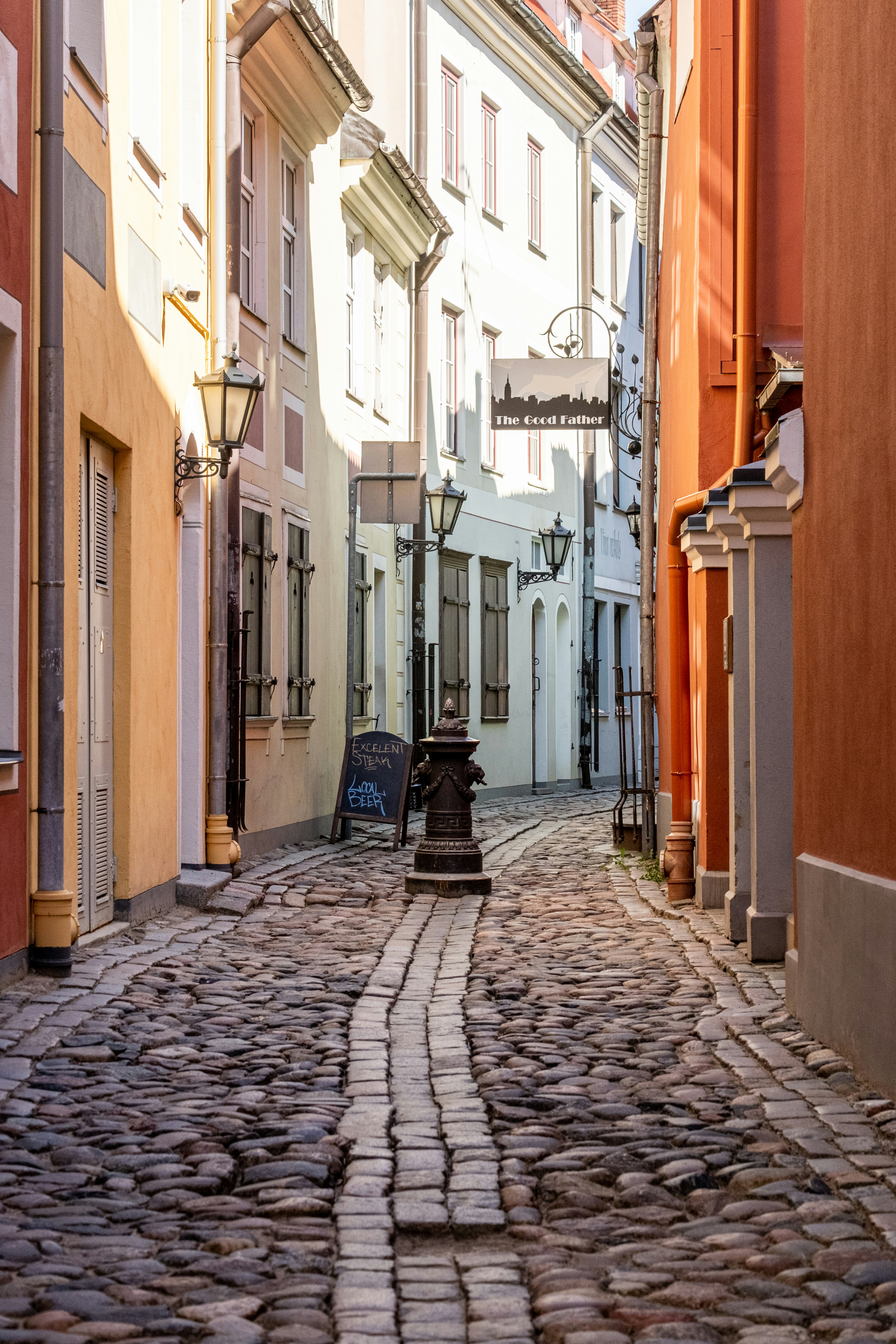
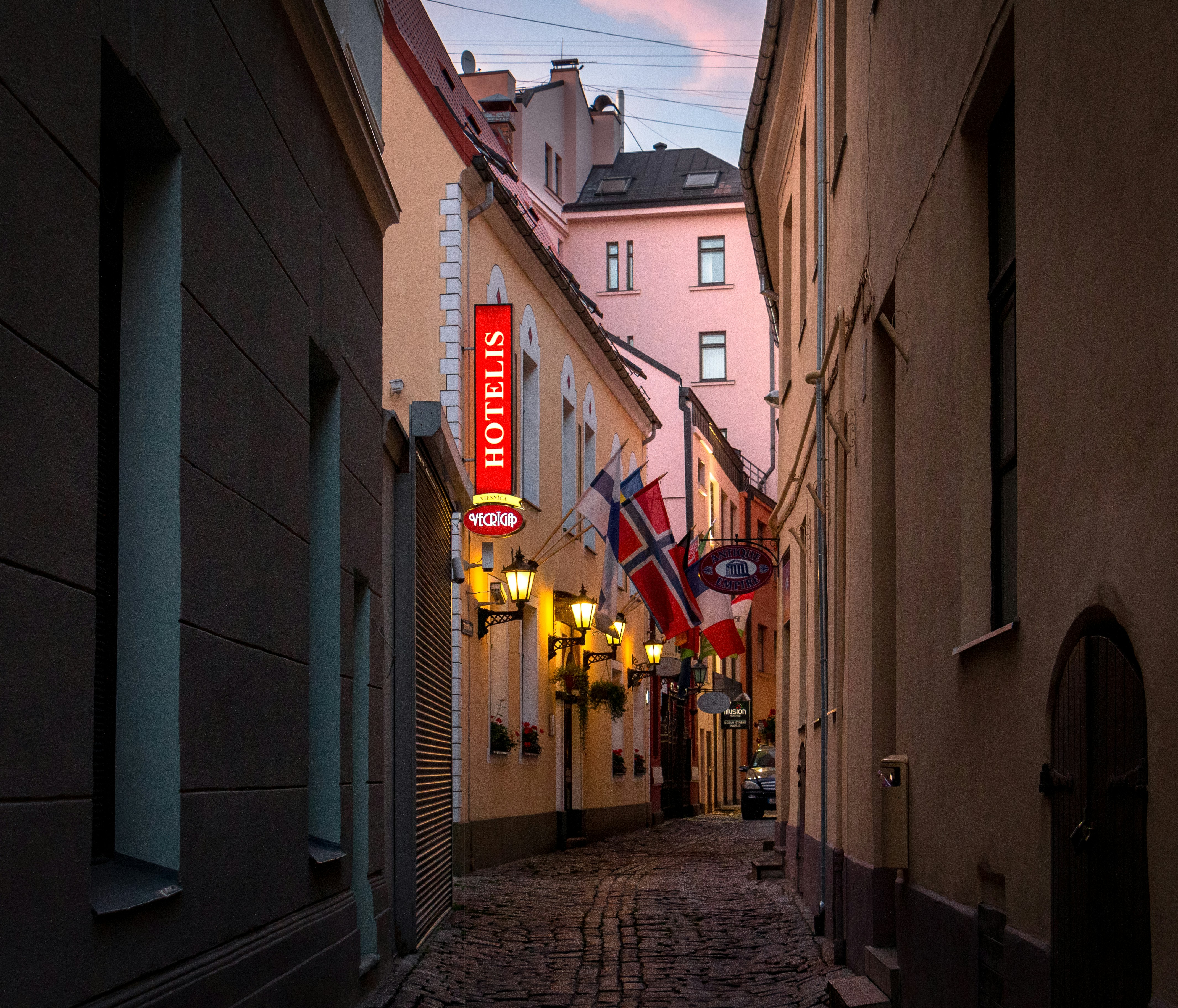
About Riga
Rīga has an upscale, big-city feel unmatched in the region. The capital (almost as large as Tallinn and Vilnius combined) is the business center of the area while original, high-quality restaurants and hotels have earned Rīga some bragging rights among its Western European counterparts. The city also doesn't lack for beauty—Rīga's Old Town (now a UNESCO World Heritage site) is one of Europe’s most striking examples of the art nouveau architectural style. Long avenues of complex and sometimes whimsical Jugendstil facades hint at Rīga's grand past. Many were designed by Mikhail Eisenstein, the father of Soviet director Sergei. This style dominates the city center. In many ways, the wonder of Rīga resides less in its individual attractions and more in the fabric of the town itself. In the medieval Old Town, an ornate gable or architrave catches the eye at every turn. The somber and the flamboyant are both represented in this quarter's 1,000 years of architectural history. Don't hesitate to just follow where your desire leads—the Old Town is compact and bounded by canals, so it's difficult to get totally lost. When the Old Town eventually became too crowded, the city burst out into the newer inner suburbs. The rich could afford to leave and build themselves fine fashionable mansions in the style of the day; consequently, city planners created a whole new Rīga. Across the narrow canal, you'll find the Esplanāde, a vast expanse of parkland with formal gardens and period mansions where the well-heeled stroll and play. Surrounding this is the art nouveau district. Encompassing avenues of splendid family homes (now spruced up in the postcommunist era), the collection has been praised by UNESCO as Europe's finest in the art nouveau style. The best examples are at Alberta 2, 2a, 4, 6, 8, and 13; Elizabetes 10b; and Strēlnieku 4a. If the weather permits, eschew public transport and stroll between the two districts, taking in the varied skylines and multifaceted facades, and perhaps stopping at a café or two as you go. The city has churches in five Christian denominations and more than 50 museums, many of which cater to eclectic or specialist tastes.



About Visby
Gotland is Sweden's main holiday island, a place of ancient history, a relaxed summer-party vibe, wide sandy beaches, and wild cliff formations called raukar (the remnants of reefs formed more than 400 million years ago). Measuring 125 km (78 miles) long and 52 km (32 miles) at its widest point, Gotland is where Swedish sheep farming has its home. In its charming glades, 35 varieties of wild orchids thrive, attracting botanists from all over the world.
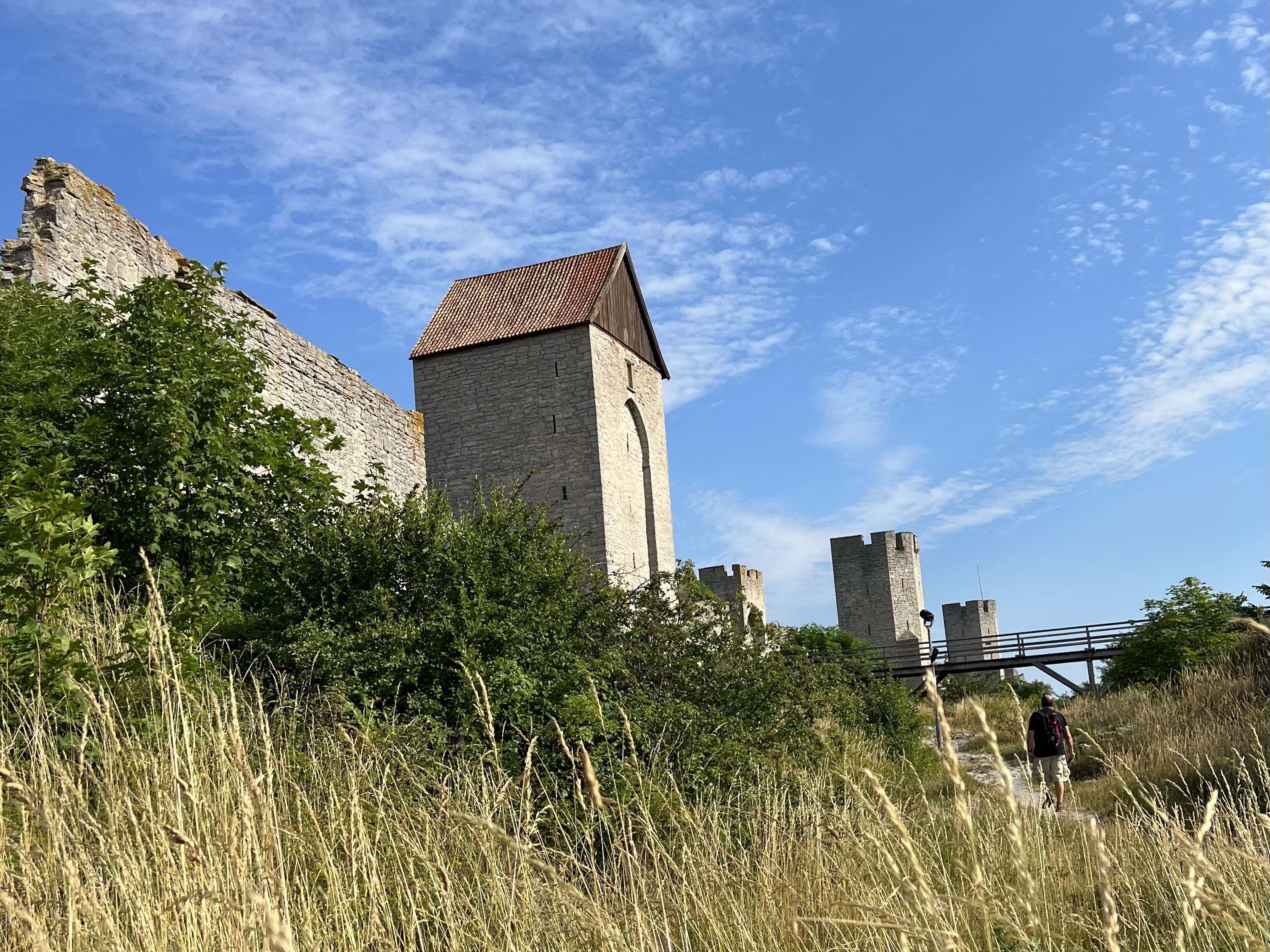
About Kalmar
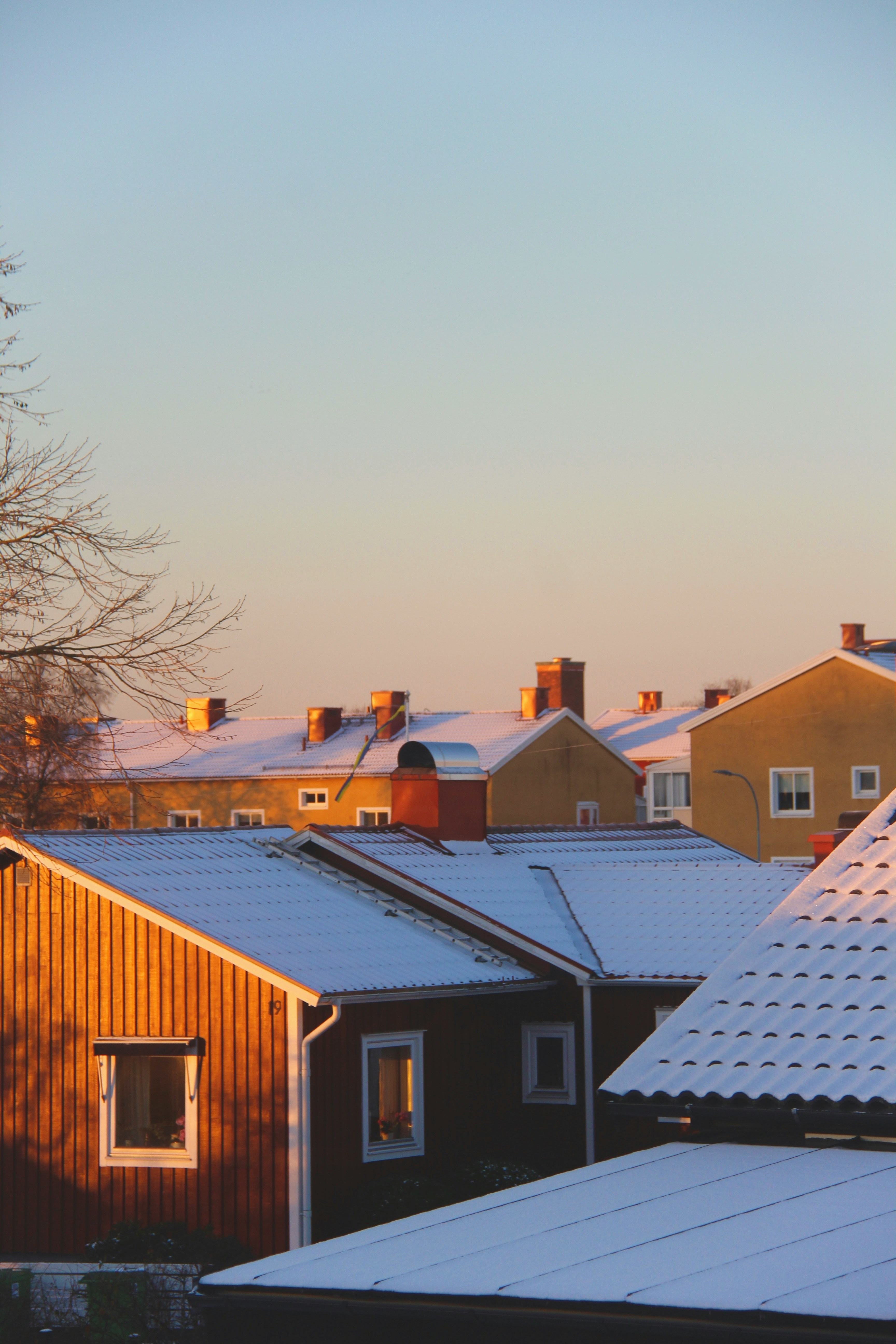
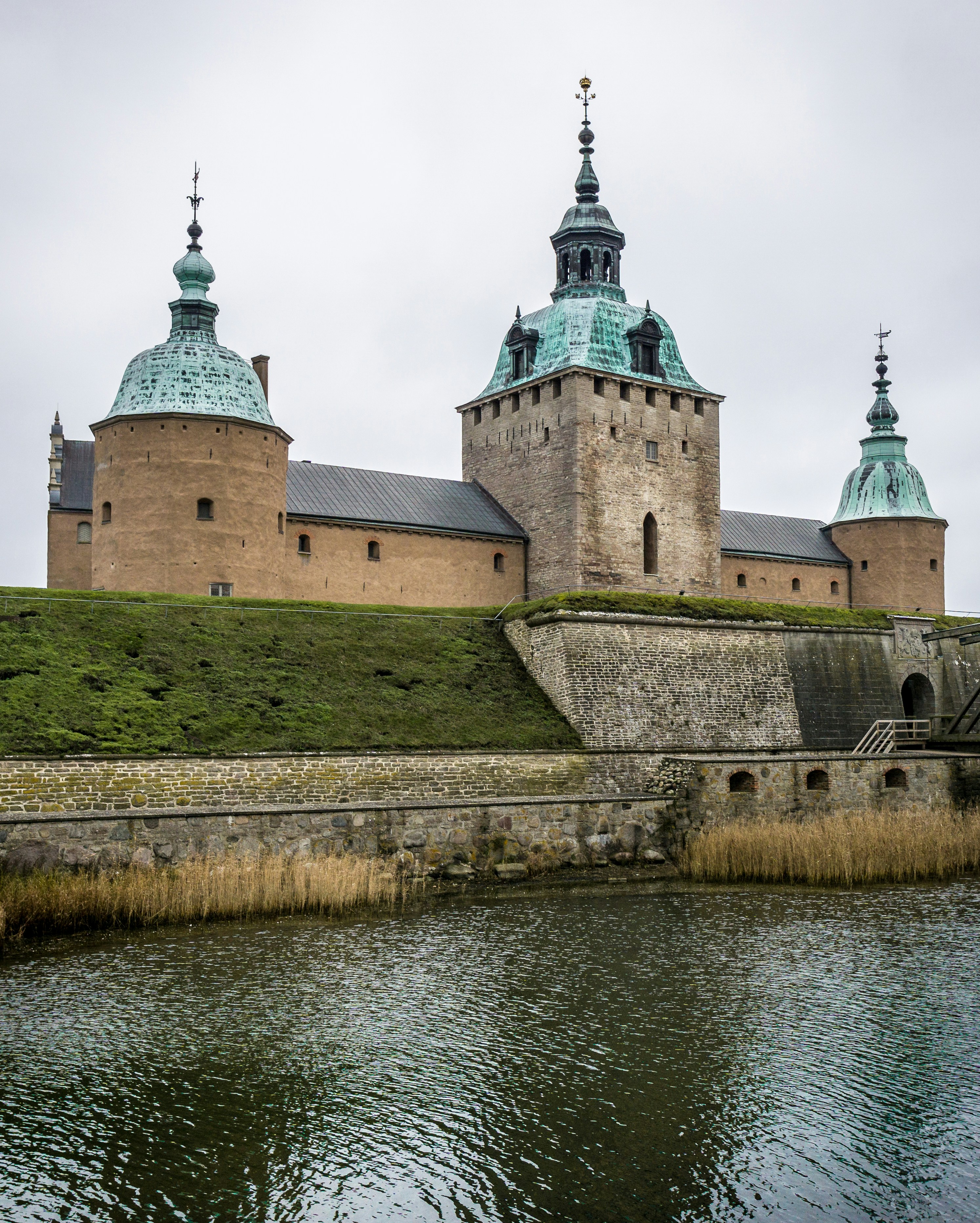
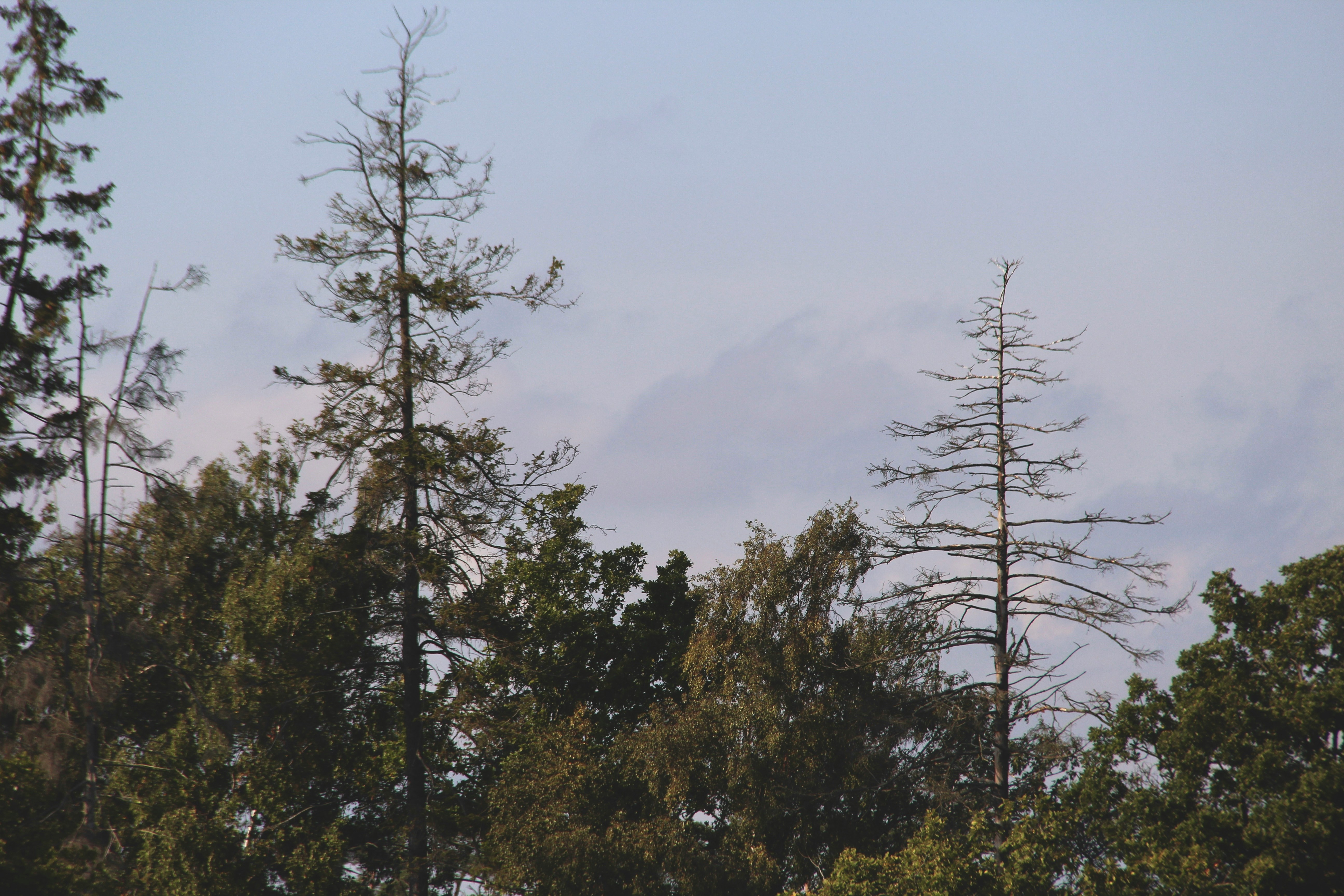
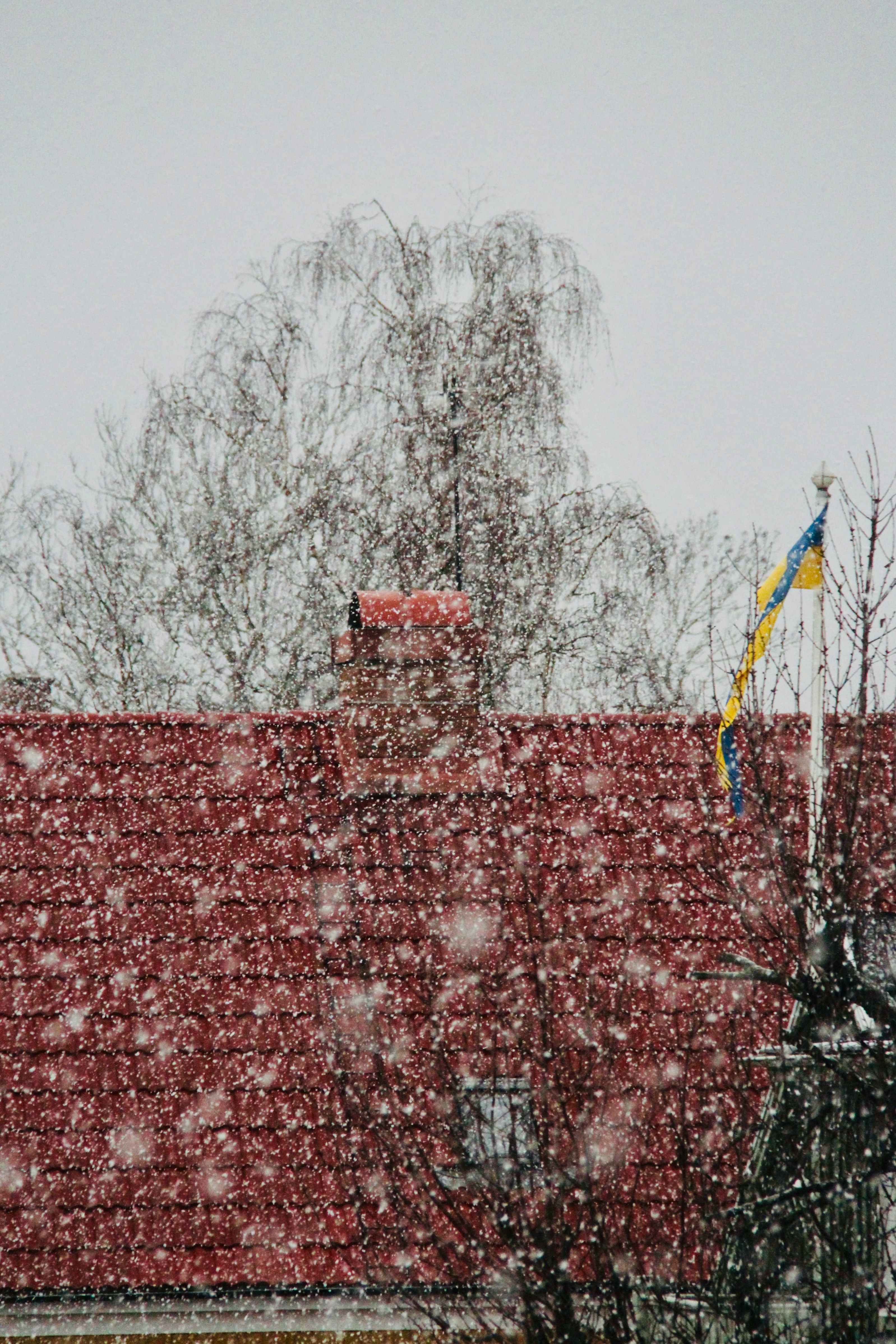
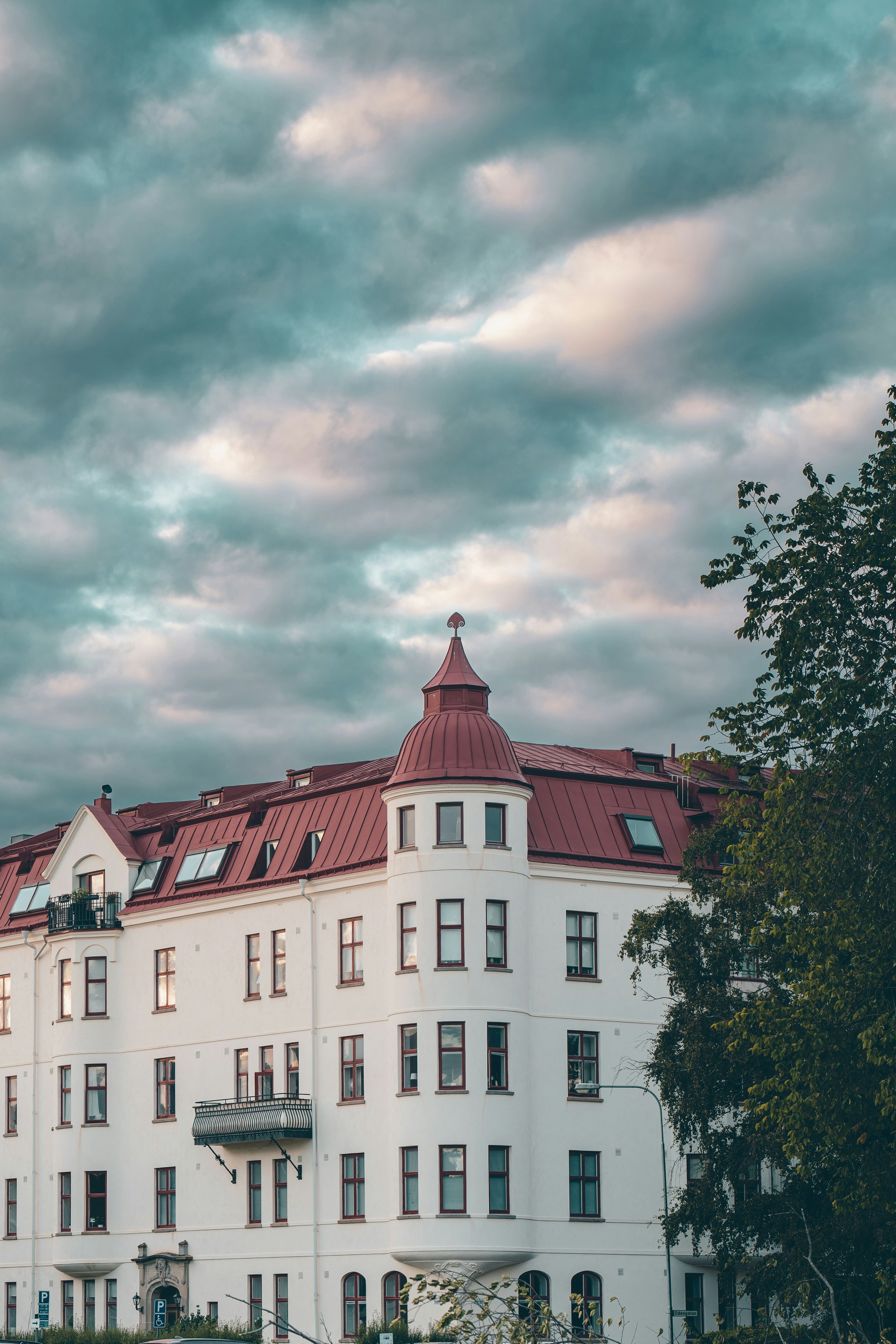
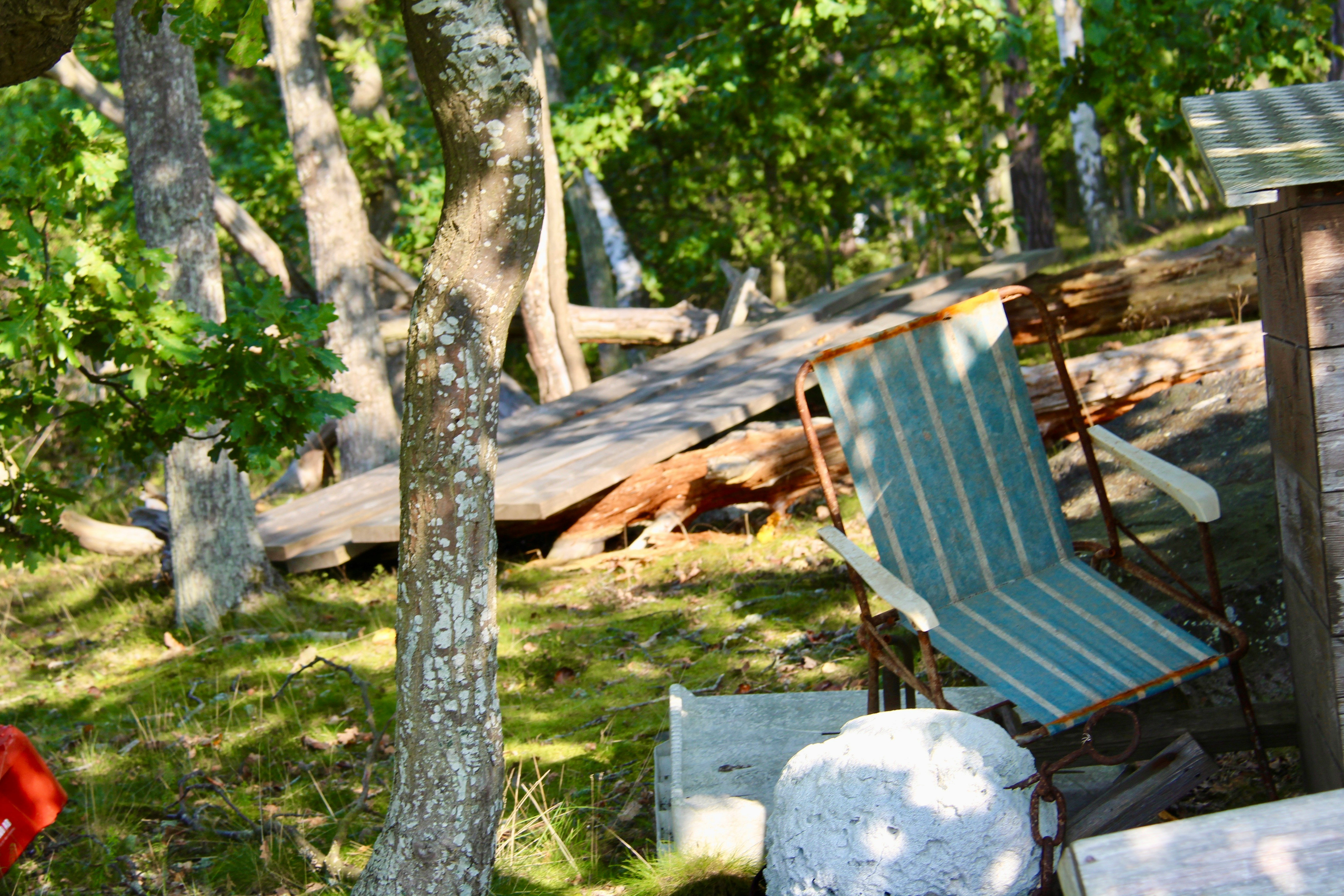
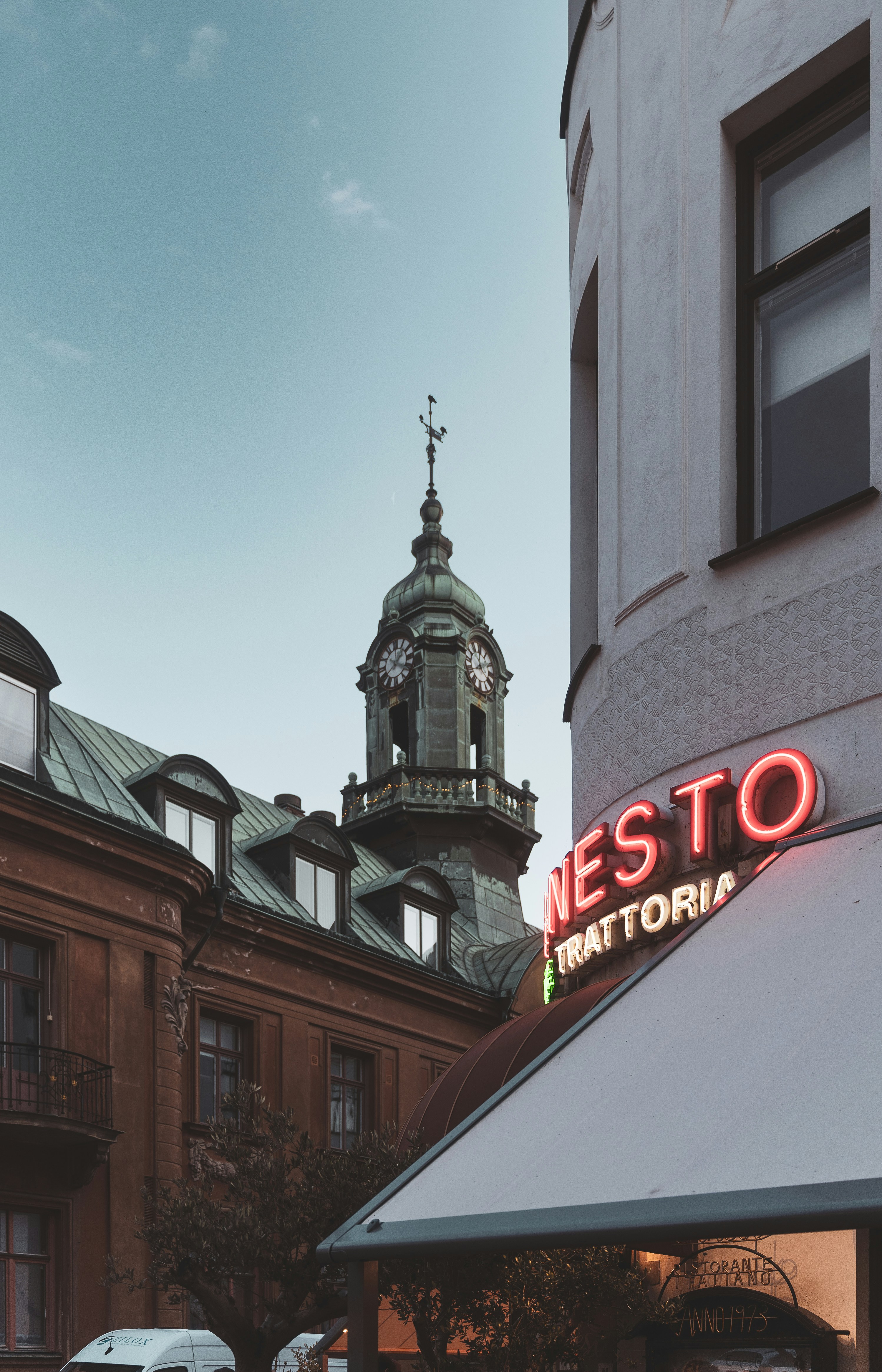
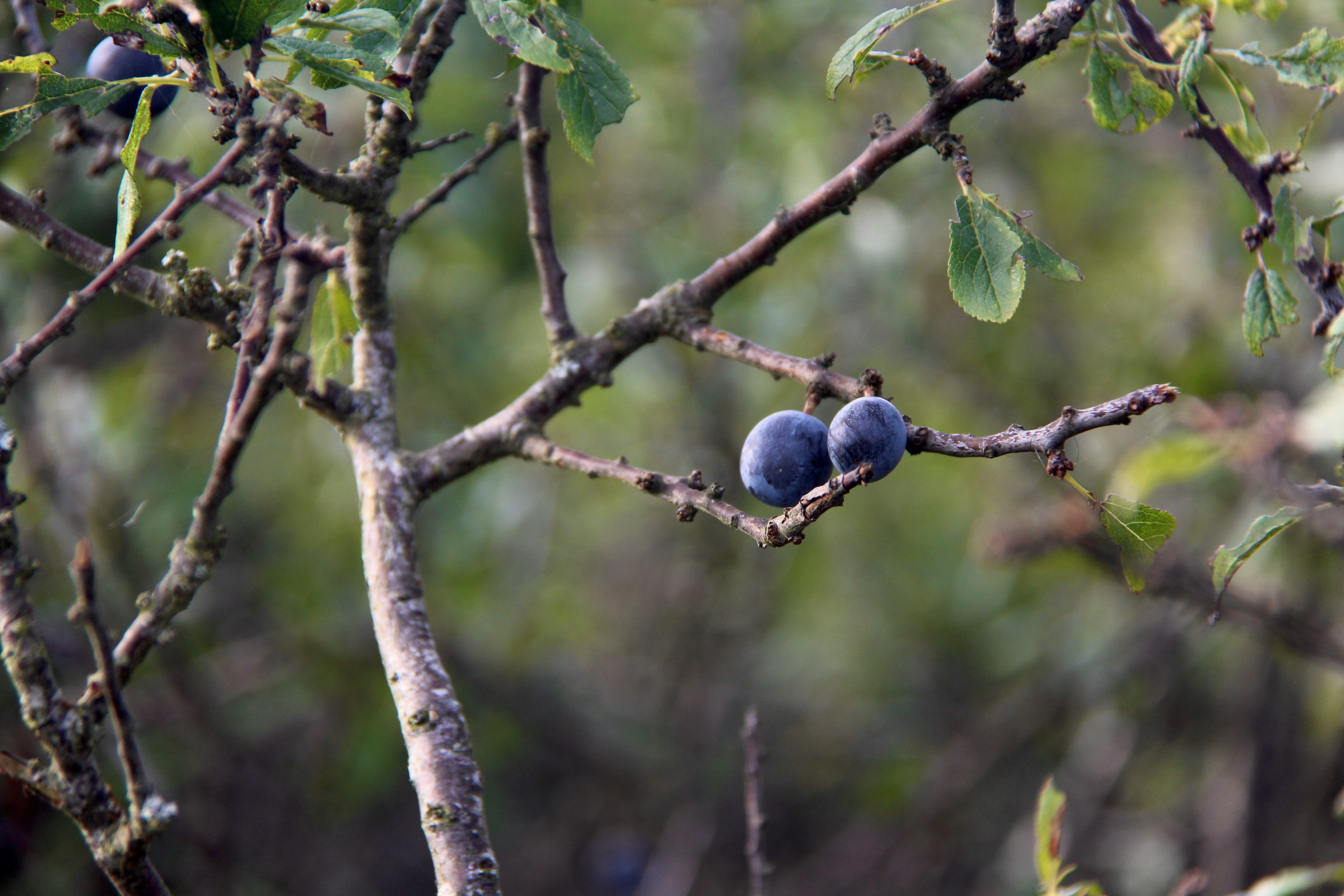
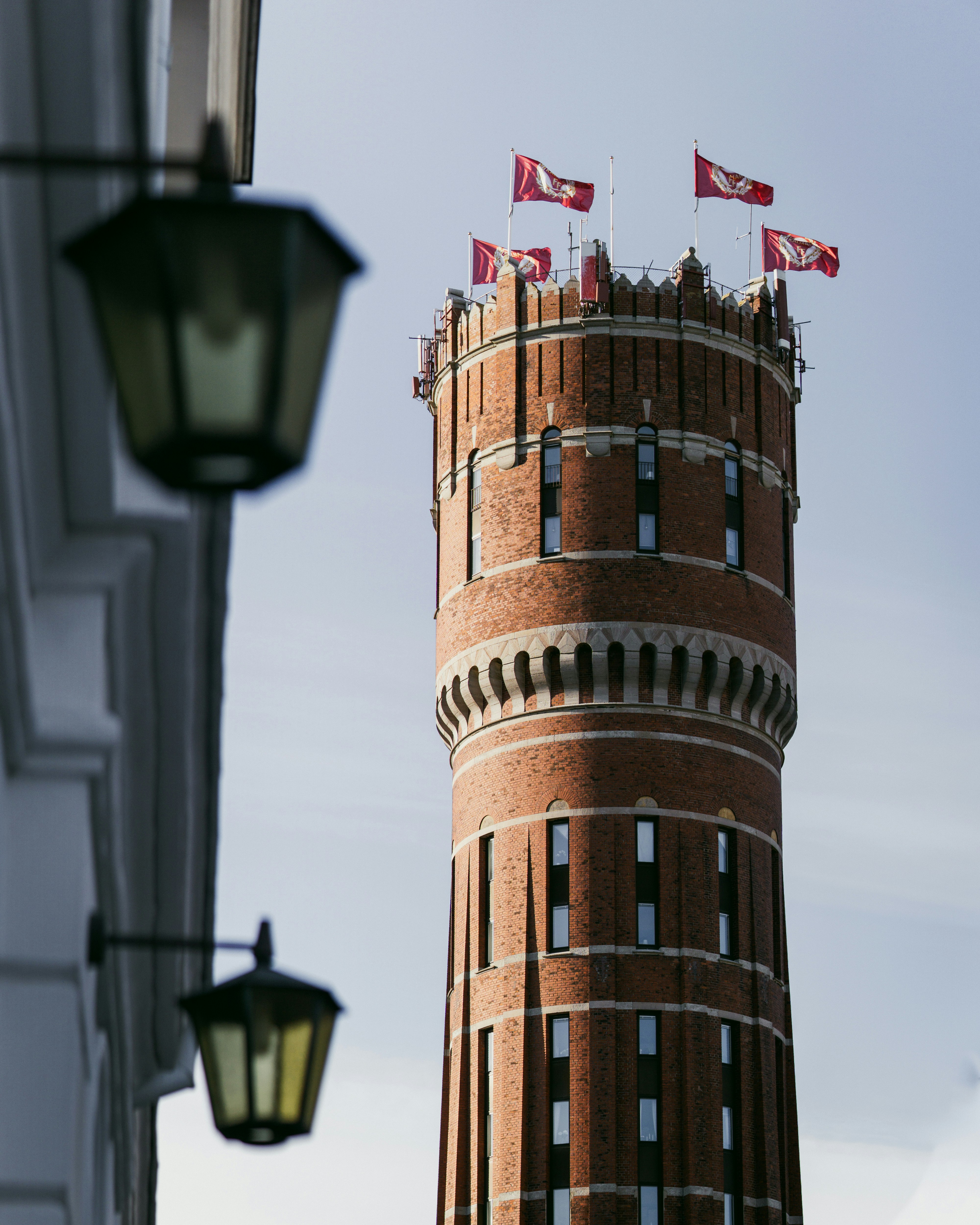

About Rønne
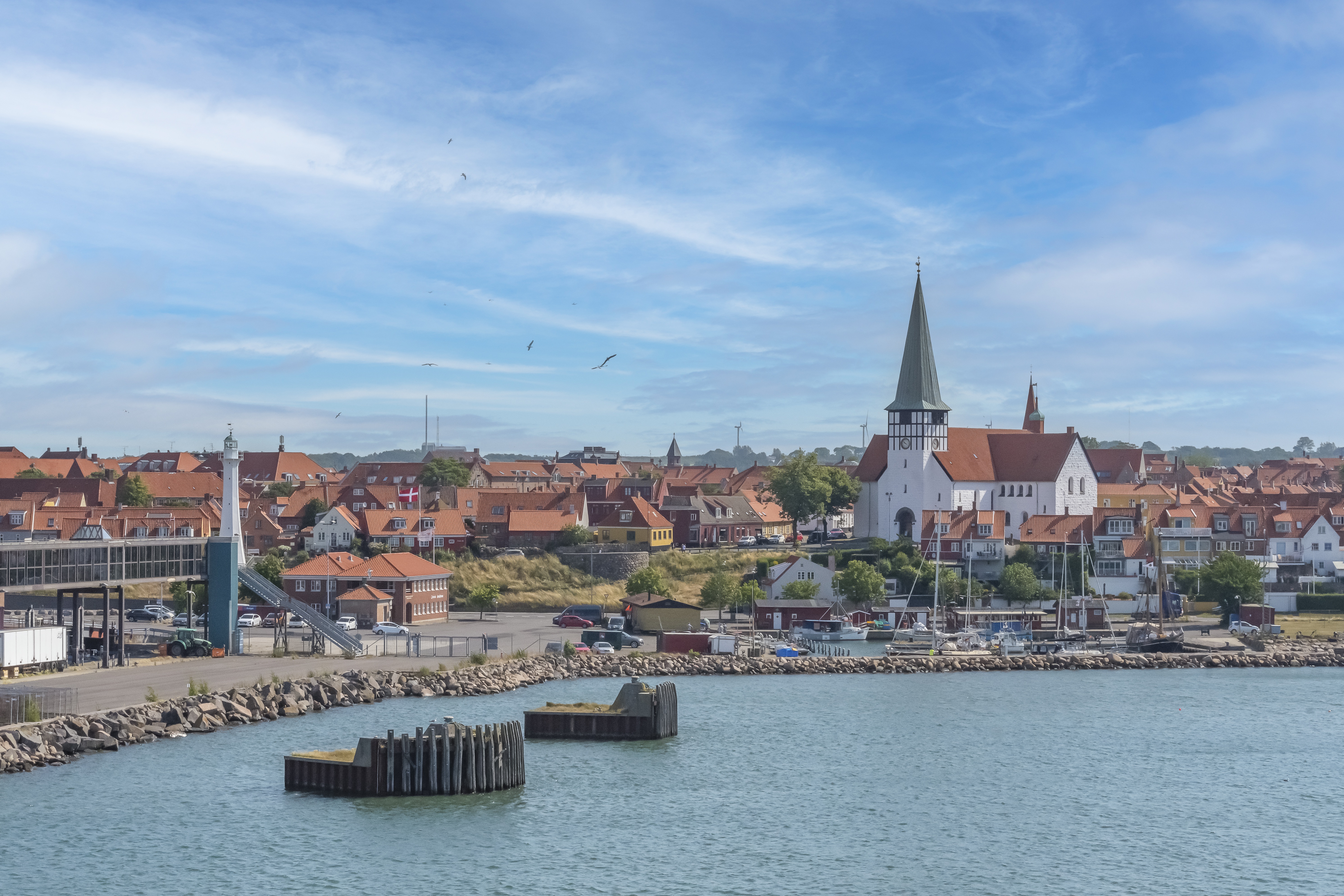
About Warnemünde
Warnemünde, officially a suburb of Rostock, is a quaint seaside resort town with the best hotels and restaurants in the area, as well as 20 km (12 miles) of beautiful white-sand beach. It's been a popular summer getaway for families in eastern Germany for years.There is little to do in Warnemünde except relax, and the town excels brilliantly at that. However, Warnemünde is a major cruise-ship terminal. Whenever there is more than one ship at dock, the town explodes with a county fair–like atmosphere, and shops and restaurants stay open until the ships leave at midnight. The city celebrates the dreifache Anlauf, when three ships dock simultaneously, with fireworks.


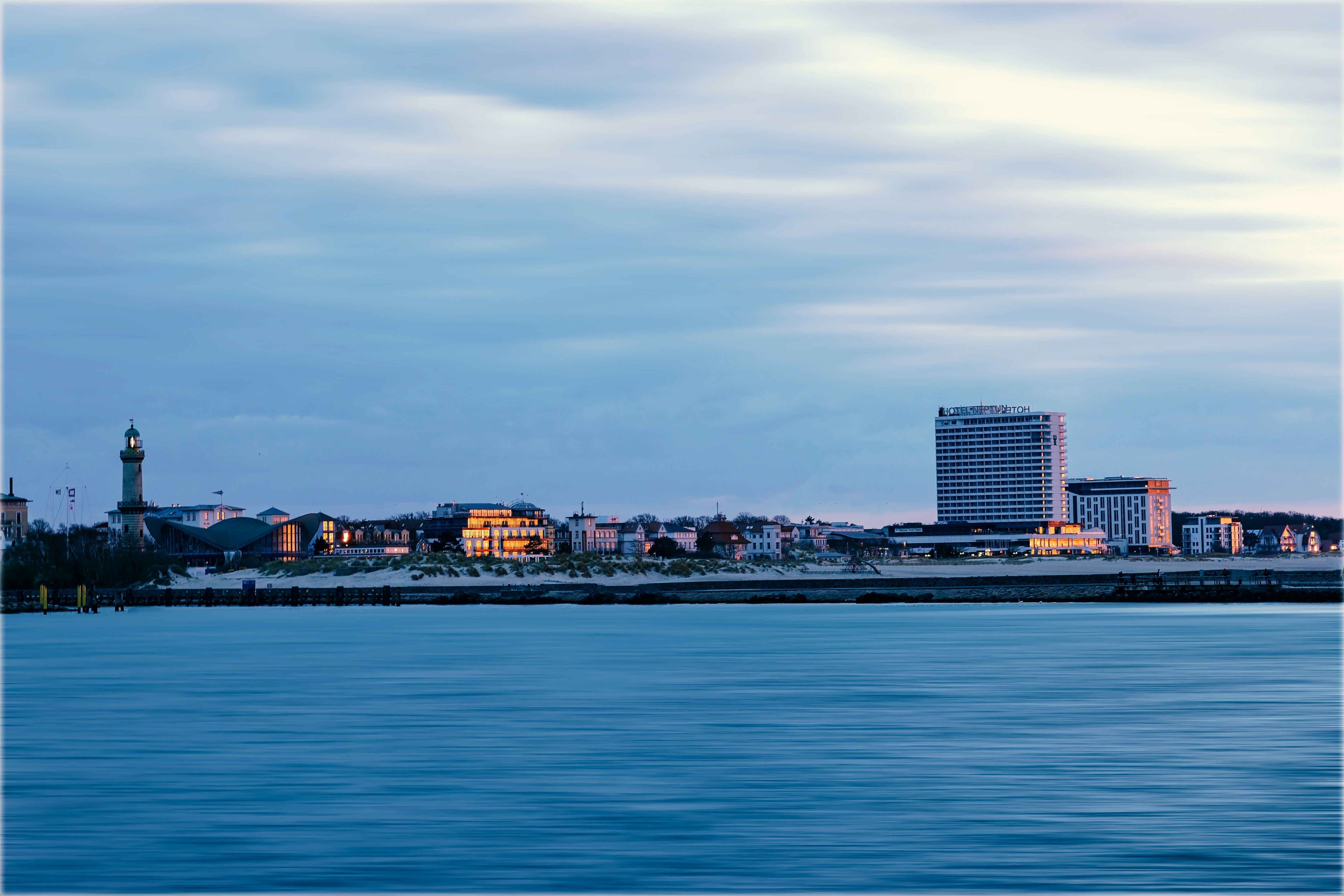
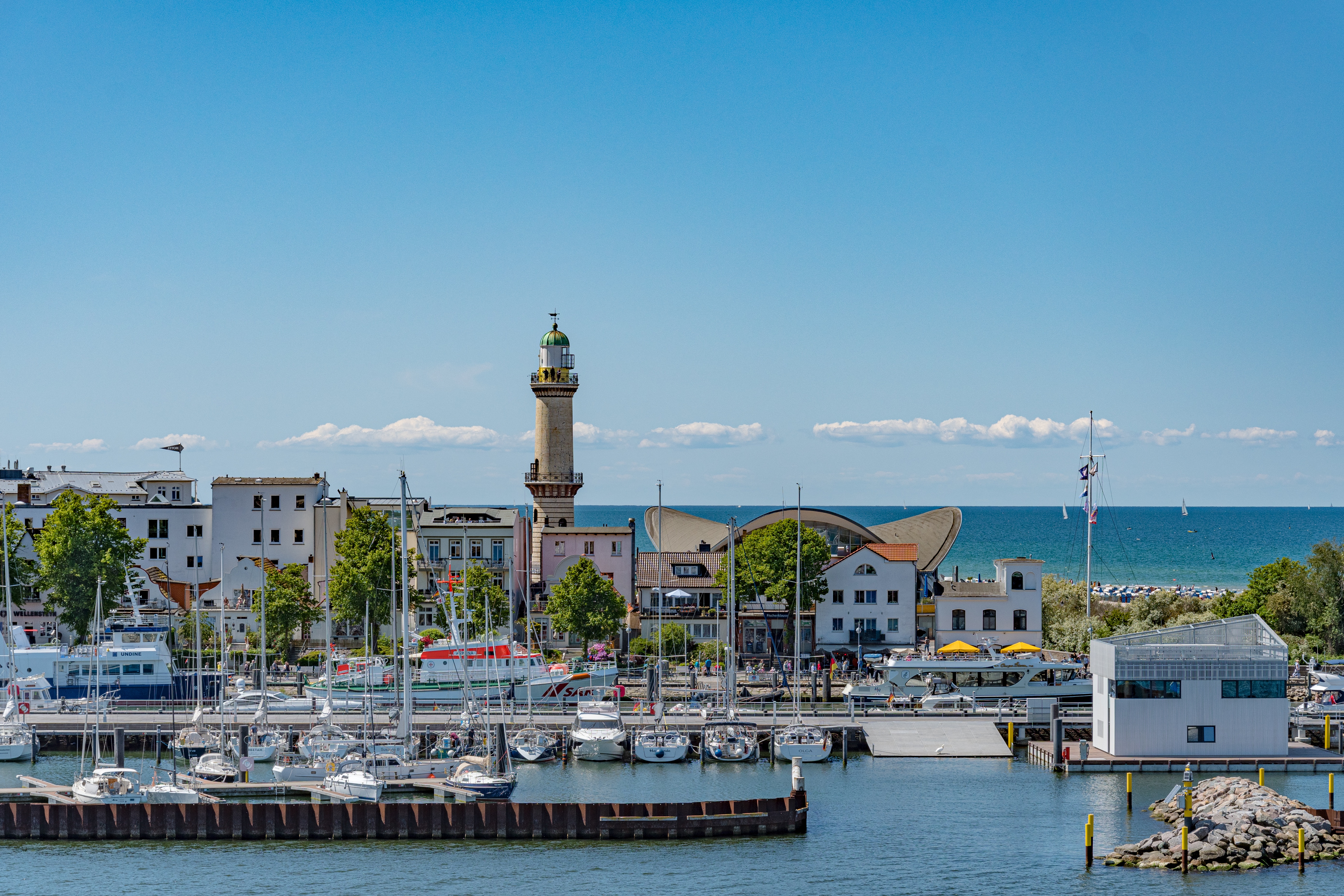
About Nyborg
About Copenhagen
By the 11th century, Copenhagen was already an important trading and fishing centre and today you will find an attractive city which, although the largest in Scandinavia, has managed to retain its low-level skyline. Discover some of the famous attractions including Gefion Fountain and Amalienborg Palace, perhaps cruise the city’s waterways, visit Rosenborg Castle or explore the medieval fishing village of Dragoer. Once the home of Hans Christian Andersen, Copenhagen features many reminders of its fairytale heritage and lives up to the reputation immortalised in the famous song ‘Wonderful Copenhagen’.
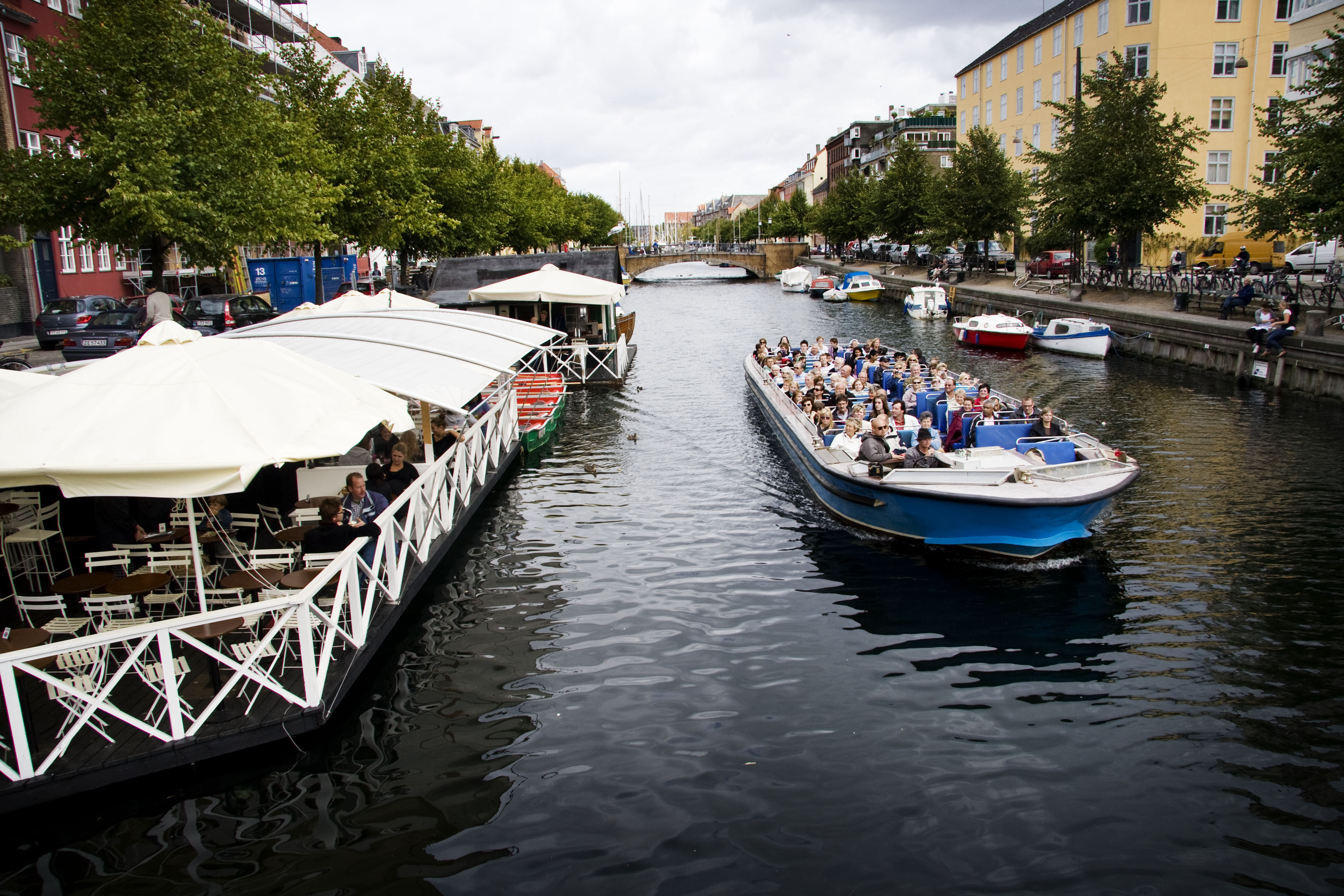
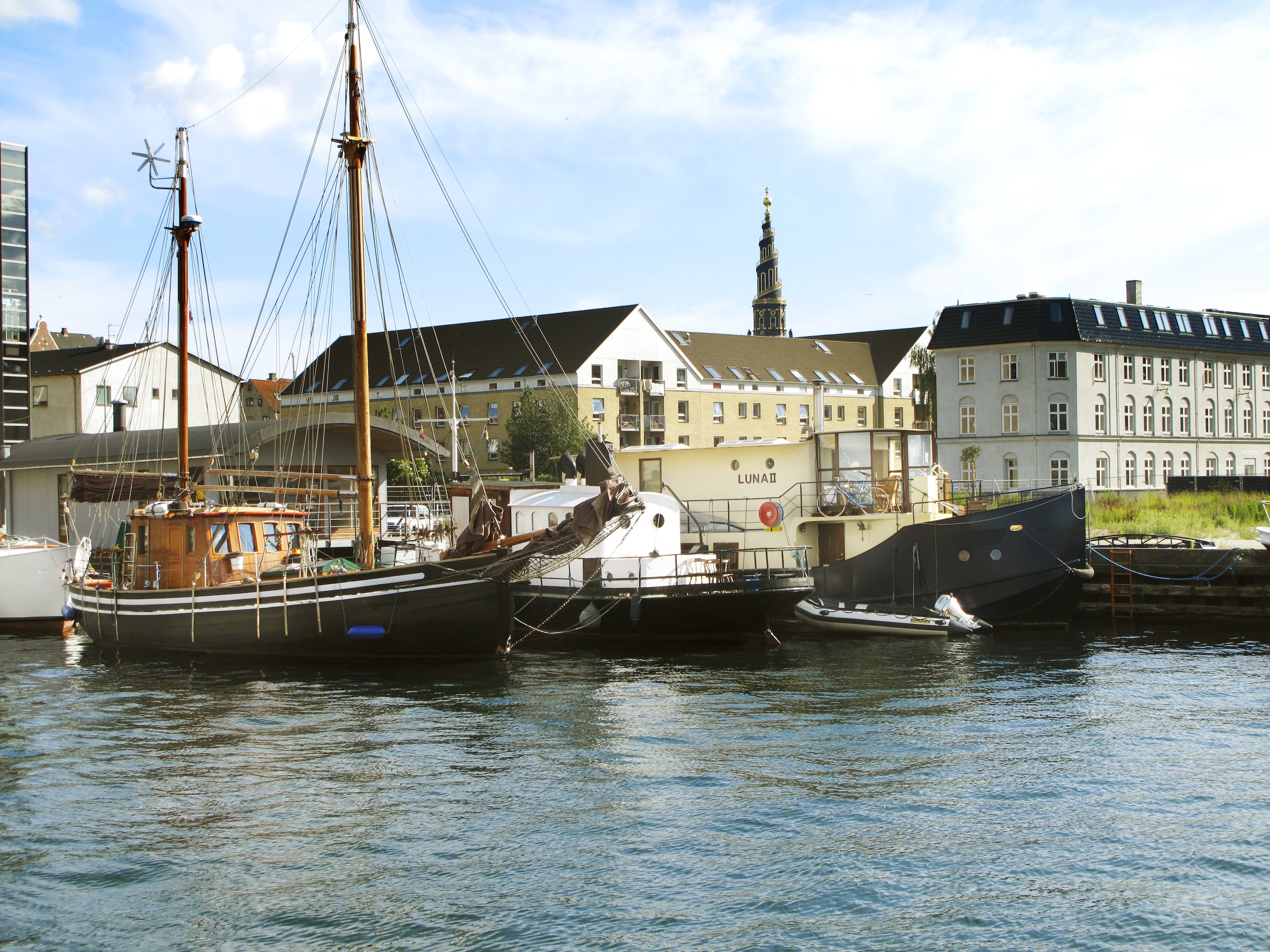
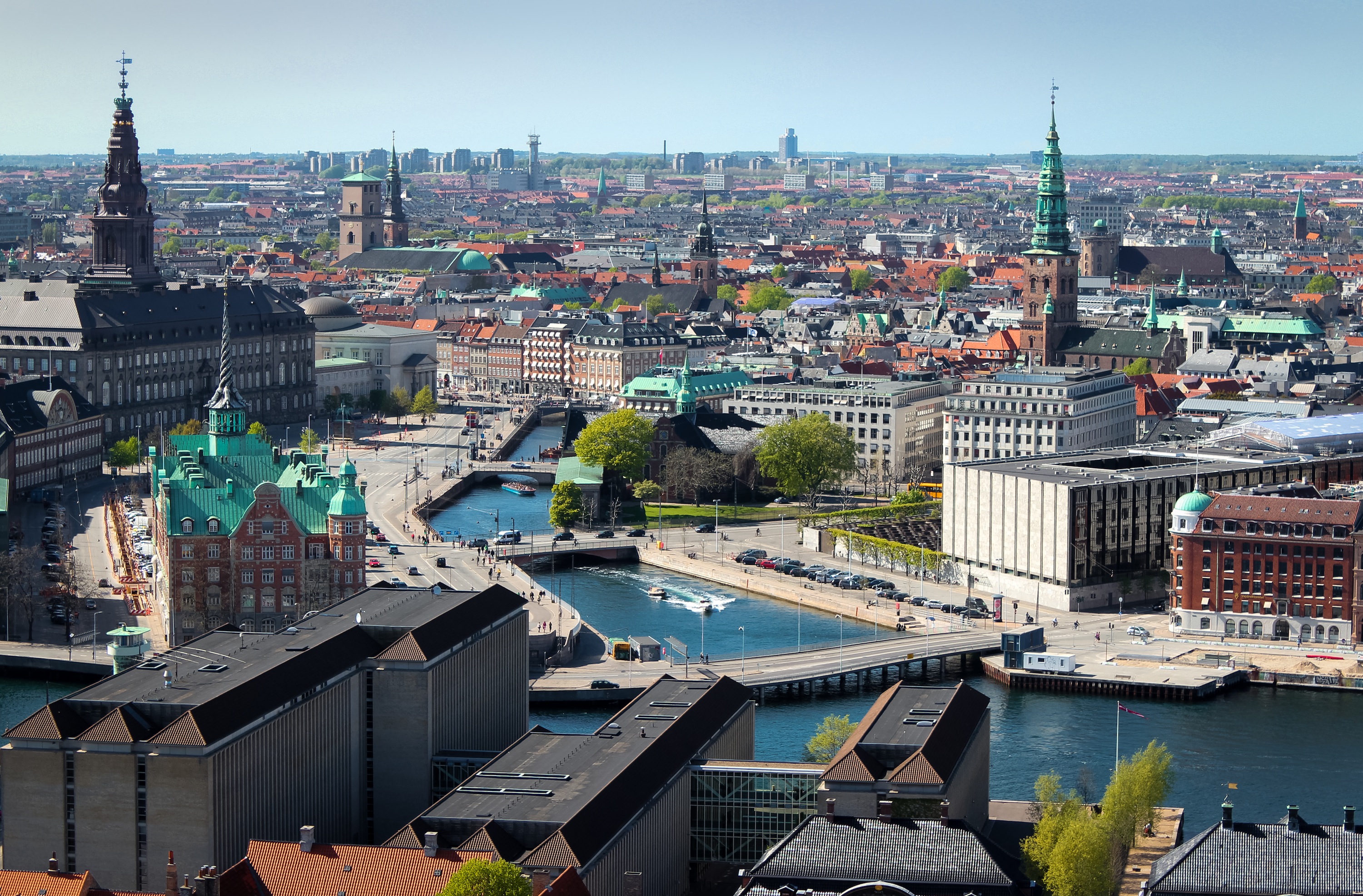
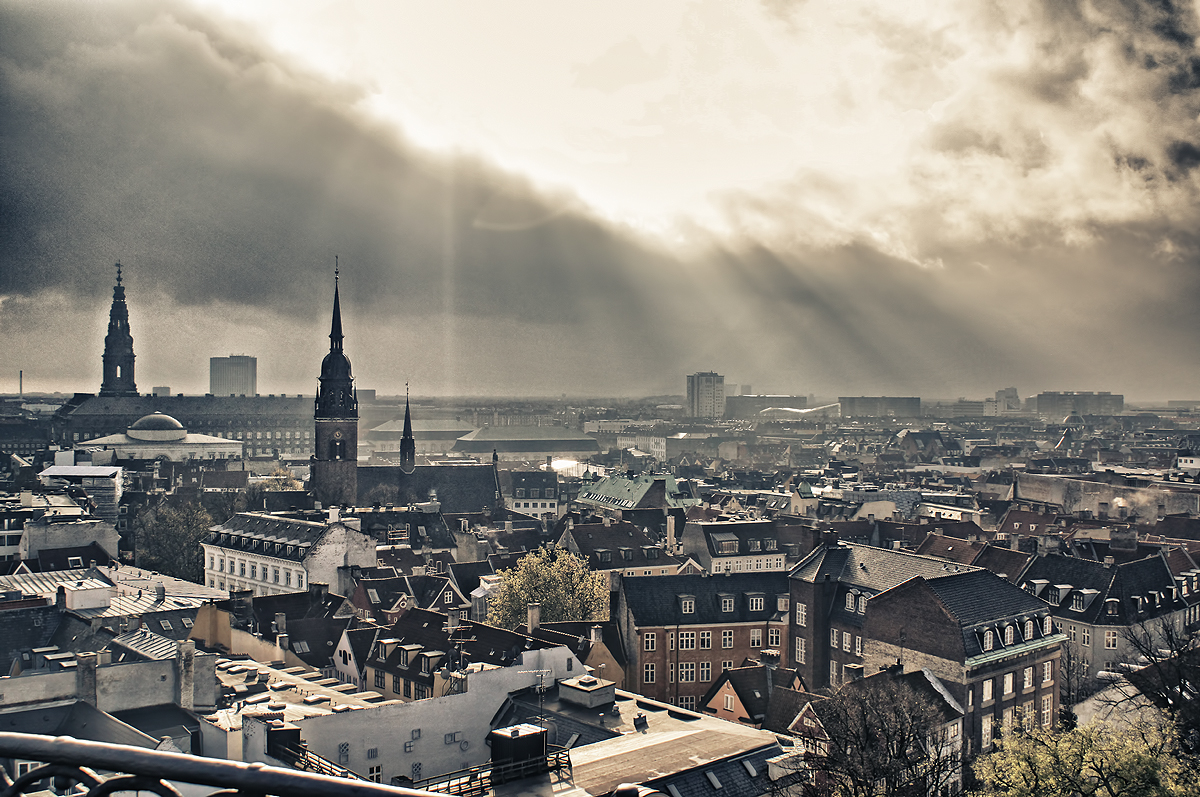
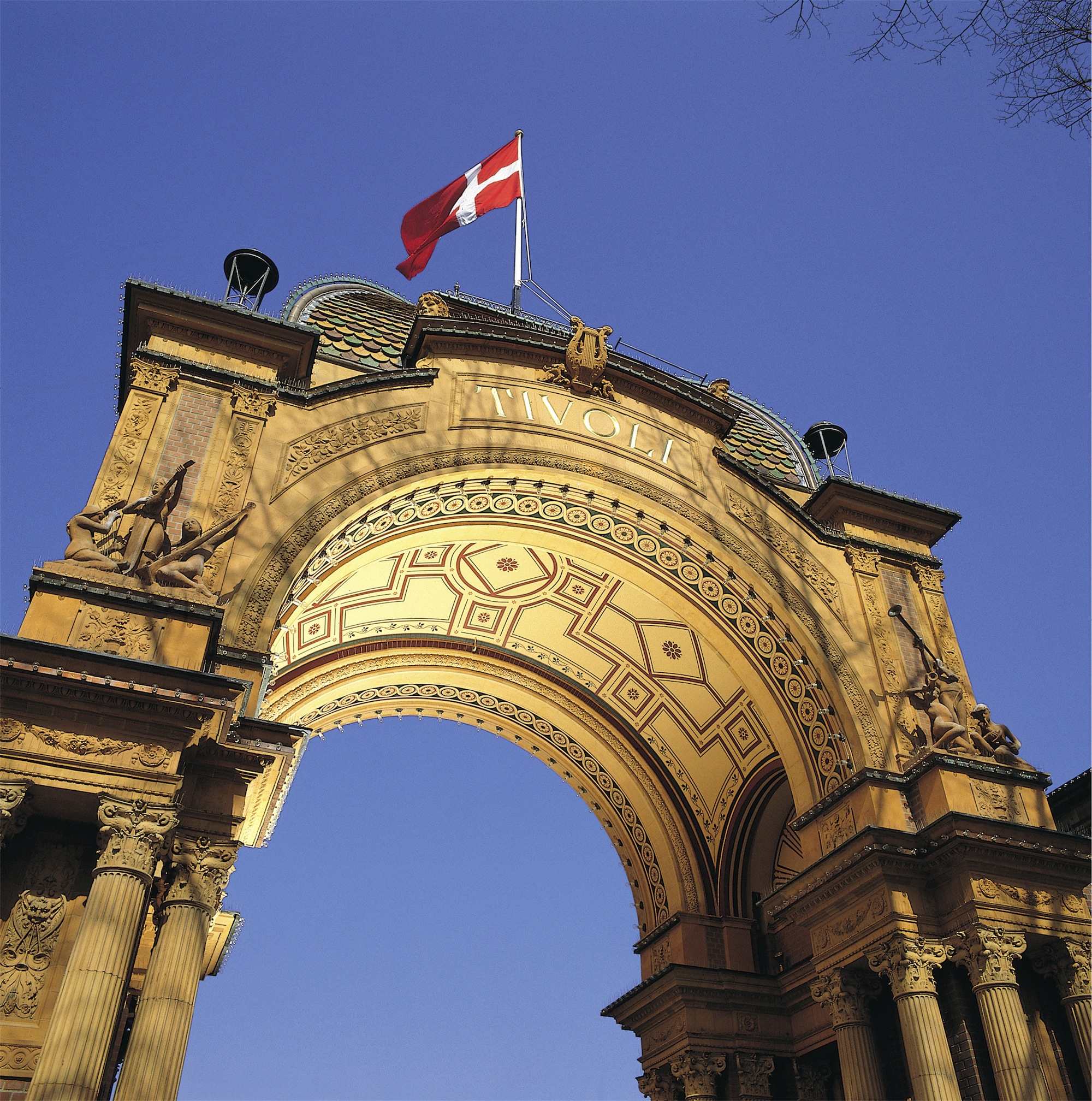
Handcrafted and extraordinary in every way, our Owner’s Penthouse Suites are the ultimate indulgence. Boasting the best views on board, a private spa pool on the spacious terrace, dedicated lounge and dining area, a super-sized bathroom with dual vitality mist showers, and a personalised butler service, it’s a once-in-a-lifetime experience.
Suite Features
At an enormous 195m² in size, the Owner’s Penthouse Suites are located on Deck 9.
Suite names and amenities are the same across both Scenic Eclipse and Scenic Eclipse II, however, both have been thoughtfully curated to suit the cruising experience of these ships.
Spacious Terrace & Pool
Your curved terrace, complete with a personal private spa pool and sun loungers, is the perfect place to indulge in ultra-luxury relaxation.
Super-sized Bathroom
Featuring a super-sized bathroom, your relaxation and comfort are enhanced with a dual steam shower, therapeutic spa bath and guest powder room with dual vanity.
Priority Reservations & Embarkation
Guests in our Owner’s Penthouse Suite will enjoy the privilege of priority dining in the specialty restaurants as well as priority choice of Scenic Freechoice, Scenic Discovery, helicopter^ and submersible^ excursions. VIP embarkation and disembarkation are standard inclusions at the start and finish of your cruise.
Amenities & Features
- Spacious terrace with lounge area, sun loungers and private spa pool
- Spa Day Bed - transforming for in-suite private spa experience
- A separate bedroom with luxury king-size Scenic Slumber Bed and his and hers walk-in wardrobe
- Personalised butler service
- Therapeutic spa bath
- Dual vitality mist shower with colour light therapy
- Guest powder room, dual vanity, VIP amenities and Dyson hairdryer
- Walk-in robe
- In-suite dining with seating for up to eight guests
- A full complimentary mini-bar stocked with wines, Champagnes and spirits personalised to your preference, including illy coffee and specialty teas re-stocked daily
- Canapes and petite fours delivered to your suite
- Complimentary laundry service~
- Guaranteed dining reservations
- Priority choice of shore excursions
- VIP embarkation and disembarkation
- Advanced Heating, Ventilation and Air-Conditioning system (HVAC) provides 100% fresh air
- The highest sound insulation as per the marine class society Bureau Veritas
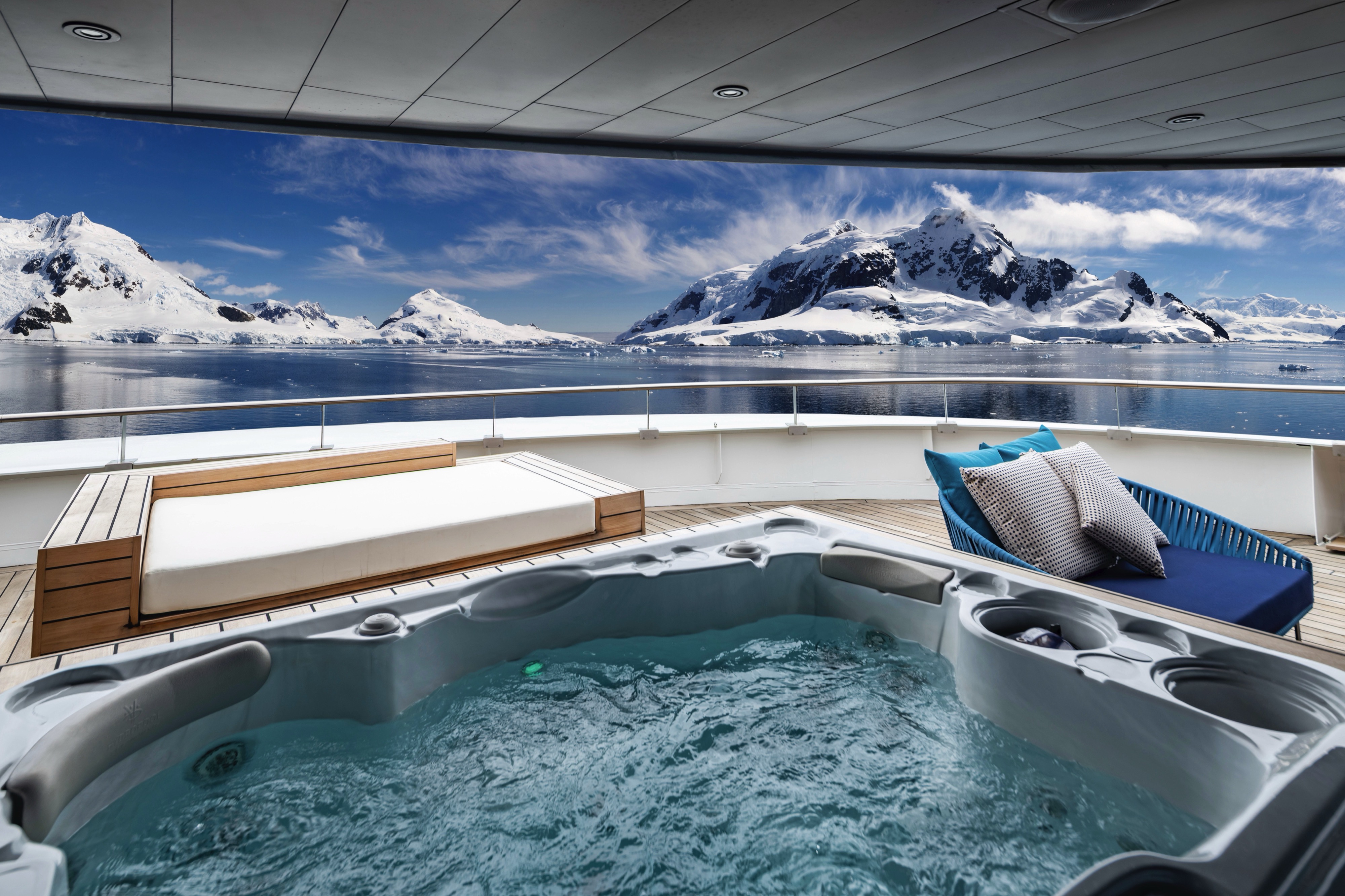
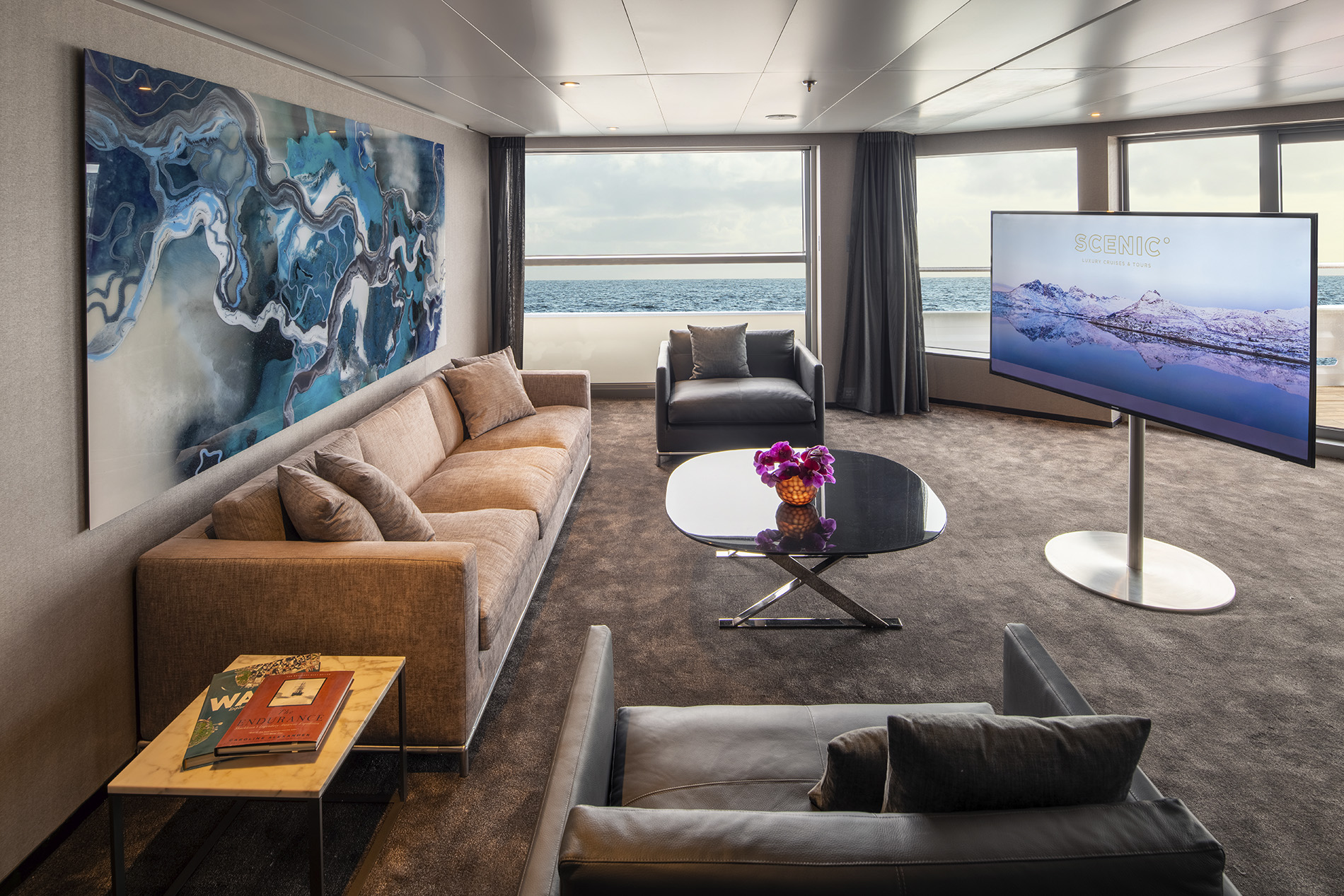
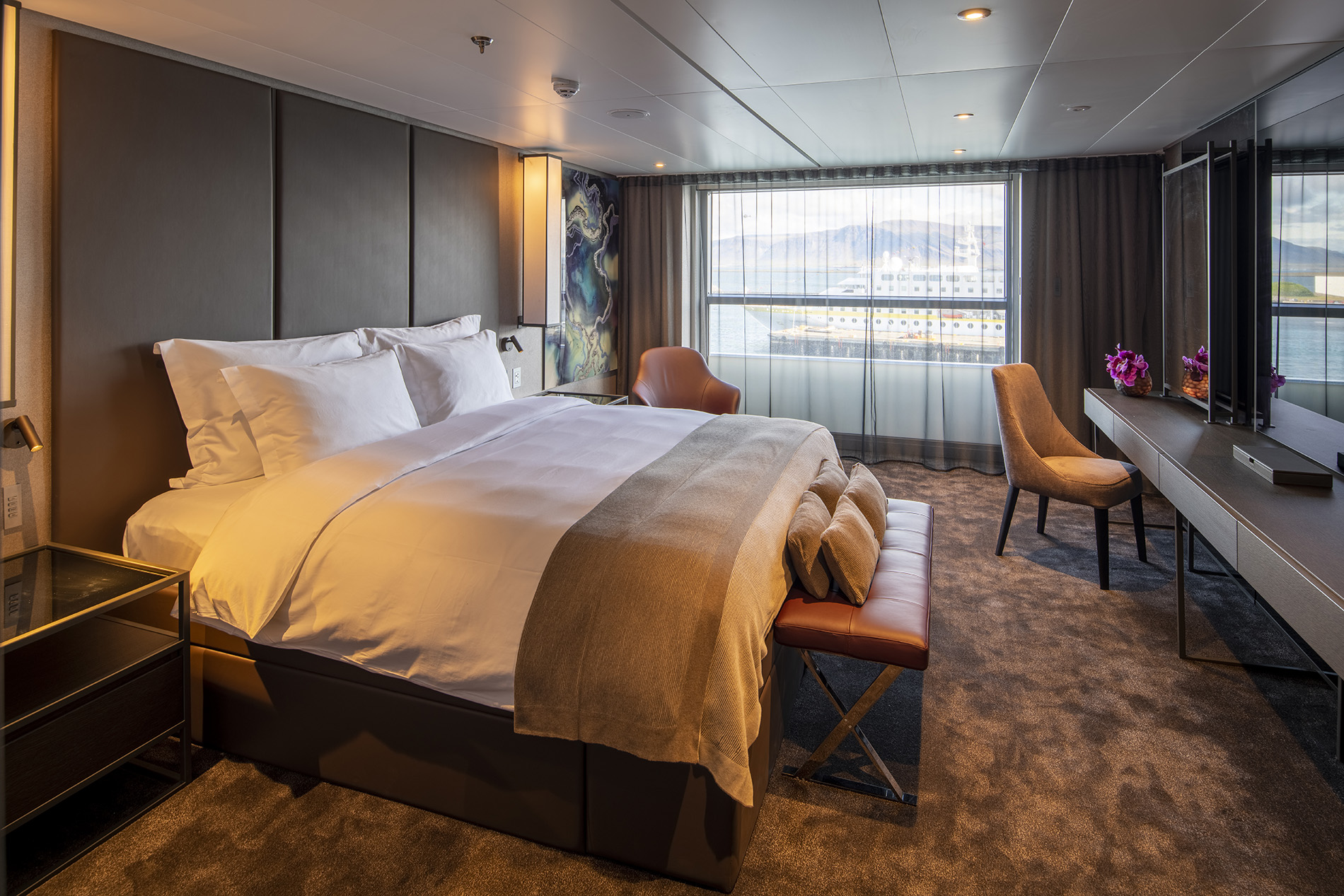
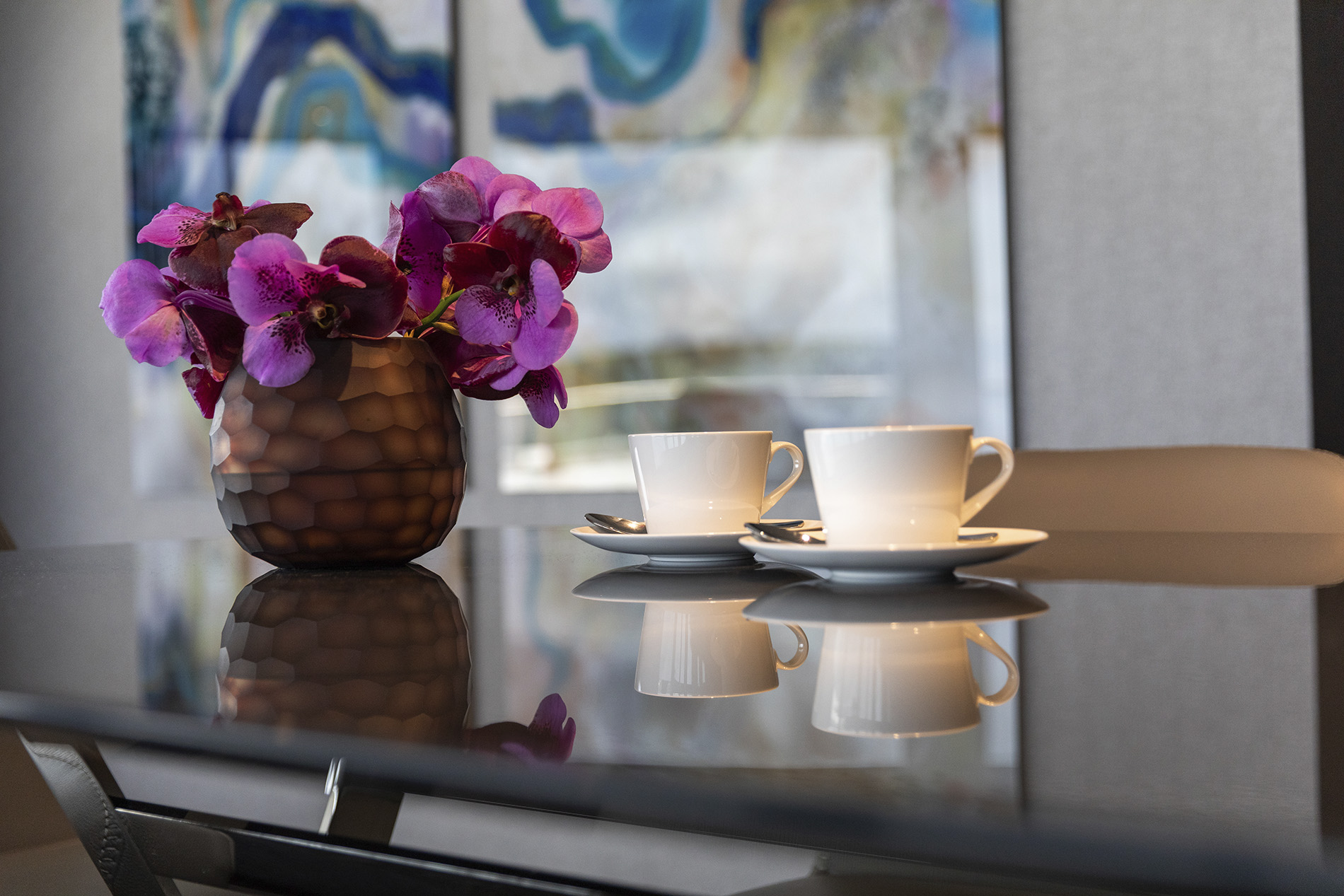
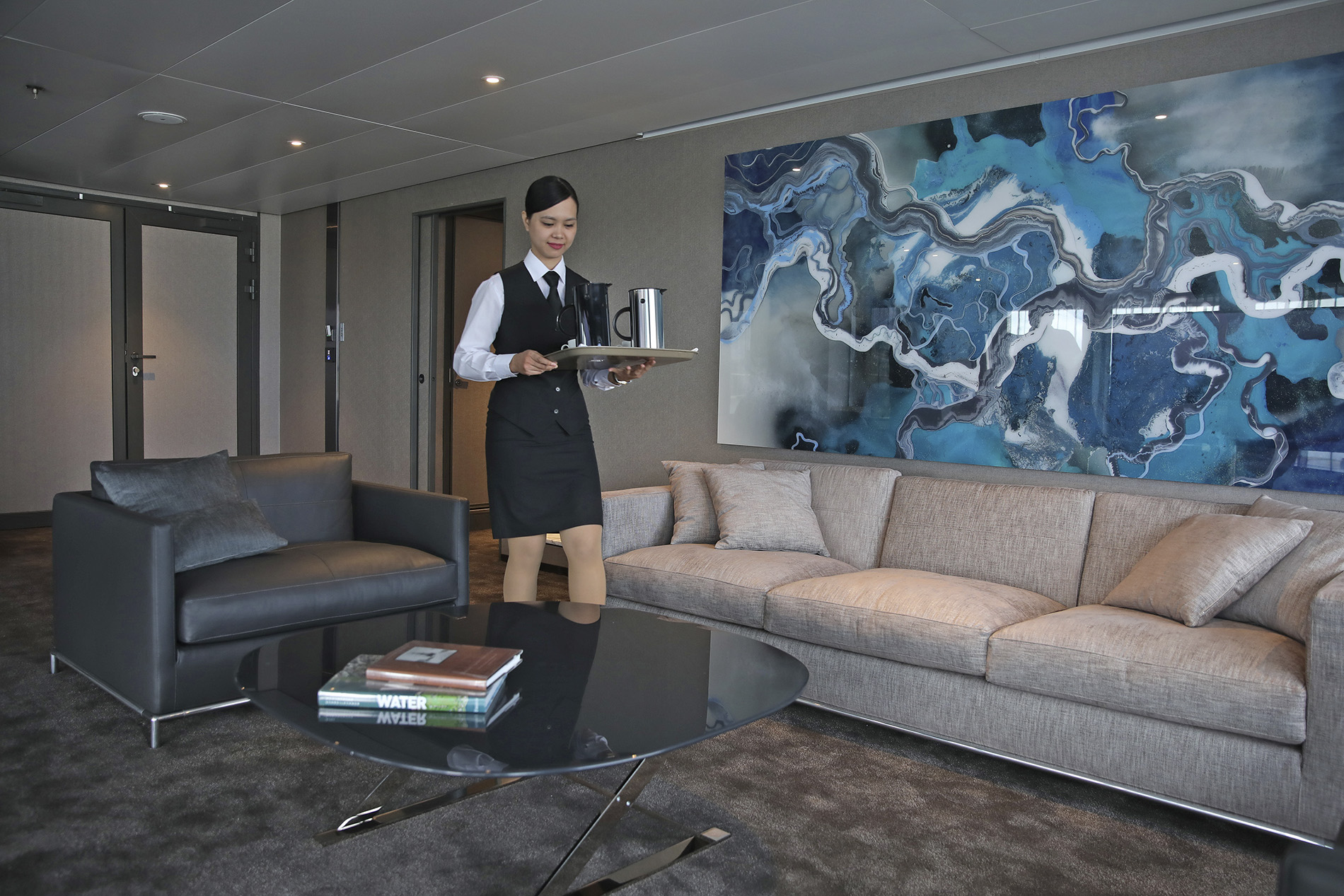
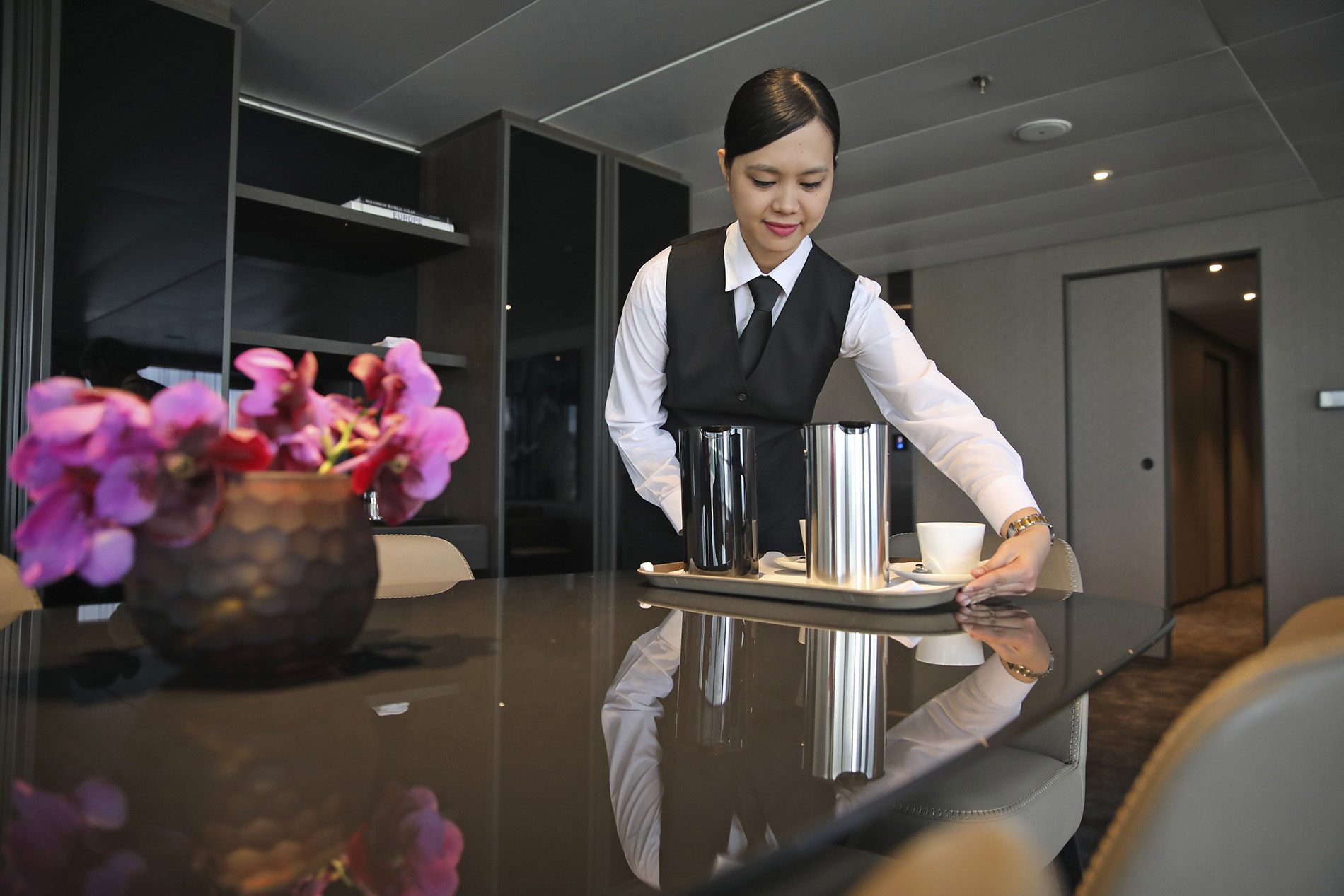
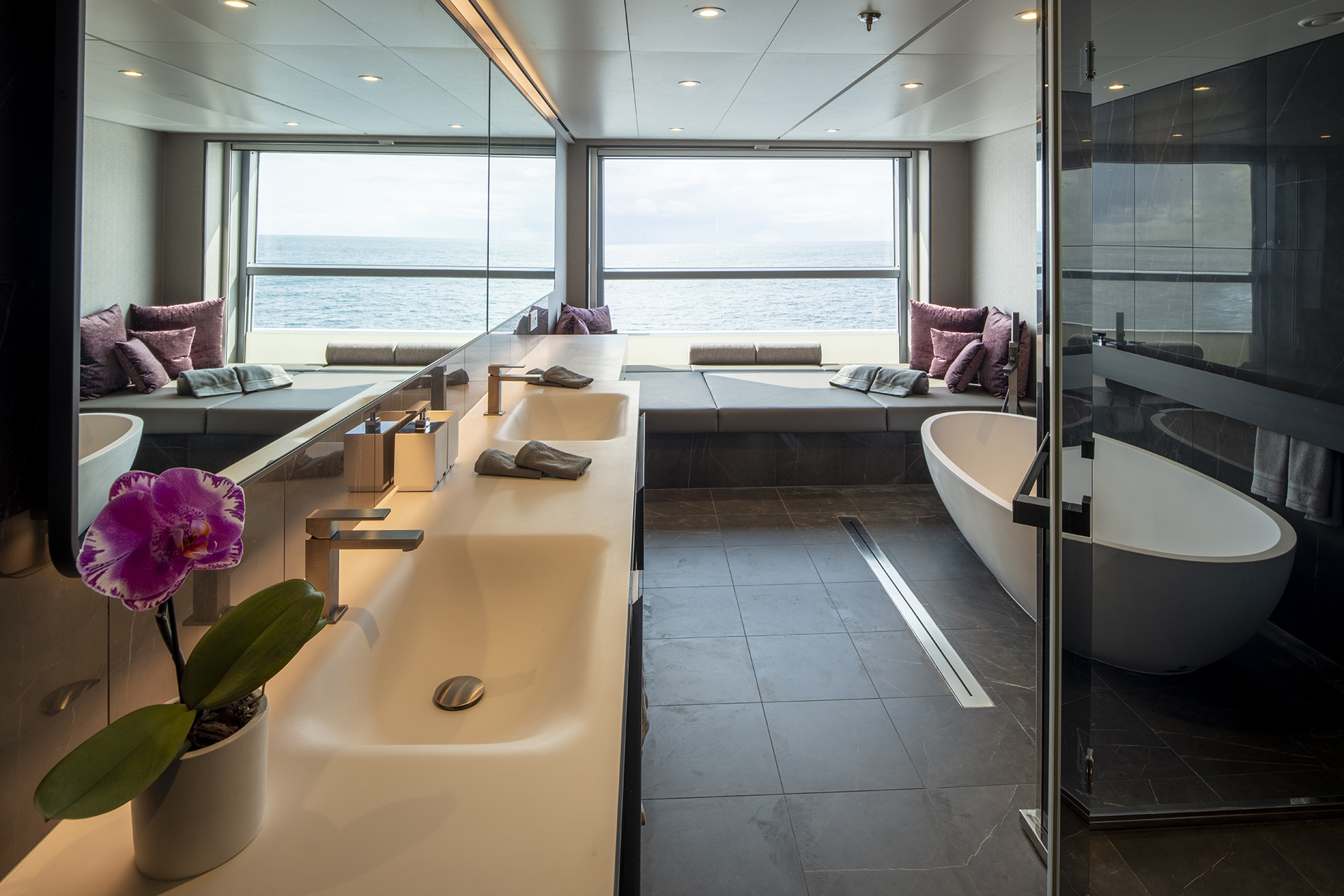
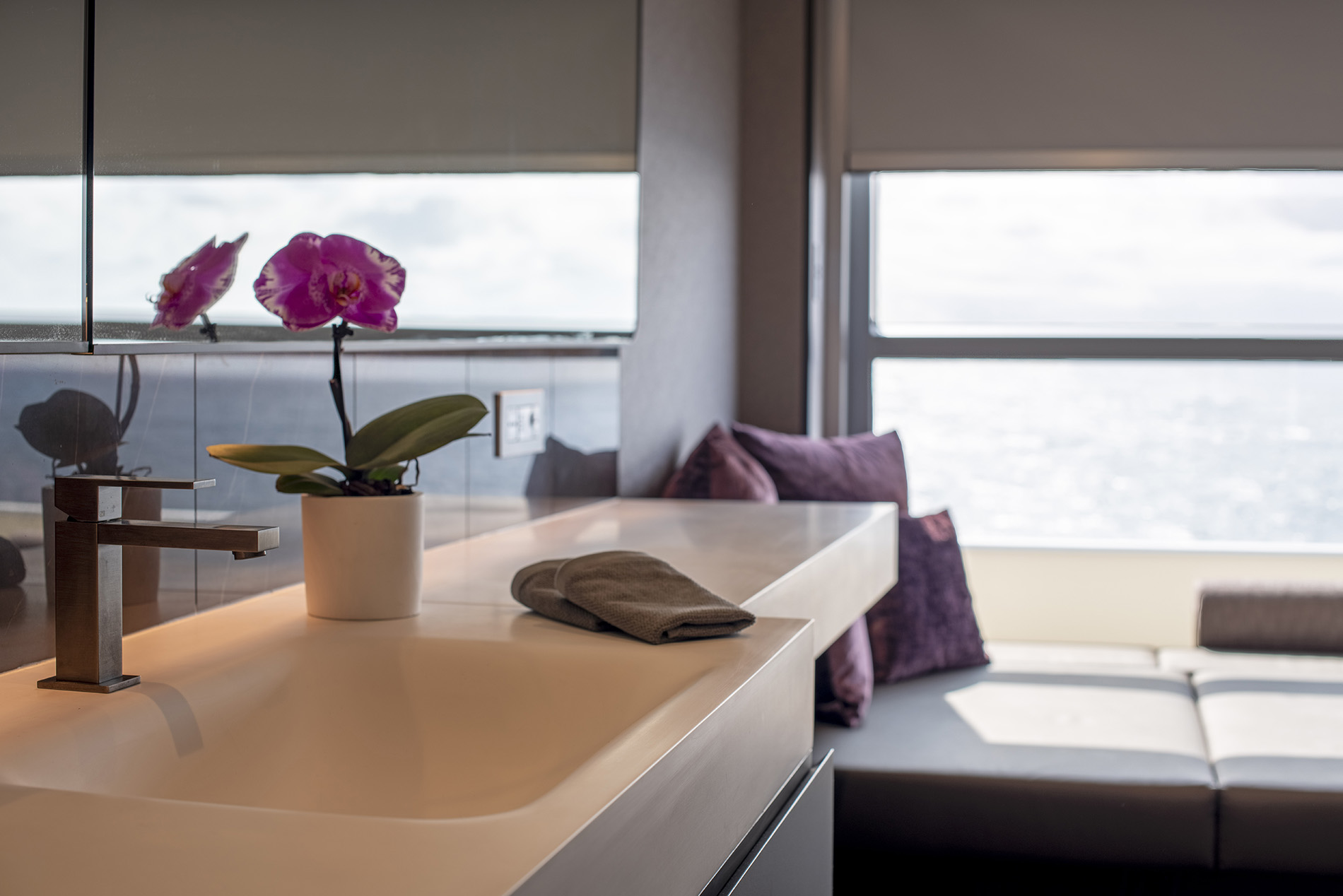
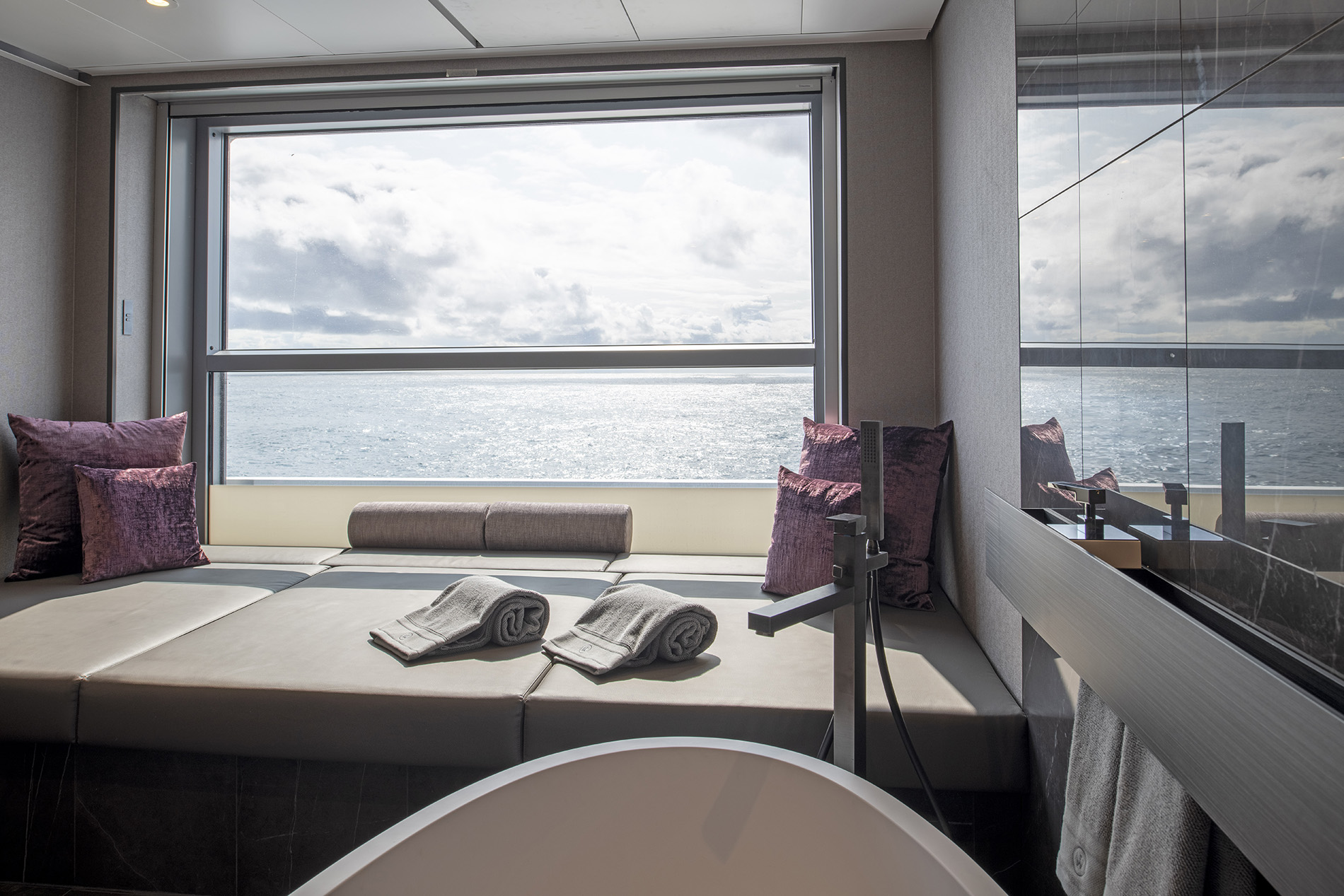
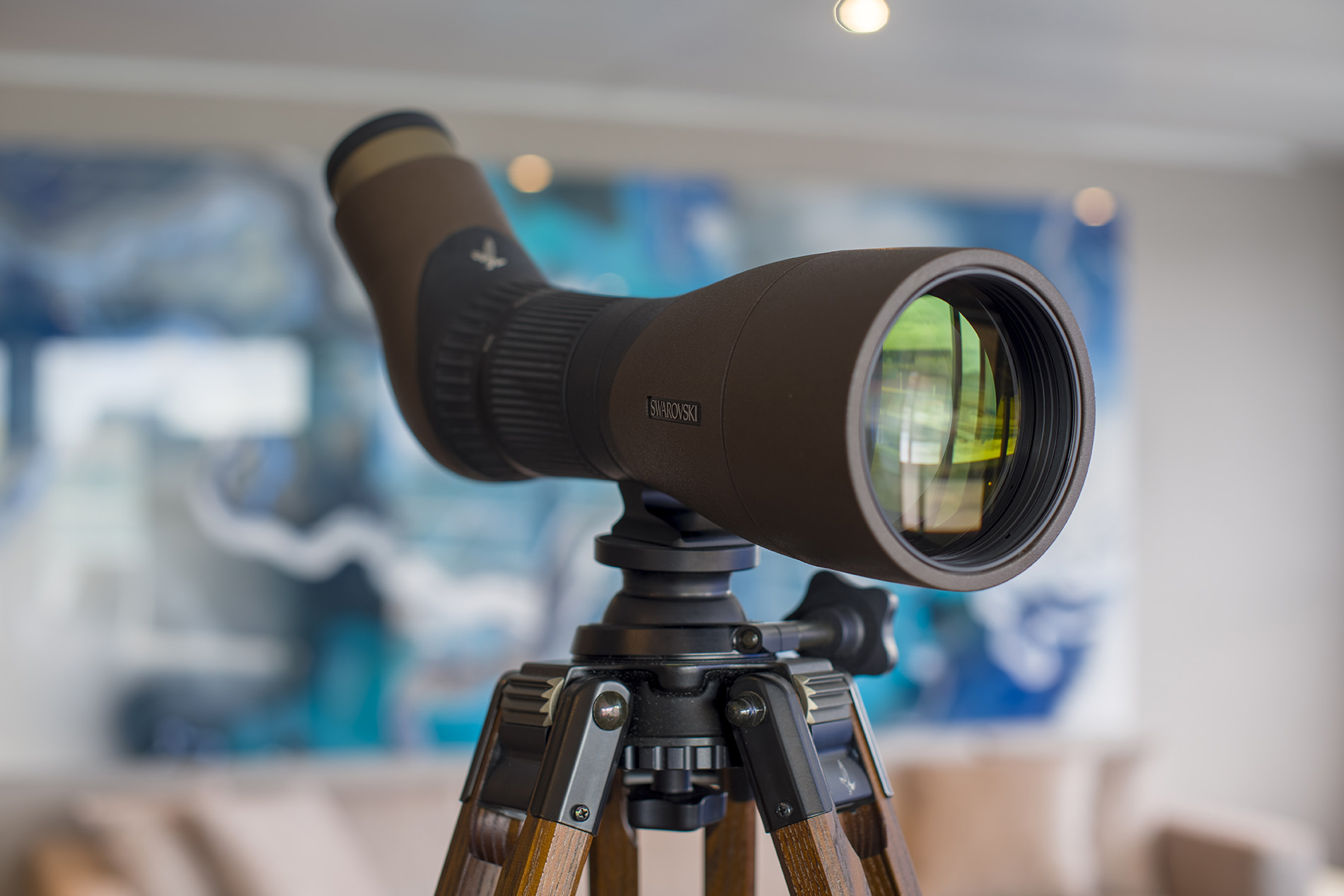
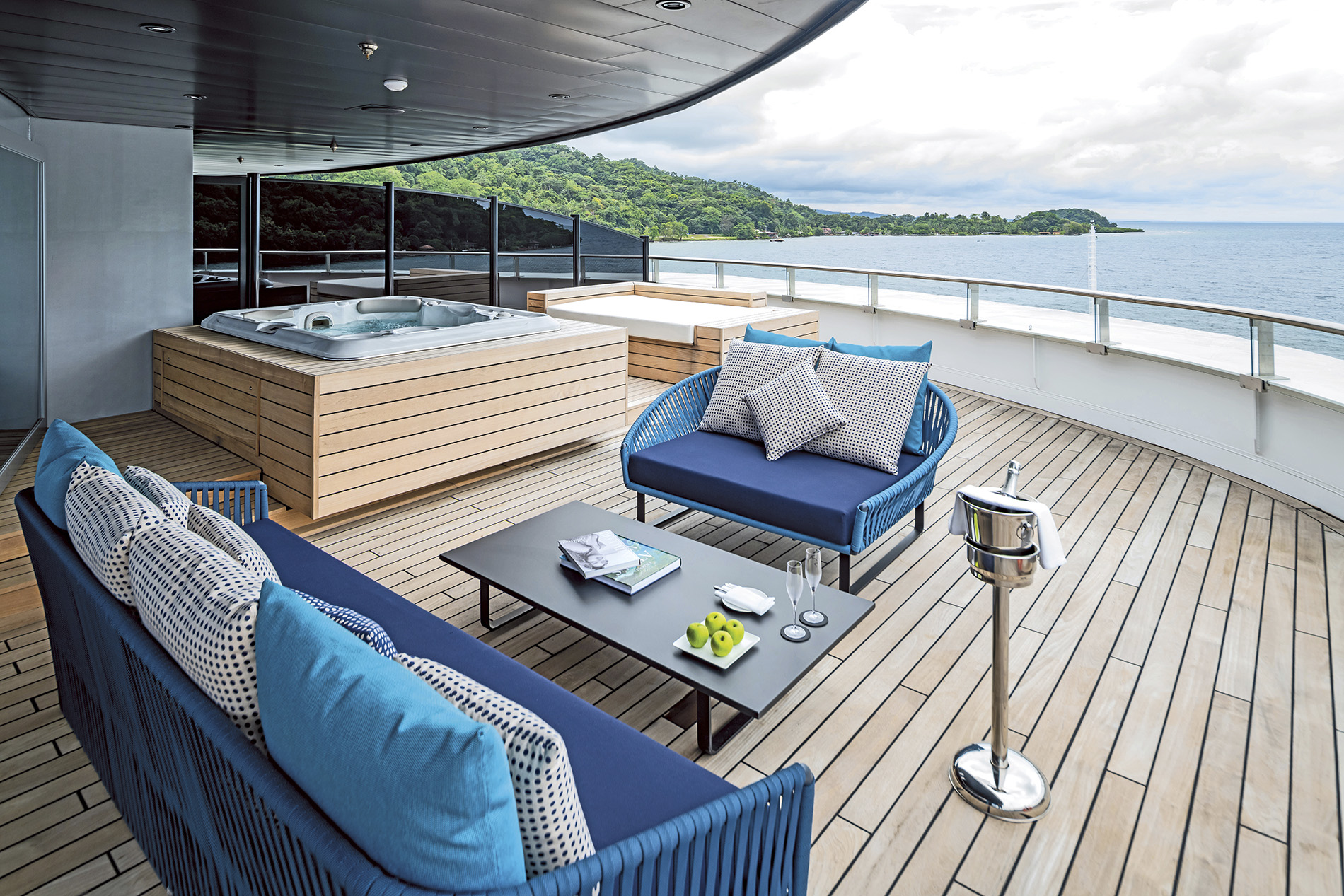
Marvel at incredible panoramic seascapes from the front of Scenic Eclipse as you relax on your spacious terrace in our luxurious Panorama Suites.
Located on Deck 6 and 8 at the front of the Discovery Yacht and overlooking the bow, these remarkable suites feature a spacious curved terrace, perfect for marvelling at incredible wildlife and landscapes.
Suite Features
Ranging in size from 105-110m², grandeur and style are taken to a whole new level in our Panorama and Grand Panorama Suites.
Suite names and amenities are the same across both Scenic Eclipse and Scenic Eclipse II, however, both have been thoughtfully curated to suit the cruising experience of these ships.
Separate Lounge & Bedroom
These grand suites include a host of special features and services. Curl up in your lounge with a kindle e-book from your in-suite library and sip your favourite aperitif, personally delivered by your butler. All before enjoying an intimate dining experience, in the plush and private surroundings of your suite. Even from the comfort of your bedroom, you’ll never miss a photo opportunity – accessing the outside world through your drop-down balcony window, with the gentle touch of a button, and with your in-suite binoculars.
Spacious Terrace
Your curved terrace is the perfect place to relax on a sun lounger and be the first to spot wildlife and incredible landscapes.
Luxurious Bathroom
The luxurious Panorama Suite bathrooms feature a vitality mist shower with colour light therapy, full bath, dual vanity, VIP amenities and Dyson hairdryer.
Priority Reservations & Embarkation
Guests in our Panorama Suites will enjoy the privilege of priority dining in the specialty restaurants as well as priority choice of Scenic Freechoice, Scenic Discovery, helicopter^ and submersible^ excursions. VIP embarkation and disembarkation are standard inclusions at the start and finish of your cruise.
Amenities & Features
- Spacious terrace with sun loungers and in-suite binoculars for optimal viewing
- Bedroom suite with luxury king size Scenic Slumber Bed, reading alcove, walk-in robe, desk, ambient lighting options and HDTV
- Spacious bathroom with vitality mist shower with colour light therapy, full bath, dual vanity, VIP amenities and Dyson hairdryer
- Personalised butler service, in-suite beverage and dining service
- Separate lounge and dining area with a four-seat dining table, cinema surround HDTV with Bose® speakers
- A full complementary mini-bar stocked with wines, Champagne and spirits personalised to your preference, including illy coffee and specialty teas re-stocked daily
- Complimentary laundry service~
- Priority dining in specialty restaurants and guaranteed dining reservations
- Priority choice of shore excursions
- VIP embarkation and disembarkation
- Advanced Heating, Ventilation and Air-Conditioning system (HVAC) provides 100% fresh air
- The highest sound insulation as per the marine class society Bureau Veritas
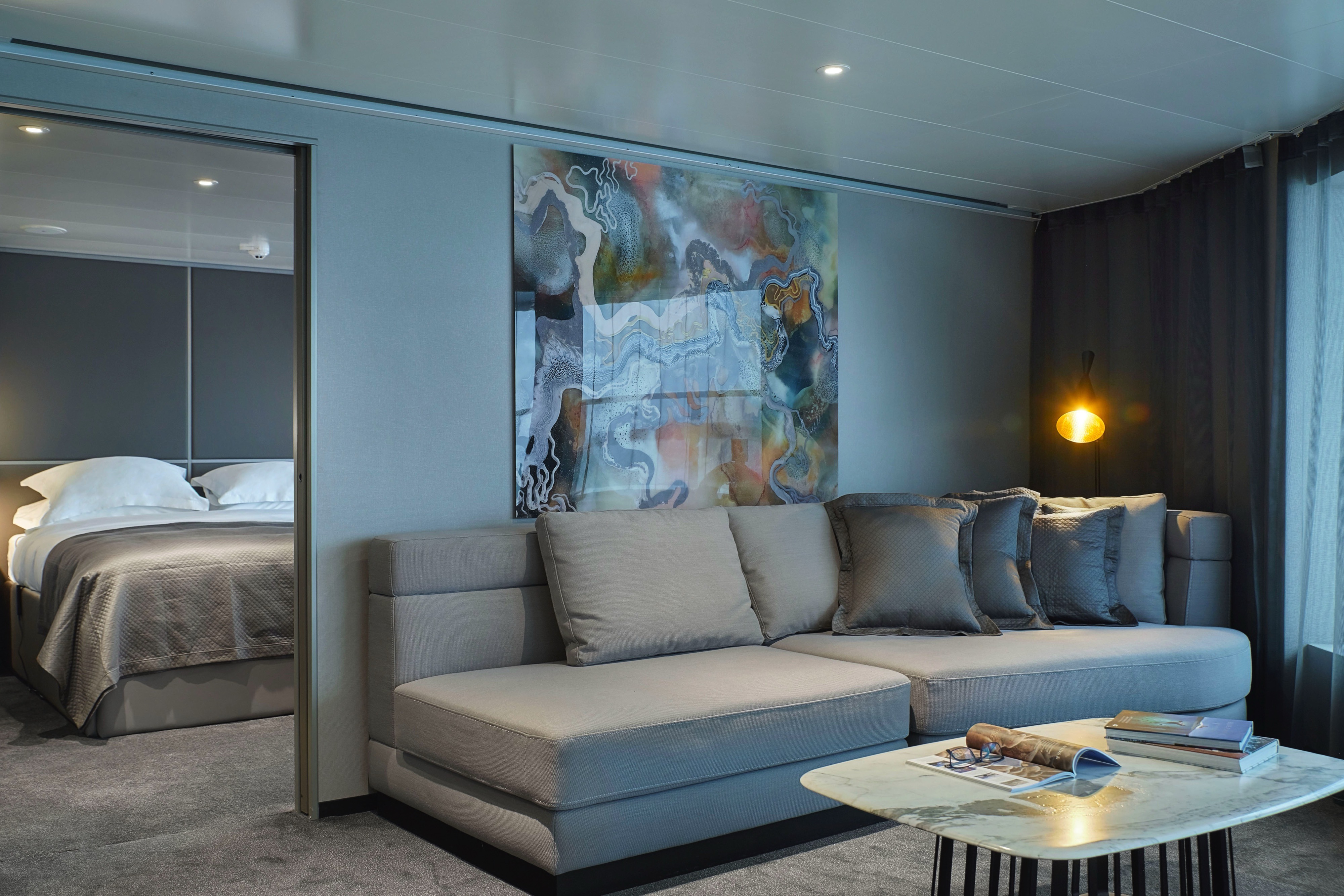
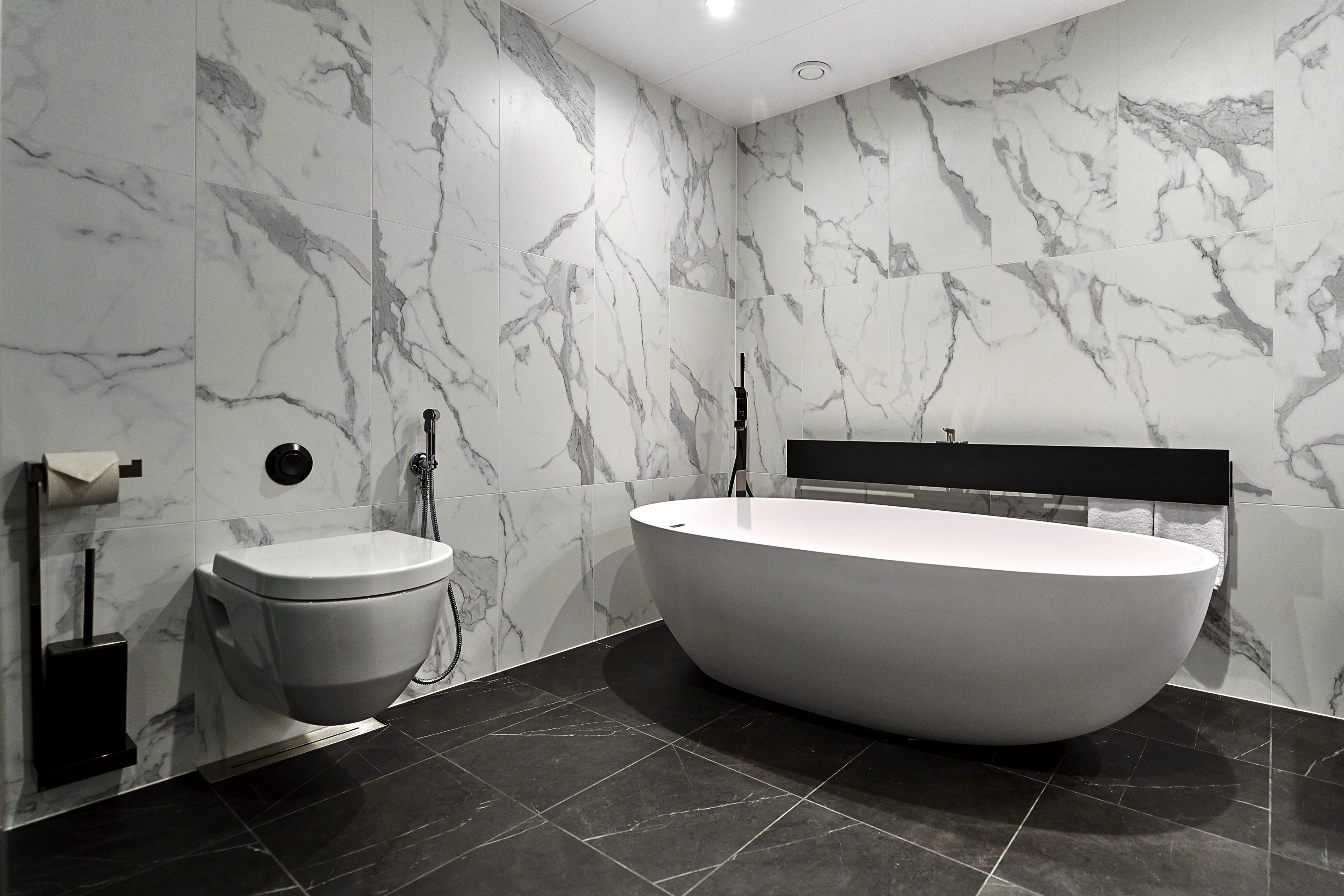
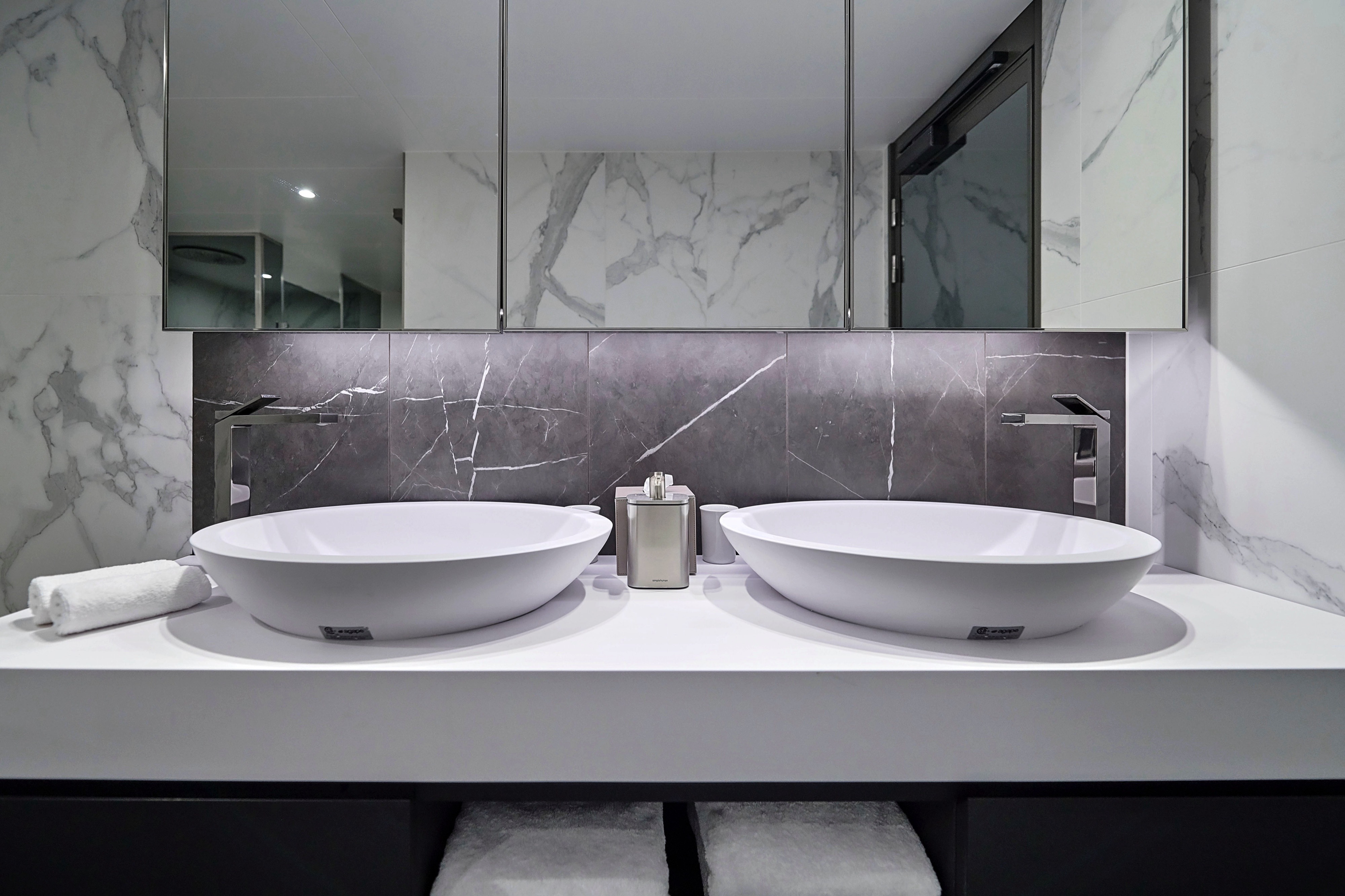
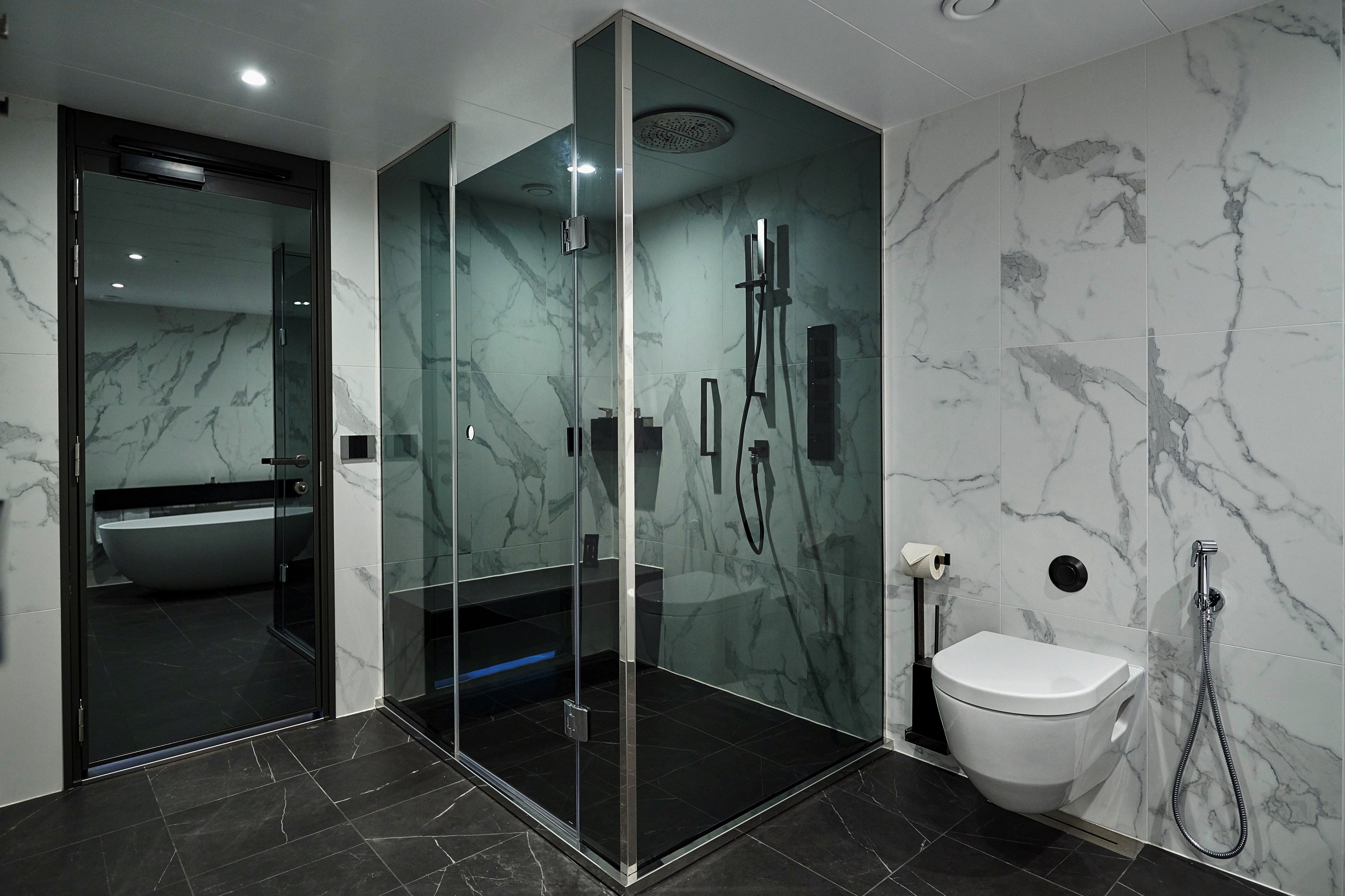
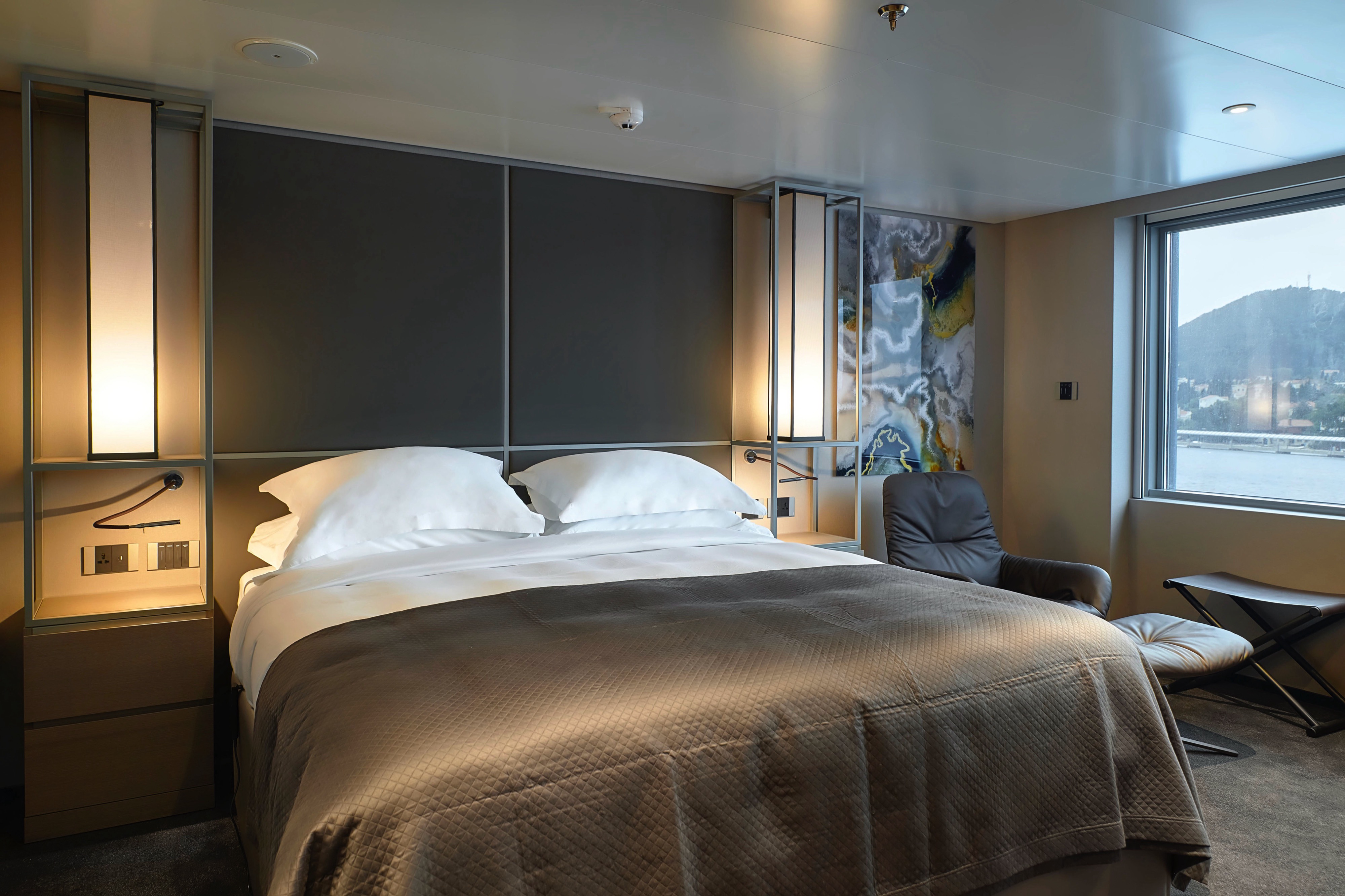
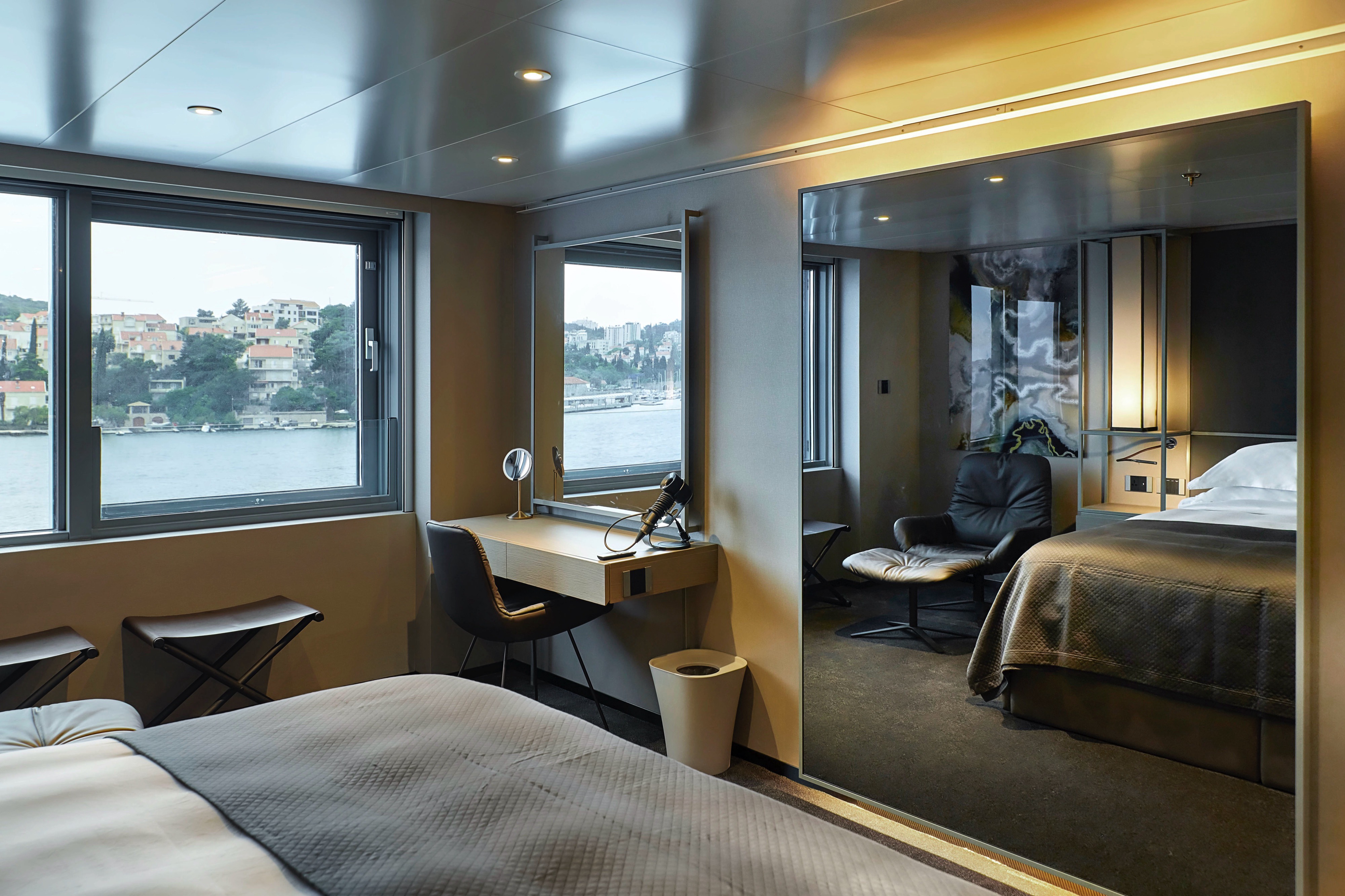
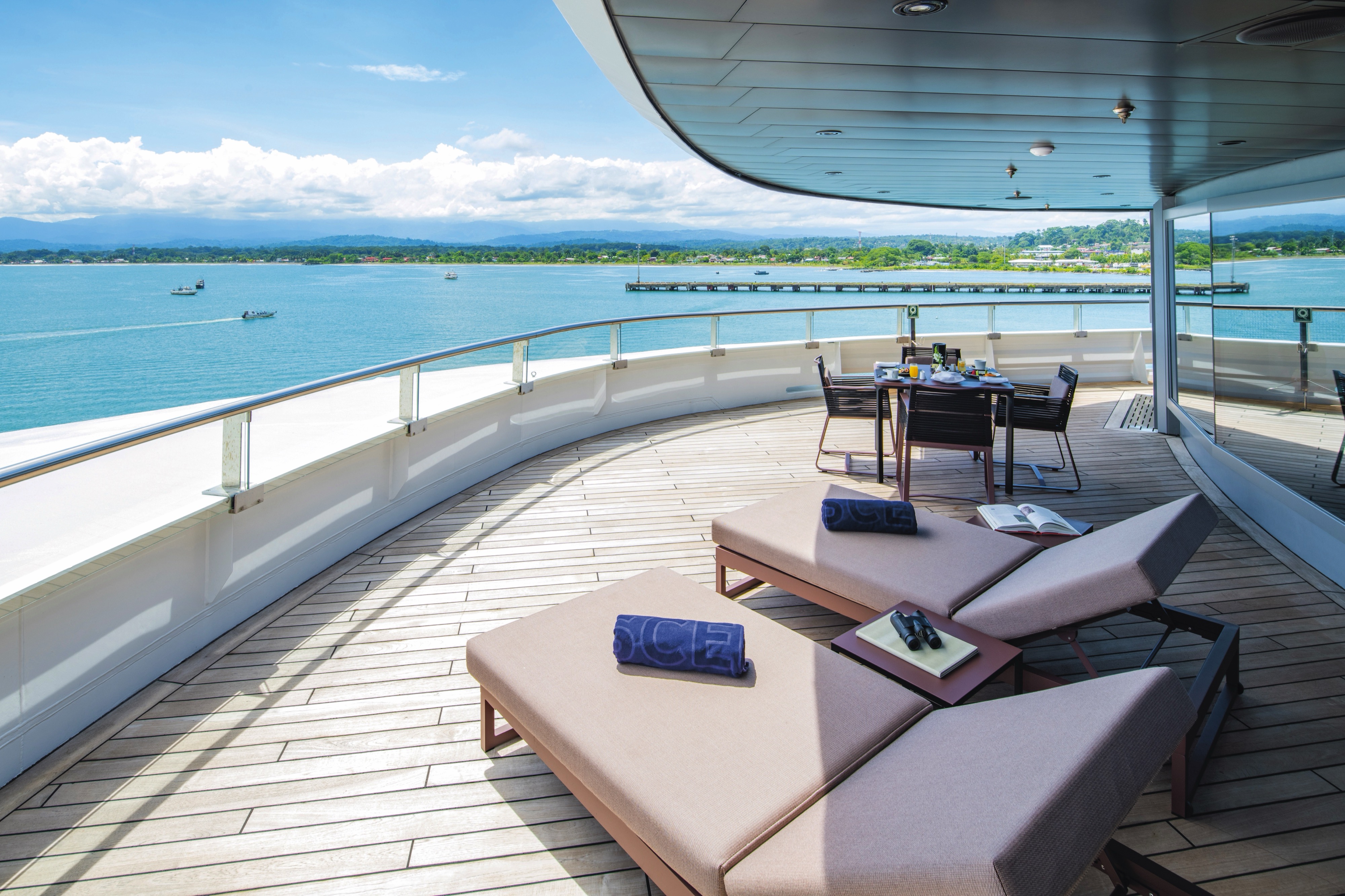
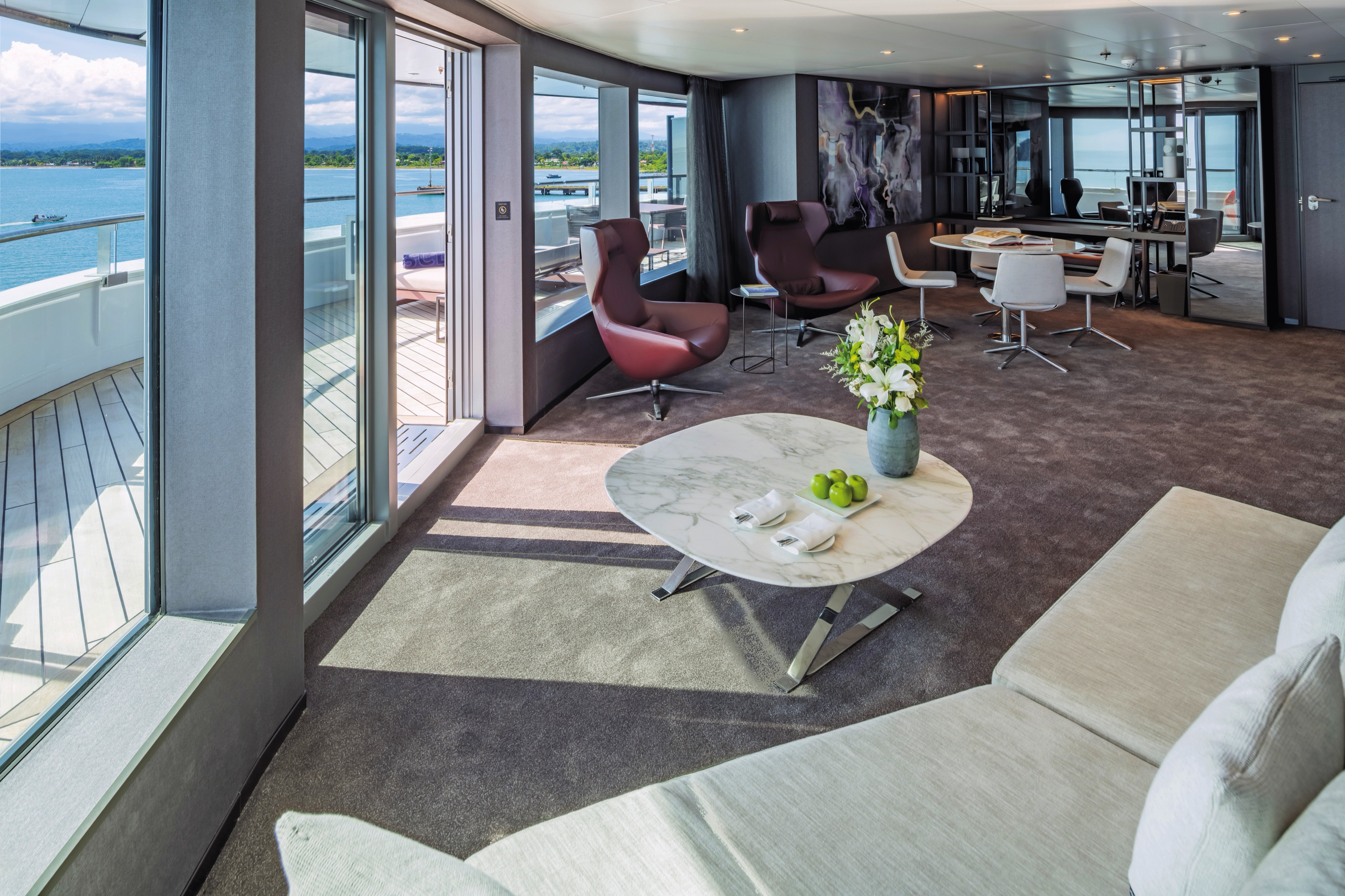
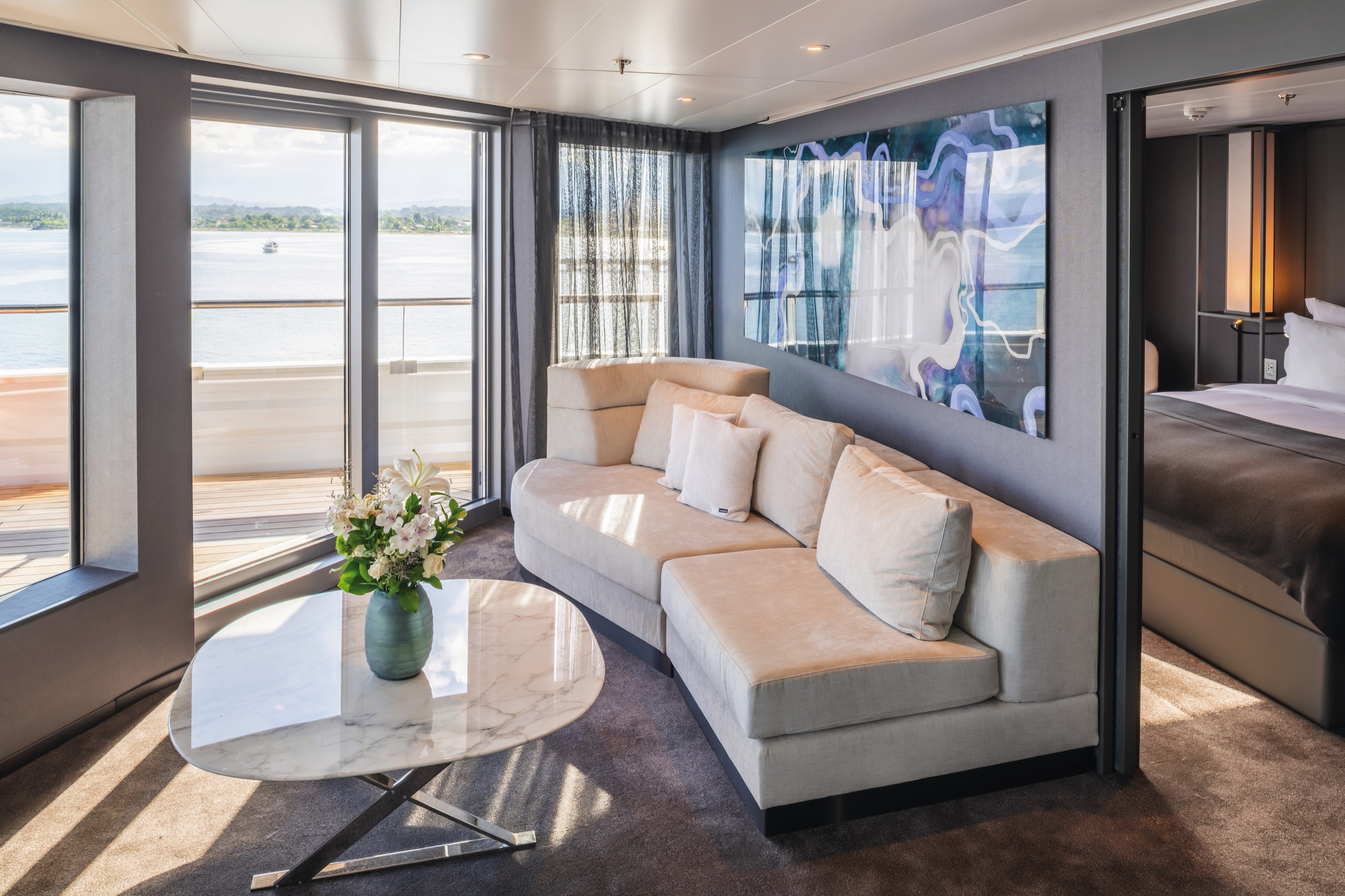
Imagine returning from an exhilarating day of all-inclusive excursions to your private hideaway and relaxing in your luxurious spa bath. Our indulgent Spa Suites will provide the ultimate rejuvenation.
Suite Features
Ranging in size from 46-50m², our Spa Suites are located on Deck 8 and 9.
Suite names and amenities are the same across both Scenic Eclipse and Scenic Eclipse II, however, both have been thoughtfully curated to suit the cruising experience of these ships.
Lounge and Sleeping Area
With a premier location on the higher Decks 8 and 9 and an impressive 46-50m2 in size, our opulent Spa Suites provide the most inviting of ultra-luxury retreats. Featuring a separate sleep zone with a four-poster king-size Scenic Slumber Bed, a lounge area as well as a private verandah, they are the perfect retreat after a day of discovery.
Luxurious Spa
Step into the private sanctuary of your Spa Suite and soak in a steaming bath drawn by your butler. Gaze out over your verandah to the vistas beyond and sip on a glass of Champagne – heaven.
Scenic Eclipse I features the signature double-sized Philippe Starck-designed spa bath, while Scenic Eclipse II offers a luxurious circular spa bath overlooking your verandah. Exclusive to these suites, the baths provide the perfect way to rejuvenate after your day of activities.
There are variations between the Spa Suite configurations on Scenic Eclipse I and II, and these distinctions are subject to the respective ship's specifications and design.
Private Verandah
Your private verandah is the perfect place to unwind. Be immersed in the tranquillity of the sea or be the first to catch sight of wildlife and breathtaking landscapes.
Amenities & Features
- Luxury king-size Scenic Slumber Bed, separate sleeping zone and lounge area with reading chair
- An expansive bathroom with a rectangular spa bath on Scenic Eclipse I and circular spa bath on Scenic Eclipse II
- A steam shower, with oversized head and soothing light therapy
- Dual vanity basins, luxurious amenities and Dyson hairdryer
- Walk-in robe
- A full complimentary mini-bar stocked with wines, Champagnes and spirits personalised to your preference, including illy coffee and specialty teas re-stoked daily.
- Personalised butler service
- Complimentary laundry service~
- Guaranteed dining reservations
- Priority choice of shore excursions
- VIP embarkation and disembarkation
- Advanced Heating, Ventilation and Air-Conditioning system (HVAC) provides 100% fresh air
- The highest sound insulation as per the marine class society Bureau Veritas
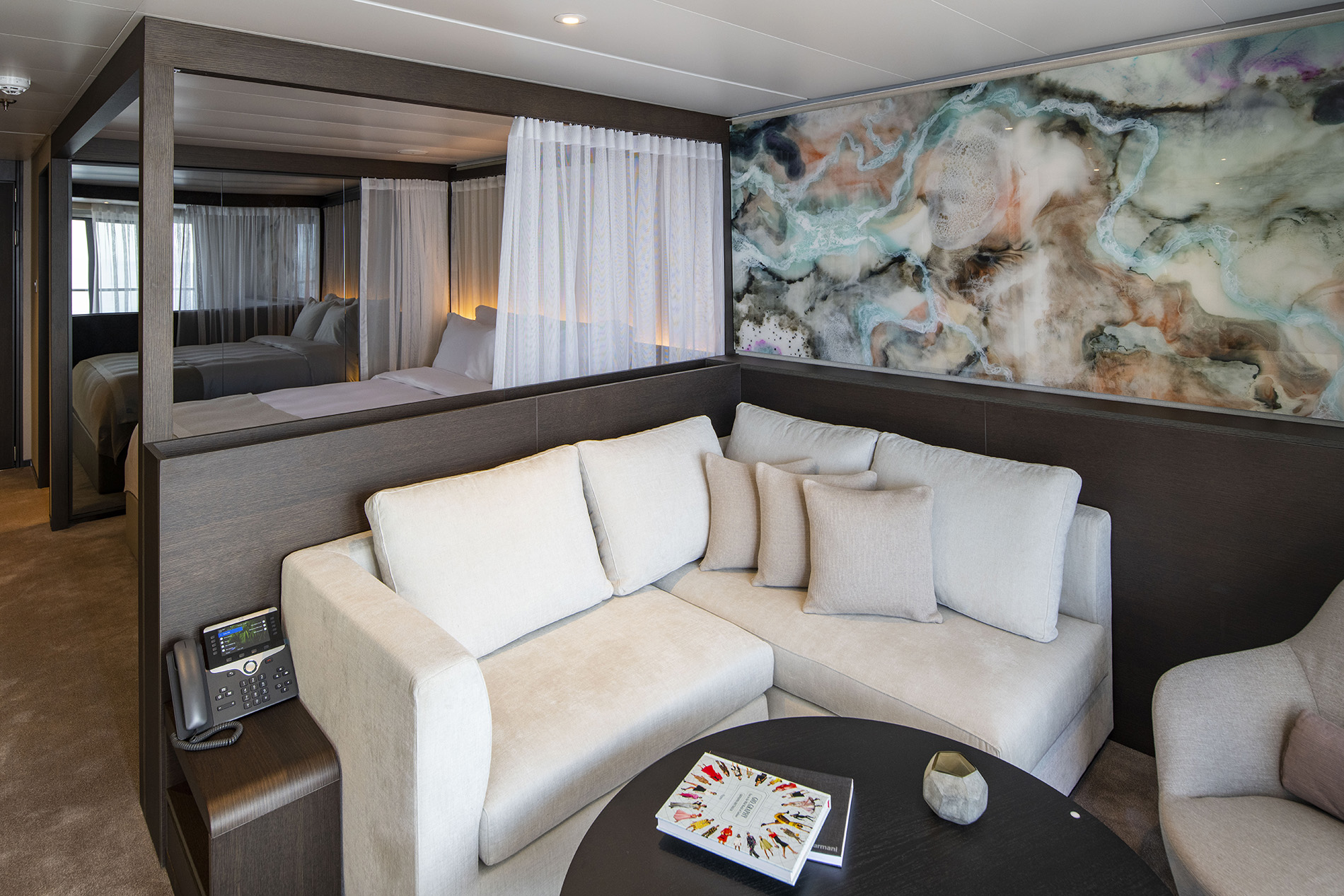
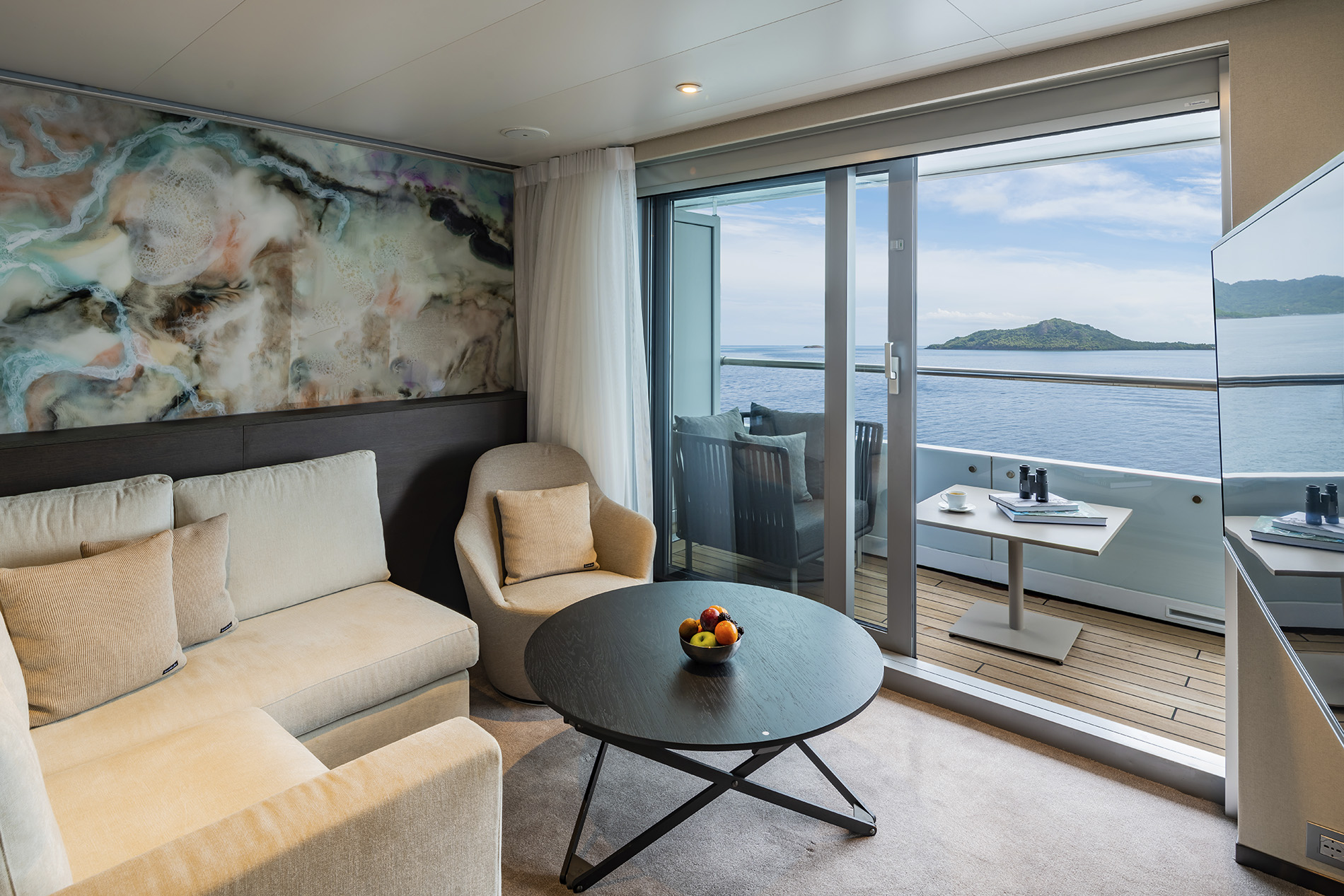
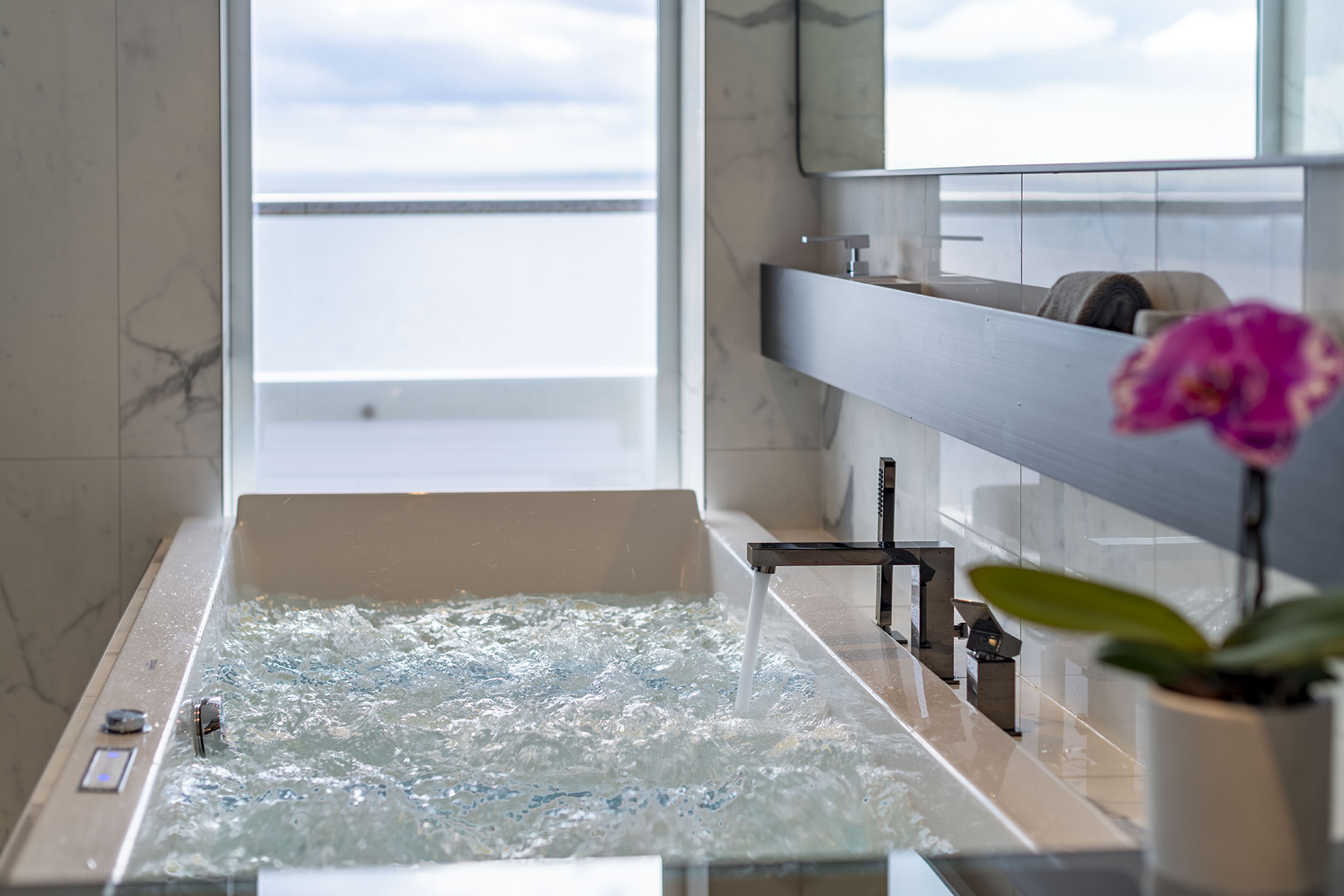
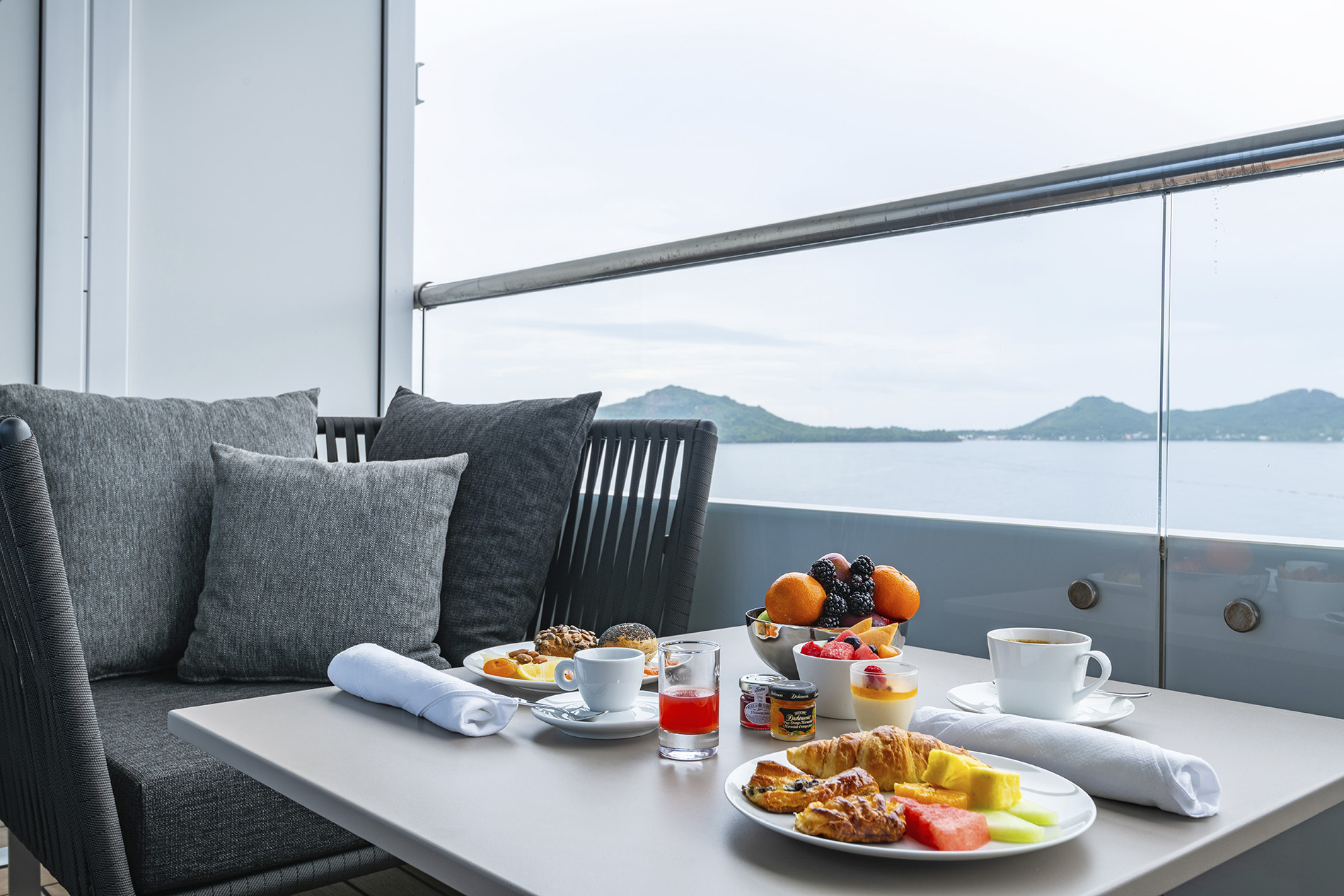
Our generously-sized Grand Deluxe Verandah Suites are your own private hideaway, furnished with the finest ultra-luxury amenities, including a plush king-size bed, pillow menu, walk-in wardrobe and a lounge area to relax in after a day of discovery.
Suite Features
Ranging in size from 32 - 34m², located on Deck 5 to 8, each suite includes:
Lounge & Sleeping Area
Your private hideaway is furnished with the finest ultra-luxury amenities, including plush king-size bed, pillow menu and a lounge area where you can relax after a day of discovery.
Private Verandah
Admire your window to the world. These incredibly spacious and thoughtfully designed suites feature floor-to-ceiling sliding glass doors that open onto sprawling vistas, spectacular seascapes and marvellous marine life. Your private verandah or terrace is the perfect place to unwind as a new world of wonder moves by.
Amenities & Features
- A private verandah with in-suite binoculars for optimal viewing
- Luxury king-size Scenic Slumber Bed
- Separate sleeping zone and lounge area
- En-suite bathroom with shower and vanity
- Luxury bathroom amenities and Dyson hairdryer
- Ambient lighting options
- Personalised butler service
- A full complimentary mini-bar stocked with wines, Champagne and spirits personalised to your preference, including illy coffee and specialty teas re-stocked daily
- In-suite beverage and dining service
- HDTV entertainment system and Bose® speakers
- Advanced Heating, Ventilation and Air-Conditioning system (HVAC) provides 100% fresh air
- The highest sound insulation as per the marine class society Bureau Veritas
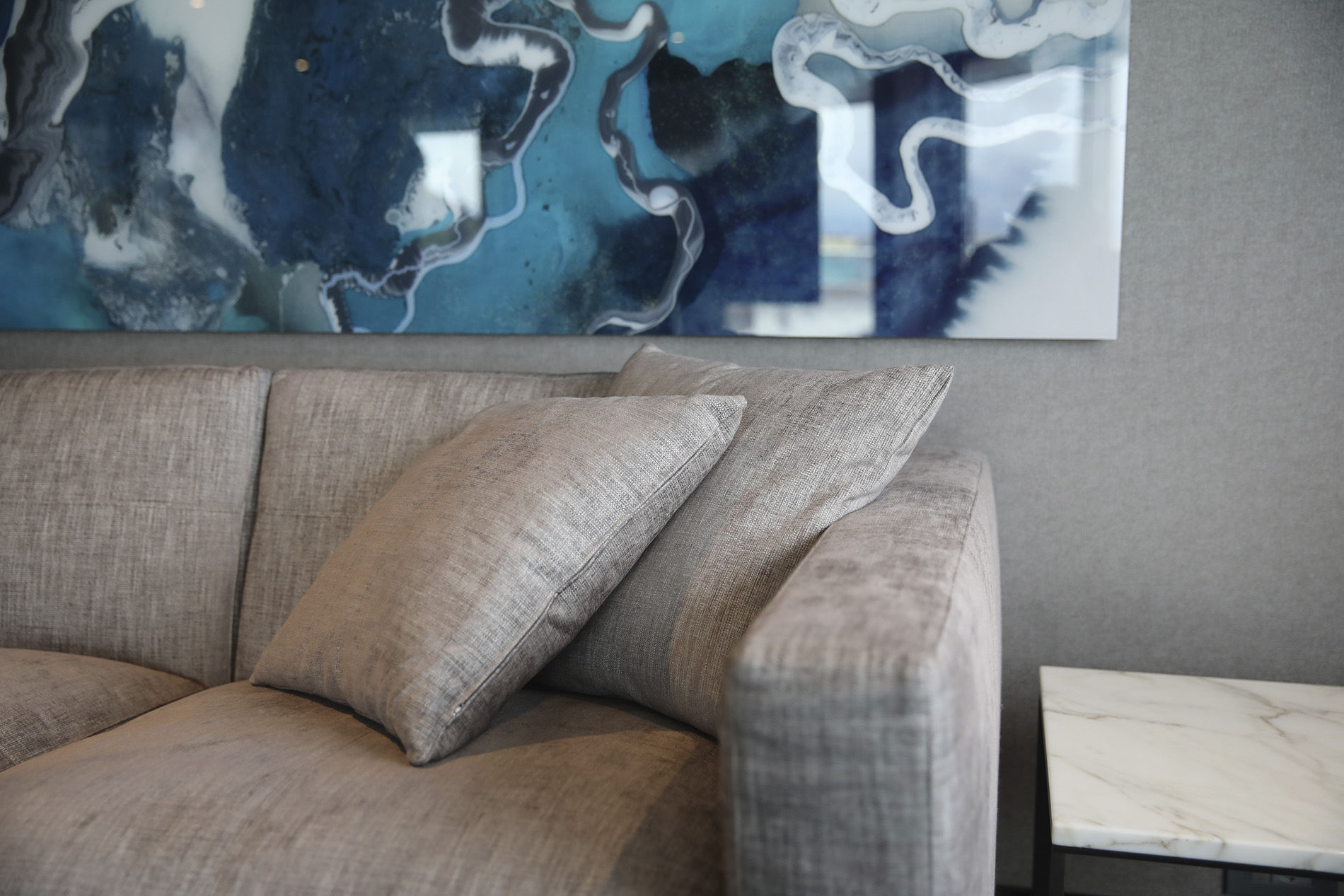
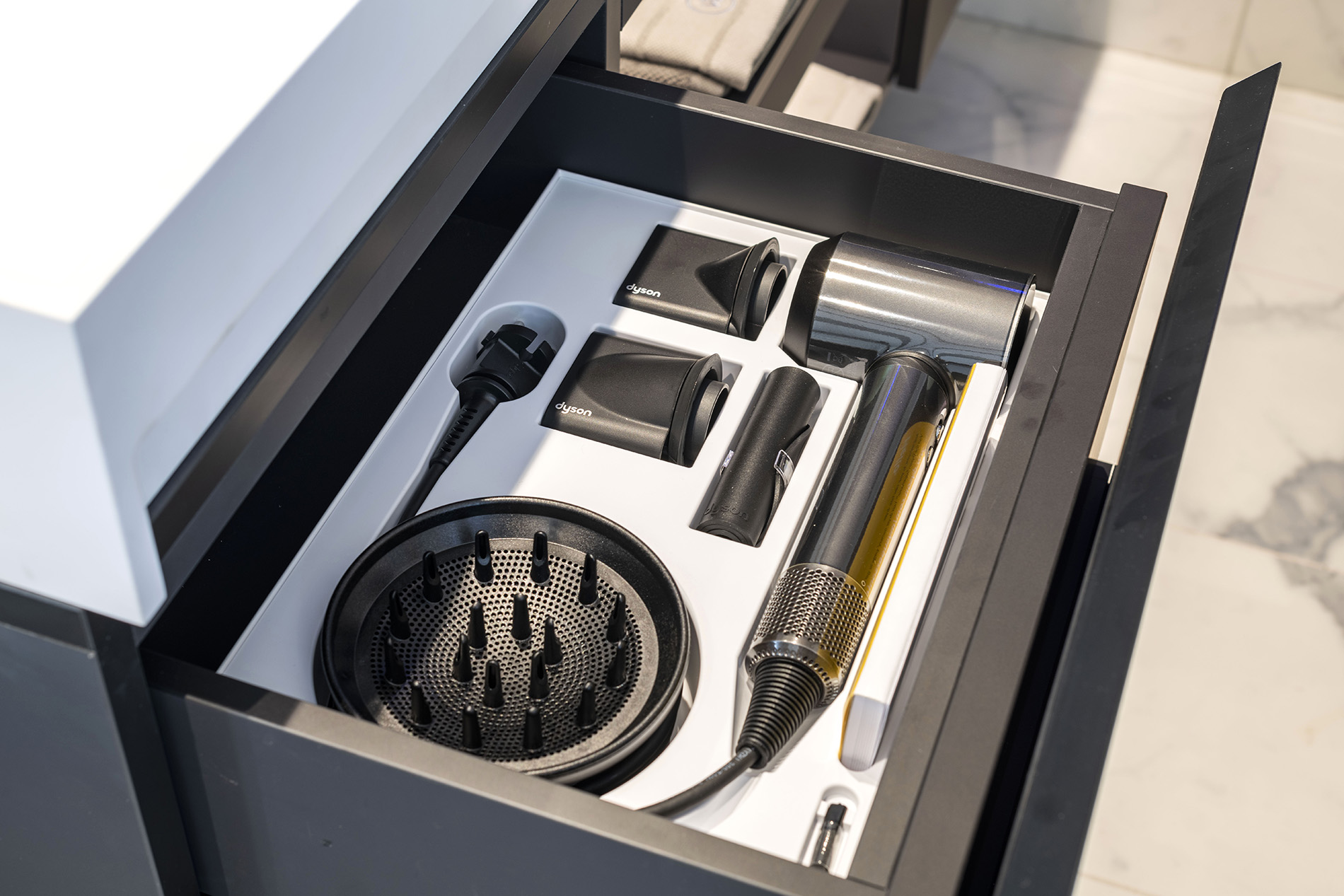

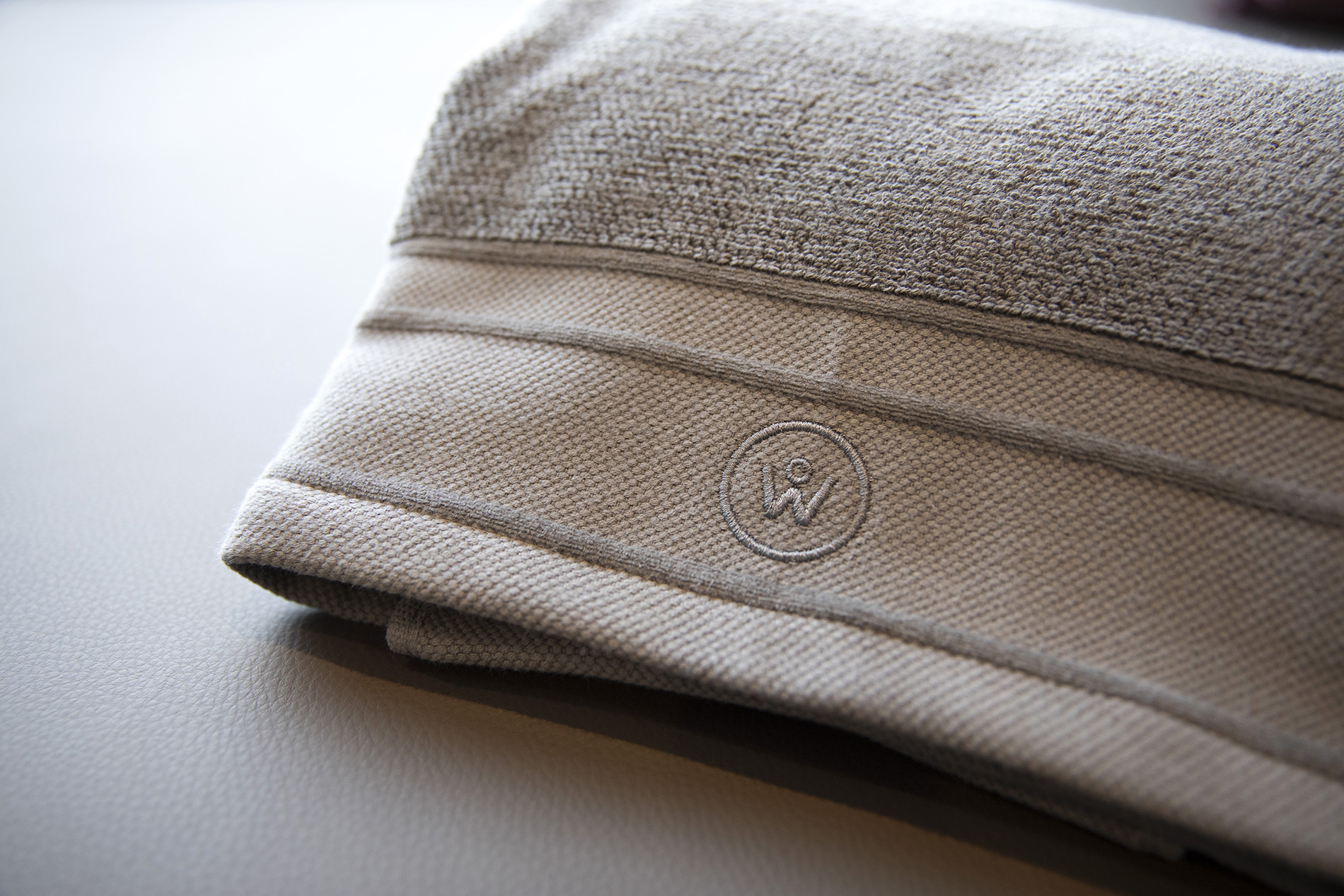
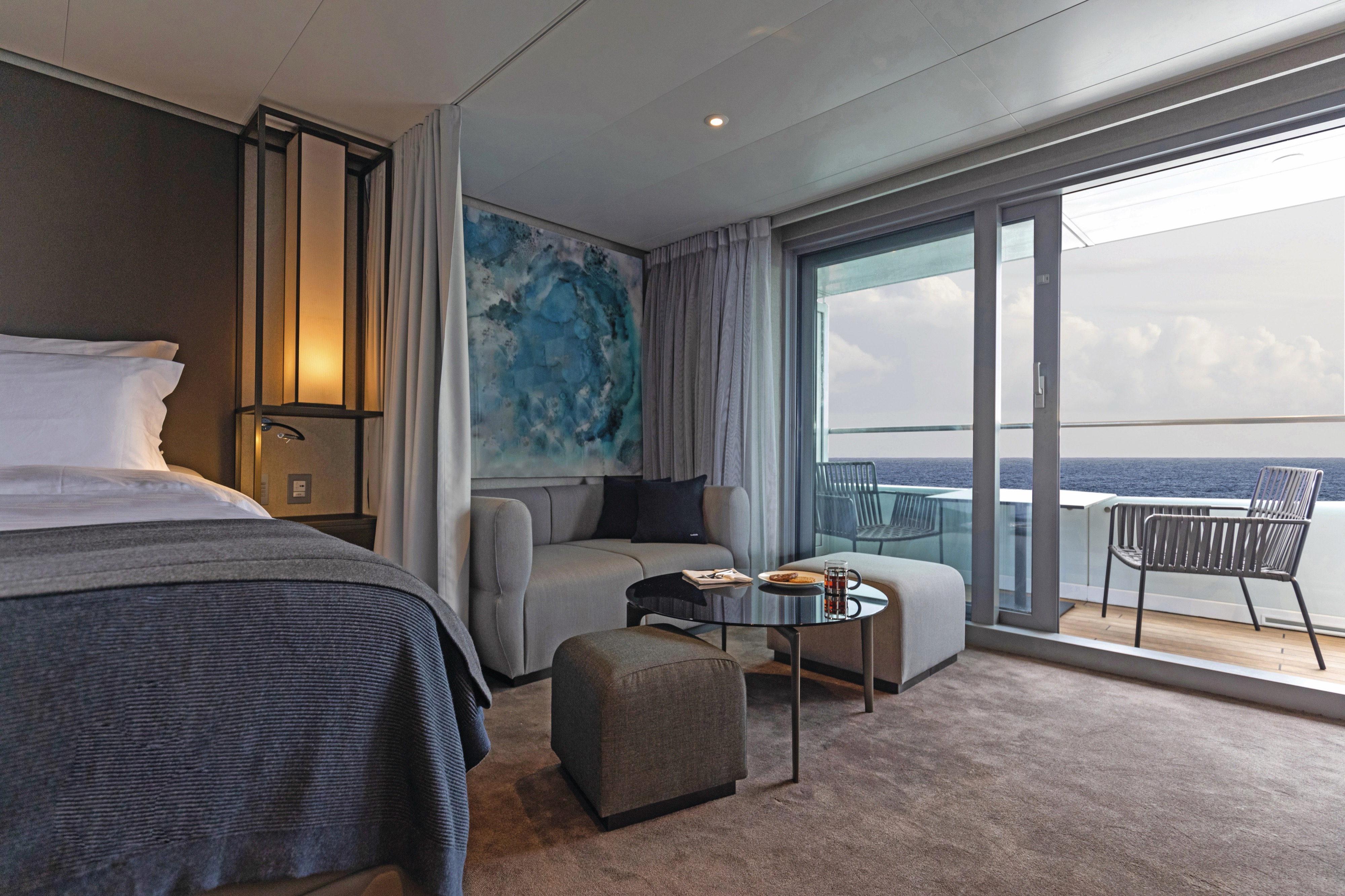
Our spacious Verandah & Deluxe Verandah Suites are thoughtfully designed with floor-to-ceiling sliding glass doors that open onto a private verandah or terrace. Enjoy unwinding in the separate lounge area with your choice of refreshment.
Suite Features
Ranging in size from 32 - 34m², located on Deck 5 to 8, each suite includes:
Lounge & Sleeping Area
Your private hideaway is furnished with the finest ultra-luxury amenities, including plush king-size bed, pillow menu and a lounge area where you can relax after a day of discovery.
Private Verandah
Admire your window to the world. These incredibly spacious and thoughtfully designed suites feature floor-to-ceiling sliding glass doors that open onto sprawling vistas, spectacular seascapes and marvellous marine life. Your private verandah or terrace is the perfect place to unwind as a new world of wonder moves by.
Amenities & Features
- A private verandah with in-suite binoculars for optimal viewing
- Luxury king-size Scenic Slumber Bed
- Separate sleeping zone and lounge area
- En-suite bathroom with shower and vanity
- Luxury bathroom amenities and Dyson hairdryer
- Ambient lighting options
- Personalised butler service
- A full complimentary mini-bar stocked with wines, Champagne and spirits personalised to your preference, including illy coffee and specialty teas re-stocked daily
- In-suite beverage and dining service
- HDTV entertainment system and Bose® speakers
- Advanced Heating, Ventilation and Air-Conditioning system (HVAC) provides 100% fresh air
- The highest sound insulation as per the marine class society Bureau Veritas




Scenic Eclipse II
Discovery Yacht Cruising
Whether cruising the polar landscapes of East Antarctica or gliding through the picturesque waters of the South Pacific and Asia, Scenic Eclipse II is equipped with state-of-the-art technology to deliver unrivalled experiences in all destinations and for all seasons.
By combining world-class design with spacious suites, a diverse array of culinary and wellness experiences, and immersive exploration, Scenic Eclipse II sets the new benchmark in ultra-luxury ocean cruising.
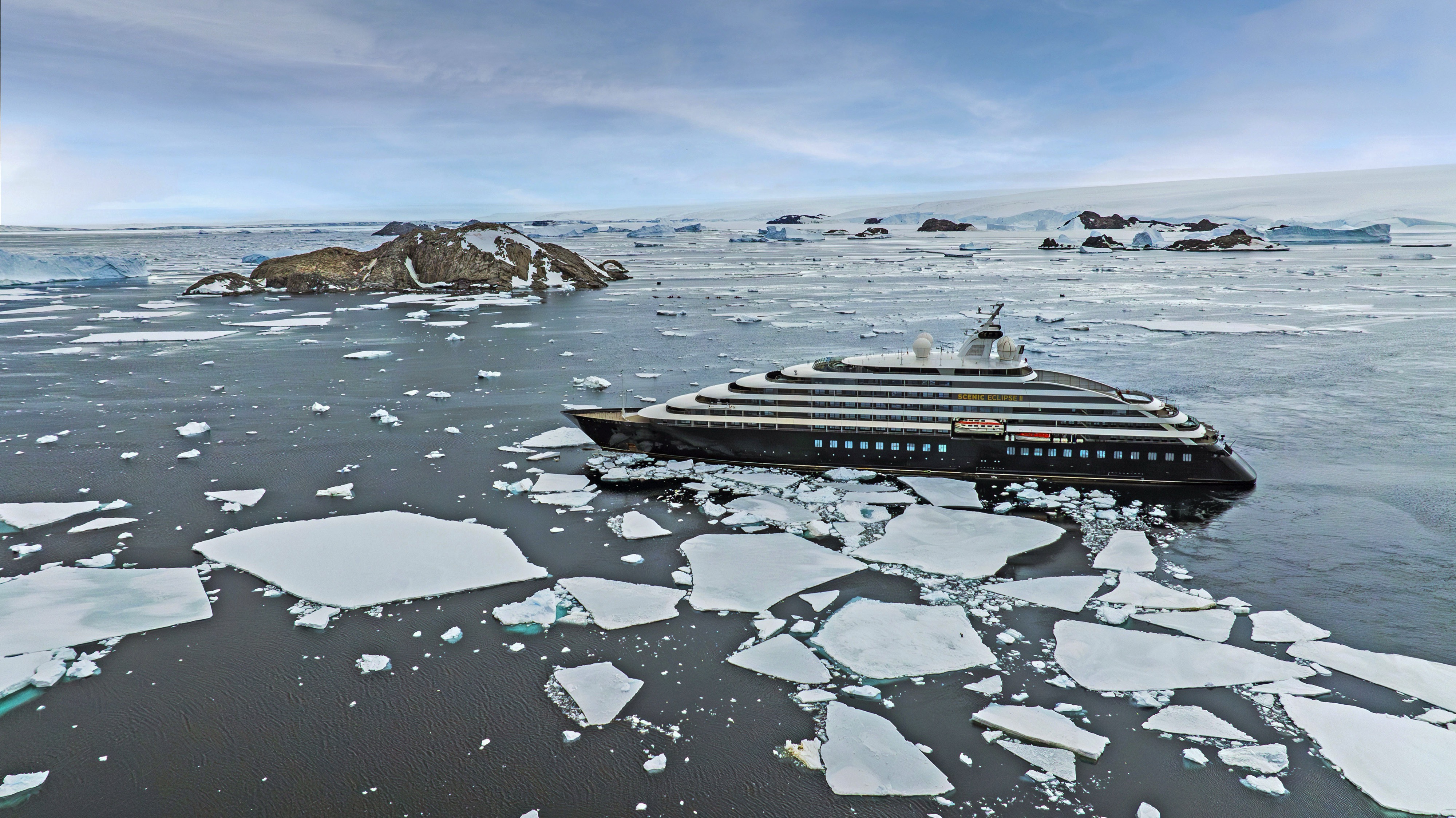
Ship Facts
| Launch Year | 2023 | ||||||||||
| Refit Year | |||||||||||
| Language | en-US | ||||||||||
| Gross Tonnage | 17545 | ||||||||||
| Length | 168 | ||||||||||
| Width | 22 | ||||||||||
| Currency | USD | ||||||||||
| Speed | 17 | ||||||||||
| Capacity | 228 | ||||||||||
| Crew Count | 176 | ||||||||||
| Deck Count | 8 | ||||||||||
| Cabin Count | 114 | ||||||||||
| Large Cabin Count | 0 | ||||||||||
| Wheelchair Cabin Count | 0 | ||||||||||
| Electrical Plugs |
|
Deck 10
- Sky Bar
- Sky Deck Vitality Pool
- Cabanas
- Elevator
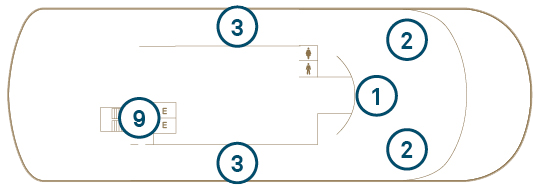
Deck 9
Owner's Penthouse Suite
- Two bedroom Penthouse Suite
- Spa Suite
- Elevator
- Helicopter Hangars
- Helipad

Deck 8
- Panorama Suite
- Spa Suite
- Grand Deluxe Verandah Suite
- Deluxe Verandah Suite
- Verandah Suite
- Helicopter Hangars
- Helipad
- Elevator

Deck 7
- Grand Deluxe Verandah Suite
- Deluxe Verandah Suite
- Verandah Suite
- Yacht Club
- Hanging Chairs
- Elevator
- Yoga & Pilates Room
- Gym & Fitness Area
- Wheelhouse

Deck 6
Grand Panorama Suite
- Grand Deluxe Verandah Suite
- Deluxe Verandah Suite
- Verandah Suite
- Elevator
- Spa Vitality Pool
- Senses Spa

Deck 5
Grand Deluxe Verandah Suite
- Deluxe Verandah Suite
- Verandah Suite
- Elevator
- Lumière
- Azure Bar & Café
- Scenic Épicure
- Observation Lounge & Library
- Observation Terrace
- Marina Entrance

Deck 4
Elevator
- Koko's
- Sushi & Sake Bar
- Chef's Table
- Elements
- Guest Services
- Scenic Lounge & Bar
- Boutique
- Theatre
- Discovery Lounge

Deck 3
Elevator
- Marina Entrance
- Guest Laundry
- Medical Centre
- Discovery Centre
- Tender Area

With an unrivalled range of dining experiences, be immersed in a multicultural culinary adventure. The impressive selection of cuisines and dining venues offer you a variety of choices that will satisfy everyone’s palate. Open galleys invite you to see first-hand the passion and expertise that goes into preparing every meal.
"Scenic Eclipse is the only ship to offer such an extensive à la carte spectrum, with so much flexibility and variety. Our menus reflect the talents of our chefs and the destinations we visit, and that’s really 100% unique." - Tom Goetter, VP Oceans Hotel Operations for Scenic Group.With up to 10 unique dining experiences featuring a range of flavours and cuisines, you can pick the setting to match your mood.
Dining and beverages curated to your tastes
- Culinary team of over 38 chefs from 15 countries
- More than 3,000 recipes in the menu repertoire curated to reflect the regions we sail in
- Locally sourced produce
- Delectable options to suit all dietary requirements - from gluten-free to vegetarian, vegan and more
- Premium selection of beverages available all day
- A range of over 100 premium Champagne, sparkling, red, white, rosé and dessert wines, with daily selections inspired by your destination
Elements
Chef's Table @ Elements
Koko's Asian Fusion
Night Market @ Koko's
Night Market @ Koko’s features a classic teppanyaki grill. Enjoy real interaction with the chef as he guides you on an inspired journey of the night market dishes from Asia, India and the Middle East, preparing dishes right in front of you. This experience is not the usual show you may envisage, where food is thrown and eggs cracked on the grill. Rather, it is an intimate dining experience for only eight guests and the chef. There are waiters continuously circulating with beverages and making sure the guests are well attended. Bookings are required for the Night Market @ Koko’s dining, located on Deck 4.
Sushi & Sake Bar @ Koko's
Azure Bar & Café
Lumière Restaurant & Champagne Bar
Yacht Club
Chef's Garden @ Épicure
In-Suite Dining
Private Dining Experiences
There are many intimate and relaxed venues which provide the option of private dining at no additional cost.
Groups can dine at a restaurant of their choice or in the privacy of their suite. Night Market @ Koko’s offers private dining for up to eight guests and Chef’s Table is the ultimate degustation dining by invitation-only experience for 10 guests.
Scenic Eclipse II takes ocean cruising to a whole new level of luxury and elegance. Your time on board will be one of world-class indulgence and absolute discovery. From the ultimate spa experience to the spacious lounges and bars, outdoor terraces, pool and jacuzzis, not to mention the theatre and of course your own private verandah, the luxurious wonders on board Scenic Eclipse never cease.
An Unrivalled Selection
Our expert bartenders are well-versed and equipped to mix up a variety of cocktails, from a traditional dry martini (shaken, not stirred if you wish) through to the latest trending concoctions. A comprehensive wine list has been curated by Master of Wine, Keith Isaac and sourced from around the world, representing a number of viticultural regions and wine styles. Equally, there is a thorough selection of top-shelf spirits, allowing you to choose your favourite gin, saké or from more than 100 varieties of whiskey. Relax and order from a wide range of truly all-inclusive beverages according to your mood and tastes.*
Freshly squeezed fruit juices, soft drinks and nonalcoholic beers are also included. Enjoy your favourite mocktail or sip on a warming brew from a range of specialty teas and illy coffees, all available whenever you please.
Settle in at any one of the nine spacious bars and lounges to enjoy your beverage of choice. Relish French champagne at Lumière’s Champagne Bar, indulge in an aged whiskey at the Scenic Lounge Bar, sip on a cocktail in your cabana near the Panorama Bar, or unwind in the Observation Lounge with a specialty tea. Fancy an aperitif as you admire the views from your private verandah, or a pinot noir with dinner? Complimentary beverages*, including those stocked in your mini-bar, are all part of our signature truly all-inclusive promise.
This impressive selection is available all day, every day – ensuring that a 6-star, ultra-luxury voyage on board Scenic Eclipse really is in a class of its own.
Observation Lounge
State-of-the-Art Theatre
Sky Bar
The Sky Bar can be found on Deck 10.
Sky Deck
The Sky Deck can be found on Deck 10.